
VOLL\lE Xl\ 1982
THE REGI'lENTAL MAGAZINE OF THE LIFE GUARDS

VOLUME XIV 1982
THE REGIMENTAL MAGAZINE OF THE LIFE GUARDS
Colonel'; Olld tit, M.a,e<ty The O<-n U>lonel."d Gold Slick; Lord Ko ;ud, GCVO, CR. eBe. MC



VOLL\lE Xl\ 1982
THE REGI'lENTAL MAGAZINE OF THE LIFE GUARDS

VOLUME XIV 1982
THE REGIMENTAL MAGAZINE OF THE LIFE GUARDS
Colonel'; Olld tit, M.a,e<ty The O<-n U>lonel."d Gold Slick; Lord Ko ;ud, GCVO, CR. eBe. MC

1981 has been a very special year for the Household Cavalry and The Life Guards in particular. The Royal Wedding was clearly the highlight of the year and you may read more about this elsewhere.
Here in Detmold the Regiment has had the busiest year of any armoured regiment in Germany and the time seems to have flown by, We spent two periods, each of a fortnight, at SO LT AU preparing for Canada and in July and August The Life Guards Battle Group descended on southern Alberta, We were supported by a company of infantry from the 1 st Battalion The Royal Regiment of Fusiliers, by 176 (Abu Klea) Field Battery Royal Artillery and our associated engineers, recon naisance and hel icopters. The training value was superb and the whole group gained enormous value from it. We were privileged to be visited by the Colonel of the Regiment who spent three days with us, including a night out on the prairie. After the training most people got away on ad."enturous training or 'R & R' and Life Guards were reported (enjoying themselves!) from the northern most Rockies to Florida,
Nine days after our return from Canada we took part in the 20th Armoured Brigade work-up exercise which was followed two days later by Ex Certain Encounter, This was an enormous NATO Exercise involvi ng 13 different Brigades in the American Sector south of Kassel. A great deal was written about the exercise but the Commander of 20th Armoured Brigade had this to say:
"I am writing to congratulate you and your Regiment on a splendid performance on Exercise Certain Encounter, The free ploy afforded all of usbut particularly the junior management - the opportunity to react to the unplanned. This is what war is all about.
I have nothing but praise for the professionalism of your Regiment, One must not make comparisons with other NA TO forces, but the standard of equipment, management, slick command and control, effective operational procedures and sheer determination of the British soldier was there for all to see, It cannot have been easy to have been rushed into the exercise with a 'strange' brigade, haVing attended none of the workup CPXs, and I congratulate you on the vety professional standards achieved. I thought your final defensive positions the best I have seen in many a year, Positions were well sited, dug in and camouflaged and even Commander, 5 Panzer Division acknowledged they had been bettered praise indeed.' ".
Whilst all this was going on in the American Sector, B Squadron who were in Canada with the Royal Regiment of Fusiliers established a new record in the APDS tank shooting competition by beating every tank squadron that had been to Canada over the last ten years with a score of 93%.
Shortly after the exercise season was over we were turned out for our Operational Readiness Test and the staff from 11 Armoured Brigade gave us a good and thorough test.
In November we were visited by the Major General and inspect.ed on parade. For the first time we included the horses on parade and after the inspection the Major General declared his satisfaction at the standards achieved. During the Major General's visit we were privileged to host the Household Division officers serving in Germany to dinner. Unfortunately General Sir Michael Gow, the Commander-in-Chief, whose idea it was, was unable to come due to illness, After dinner we were superbly entertained by the Corps of Drums of the 2nd Battalion Coldstream Guards but regrettably the Guards Free Fall Team who had come out especially for the occasion were unabl e to ju mp because of the weather.
During November C Squadron took a composite squadron including a troop from the QOH and 3 RTR to Berlin to relieve the 4/7 Dragoon Guards. This was the first time a composite squadron involving more than one regiment had done this and they all got on extremely well and enjoyed their stay.
In early October after The Life Guards Band and Household Cavalry Quadrille had performed so magnificently at the Berlin Tattoo, we were thrilled to be able to enjoy their performances here in Detmold. They performed twice in the old Palace gardens, not to be confused with the Schloss, and twice in barracks on the football field and before all the guests at the Weser Val e Hunt Ball. They really were excellent and we were very proud of them.
After the special ammunition Site Guard, this time done by HQ Squadron, the Regiment set.tled down to enjoy Ch ristmas. The band came out to join us, gave numerous concerts, played for ou r carol service and generally got us all into the Christmas spi ri 1.
On the sporting side of life we have not been so successful in team sports, however some individuals have done tremendously well and I would particularly like to mention LCoH Treble who has been outstandingly successful in the Guards Free Fall Team. He came 4th overall in the British National Championships, came 18th in the European Championships and then won Gold, Silver and Bronze medals as an Army team member in two international military competitions held by the United States and Germany. He has been selected to represent Great Britain in the World Championships in 1982.
We have had numerous visits by senior officers during the year including the Commander-in-Chief, the Secretary of State for Defence and most recently His Excellency The United States Ambassador to the Court of S1. James who was accompanied by the Corps Commander.
It has been an excellent year and I would like to thank you all, inclUding the'families who have put up with so much separation without fuss, for a job well done.
1981 has been a highly eventful year for the Mounted Squadron which got under way in March with two somewhat contrasting visits - Her Majesty The Queen Mother to Hyde Park Barracks and President Shagari of Nigeria to Great Britain: both visits went well.
The Silver Stick's annual inspection in April was a useful dress rehearsal for The Major General's inspection of the Regiment in May. For the first time in living memory the Sabre Squadrons cantered past The Major General in Hyde Park, a spectacular event which attracted hordes of eager St John's Ambulancemen and worried Parks Police but actually passed off without mishap. We reciprocated The Queen Mother's visit to the Regiment by providing her with a Travelling Escort when she was granted the Freedom of the City of Windsor on 14 May. At the Windsor Horse Show, also in May, Tpr Laithwaite was presented by Her Majesty The Queen with the Princess Elizabeth Cup for the best turned out Trooper in the Household Cavalry Regiment.
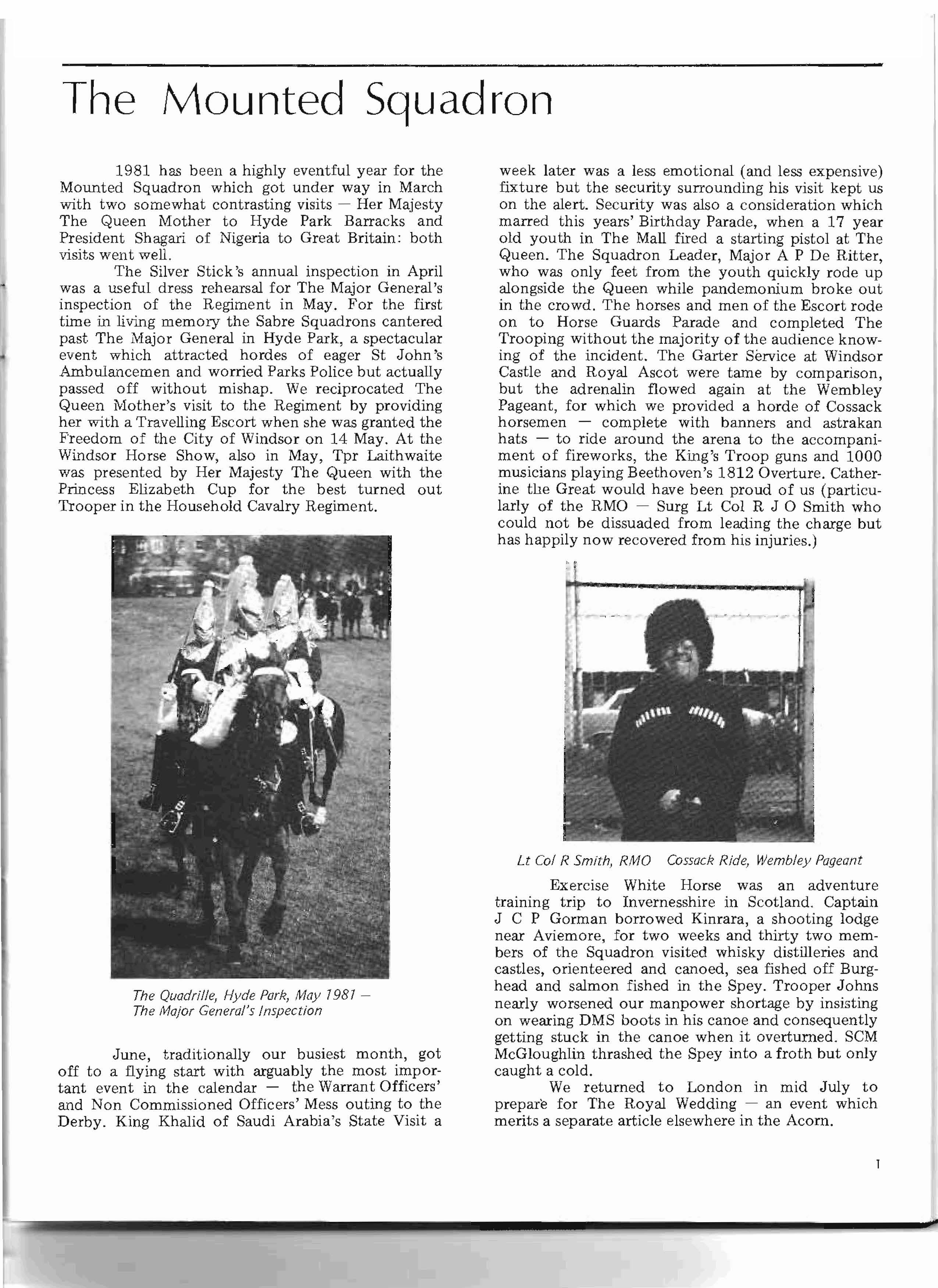
June, traditionally our busiest month, got off to a flying start with arguably the most important event in the calendar - the Warrant Officers' and Non Commissioned Officers' Mess outing to the Derby. King Khalid of Saudi Arabia's State Visit a
week later was a less emotional (and less expensive) fixture but the security surrounding his visit kept us on the alert. Security was also a consideration which marred this years' Birthday Parade, when a 17 year old youth in The Mall fired a starting pistol at The Queen. The Squadron Leader, Major A P De Ritter, who was only feet from the youth quickly rode up alongside the Queen while pandemonium broke out in the crowd. The horses and men of the Escort rode on to Horse Guards Parade and completed The Trooping without the majority of the audience knowing of the incident. The Garter Service at Windsor Castle and Royal Ascot were tame by comparison, but the adrenalin flowed again at the Wembley Pageant, for which we provided a horde of Cossack horsemen - complete with banners and astrakan hats - to ride around the arena to the accompaniment of fireworks, the King's Troop guns and 1000 musicians playing Beethoven's 1812 Overture. Catherine tIle Great would have been proud of us (particularly of the RMO - Surg Lt Col RJ0 Smith who could not be dissuaded from leading the charge but has happily now recovered from his injuries.)
Exercise White Horse was an adventure training trip to Invernesshire in Scotland. Captain J C P Gorman borrowed Kinrara, a shooting lodge near Aviemore, for two weeks and thirty two members of the Squadron visited whisky distilleries and castles, orienteered and canoed, sea fished off Burghead and salmon fished in the Spey. Trooper Johns nearly worsened our manpower shortage by insisting on wearing DMS boots in his canoe and consequently getting stuck in the canoe when it overturned. SCM McGloughlin thrashed the Spey into a froth but only caught a cold.
We returned to London in mid July to prepare for The Royal Wedding - an event which merits a separate article elsewhere in the Acorn.
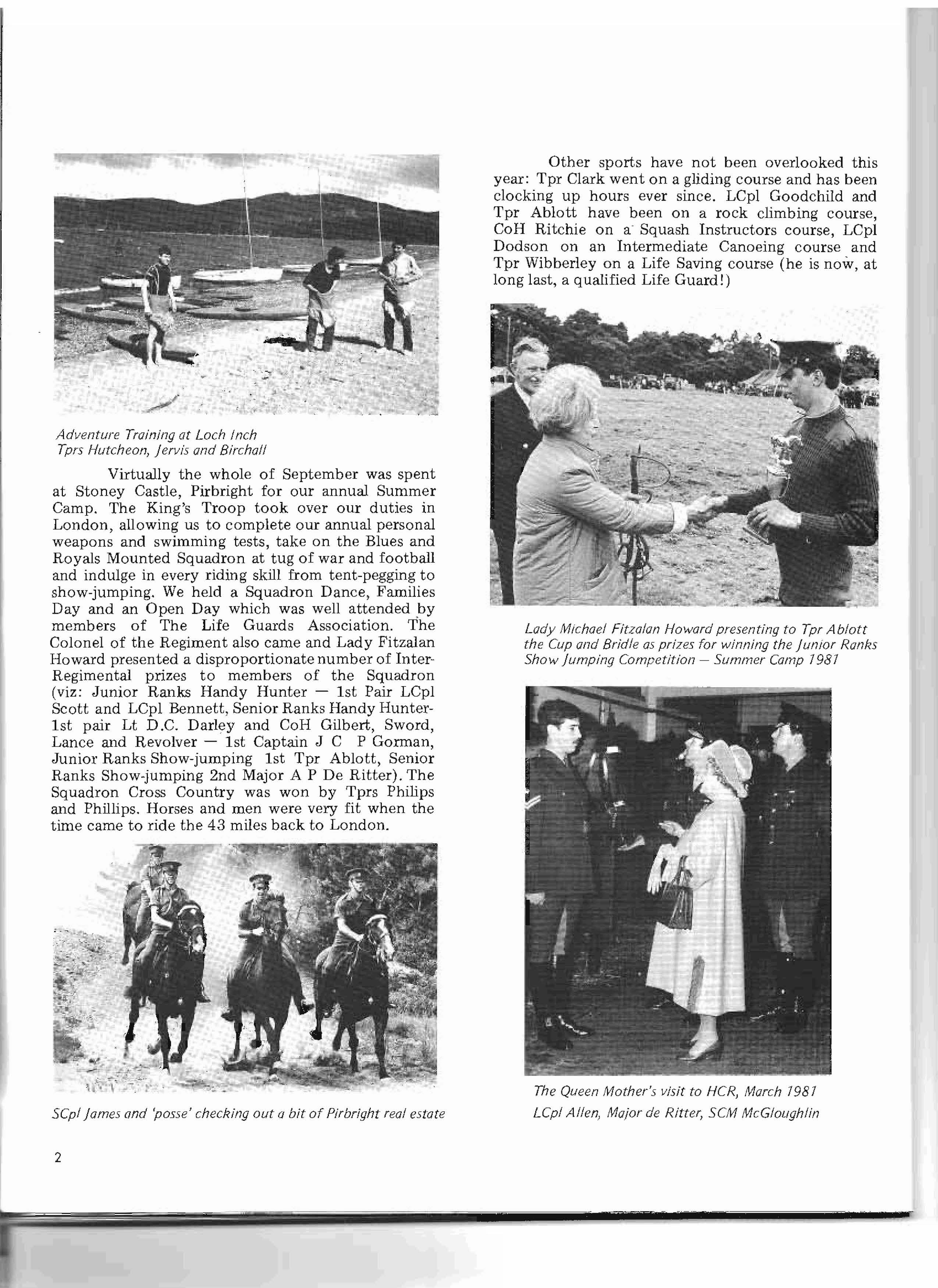
Adventure Training at Loch Inch Tprs Hutcheon, jervis and Birchall
Virtually the whole of September was spent at Stoney Castle, Pirbright for our annual Summer Camp. The King's Troop took over our duties in London, allowing us to complete our annual personal weapons and swimming tests, take on the Blues and Royals Mounted Squadron at tug of war and football and indulge in every riding skill from tent-pegging to show-jumping. We held a Squadron Dance, Families Day and an Open Day which was well attended by members of The Life Guards Association. The Colonel of the Regiment also came and Lady Fitzalan Howard presented a disproportionate number of InterRegimental prizes to members of the Squadron (viz: Junior Ranks Handy Hunter - 1st Pair LCpl Scott and LCpl Bennett, Senior Ranks Handy Hunter1st pair Lt D.C. Darley and CoH Gilbert, Sword, Lance and Revolver - 1st Captain J C P Gorman, Junior Ranks Show-jumping 1st Tpr Ablott, Senior Ranks Show-jumping 2nd Major A P De Ritter). The Squadron Cross Country was won by Tprs Philips and Phillips. Horses and men were very fit when the time came to ride the 43 miles back to London.
Other sports have not been overlooked this year: Tpr Clark went on a gliding course and has been clocking up hours ever since. LCpl Goodchild and Tpr Ablott have been on a rock climbing course, CoH Ritchie on a Squash Instructors course, LCpl Dodson on an Intermediate Canoeing course and Tpr Wibberley on a Life Saving course (he is now, at long last, a qualified Life Guard!)
LCpl Meredith, Tprs Lawes and Wintpn have completed a basic parachuting course. Tprs Terry, Slade, Convery, Wibberley, Roe, Rettallick and LCoH Shipway represented the Regimental Swimming Team and got into the Eastern District Finals at Colchester. The Squadron is sending horses and men out regularly with the Windsor Forest Bloodhounds and the RMAS Drag Hunt, and 3 Officers and 9 men of the Squadron took part in the Army Hunter Trials at Larkhill. The Squadron Leader and SCM McKie (and Captain A T Varley and CoH Sanderson from Melton) have all been eventing successfully and LCpl Allen has started a very popular clay pigeon shooting club which fires a great many cartridges but saves money by using the same clays over and over.
On a more international note Captain Gonnan (having claimed detailed knowledge of certain quarters of Bangkok) was appointed Equerry to His Highness the Crown Prince of Thailand for his recent visit to England, and Tprs Hughes and Baker served an ex officio attachment to the French Foreign Legion in Marseilles.
The manpower situation is slowly improving with 6 recruit rides currently in progress but volunteers from The Life Guards in Germany are particularly welcome (and remember, there is no restriction on hoof mileage at Knightsbridge). We have said goodbye to Lts Paske and Knipe and SCM McGoughlin and welcome Lts Marlow-Thomas and Darley and SCM McKie in their places.
Since our return from Summer Camp we have been busy getting the hunters for Melton fit and
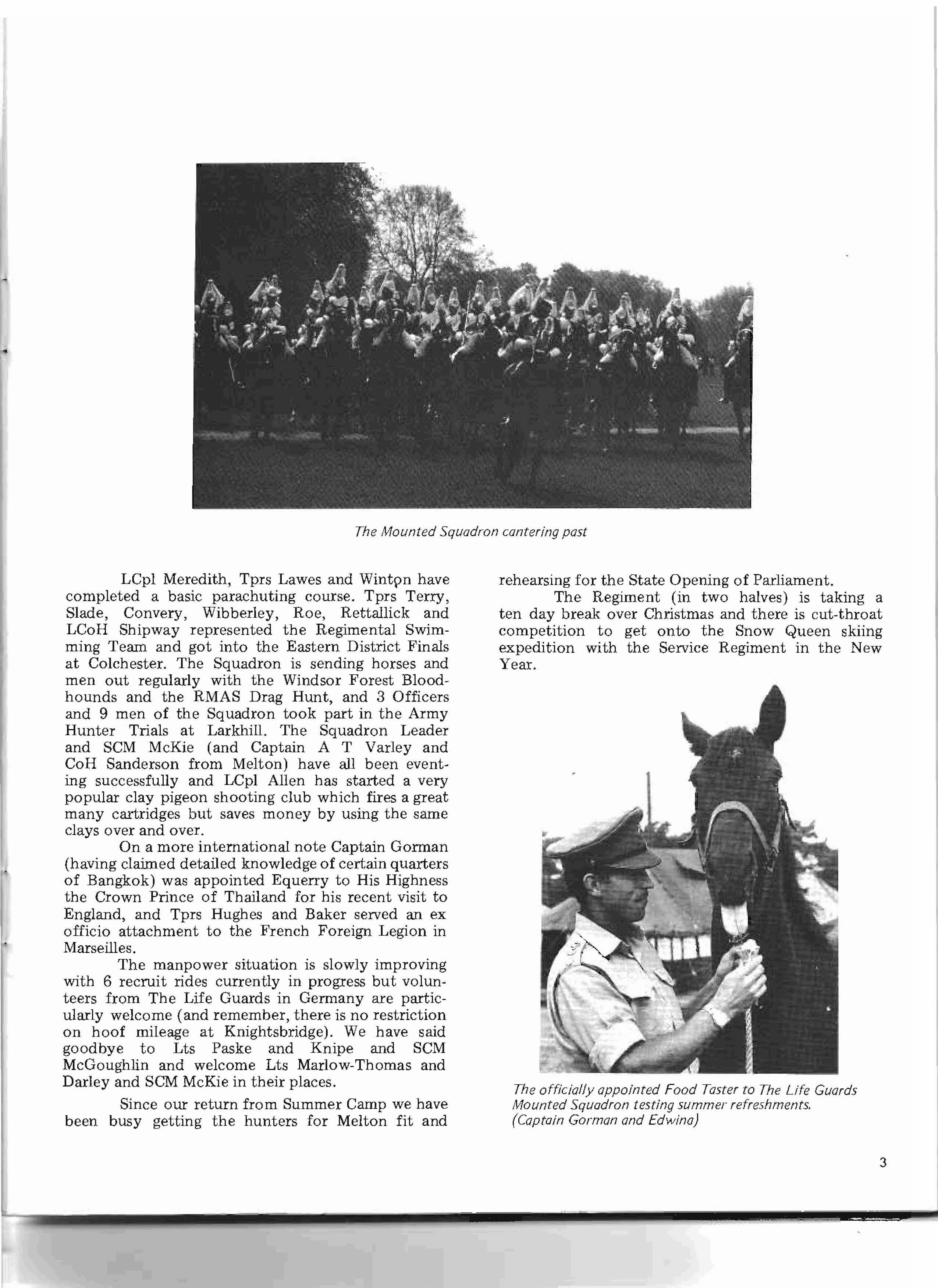
rehearsing for the State Opening of Parliament. The Regiment (in two halves) is taking a ten day break over Christmas and there is cut-throat competition to get onto the Snow Queen skiing expedition with the Service Regiment in the New Year.
After the busy Winter and Spring months of !.al trade training, external courses, and Site and the bonus of an unexpected three ;;: adventure training period, a very fit and we:'" _e.sted A Squadron once again donned uni: checked and started up tanks, in preparalor the exercise training period. The cycle _uts changed at an appropriate moment for Squadron. Major D' Ambrumenil departed from Squadron on posting to Hong Kong and we _ him and his family a happy and successful :-._, He was replaced by Major Bayley who was _., =refore in a good position to start the training ess with the Squadron.
While the majority of the Regiment was basking on its R&R in Canada, A Squadron :uo' the familiar route to the local Stapel Training _' e in August to refresh its memory on the basic :-:- wand troop drills within a scenario based on :::: Covering Force Battle. The period was an excel_ practice in diplomacy if nothing else, with an 'e British Battle Group and seemingly the ::::e.j rity of the German Army, all trying to train with objectives in mind, on an area with very 'ted space. The week was undoubtedly a success ich augured well for the coming months, and _ ed with a very worthwhile demonstration on _;BC decontamination drills performed by CoH ,--'ck's 1 Troop, who were fortunate in having _ew theatrical stars such as LCoH Rigby and Tprs - orwell and Appleby who left nothing to the imagin--:-::: n,
A Squadron enhanced its reputation as an :.;: ependant Squadron still further by being attached :0 the 1 RWF Battle Group for the remaining warm'0 exercises for Exercise Certain Encounter, and ="entually the main exercise itself. The formation, l'0 _sisting of 1 R WF and C Squadron QOH, was very . uch the old team as it had existed in Canada the :;-ear before, Individual SOP s and personalities were on the whole, familiar. Undoubtedly, ai-er the initial phase of the main exercise during -' e first three or four days, the 1 RWF Battle Group, d therefore A Squadron, was in Reserve for a lot of the time, and did not perhaps enjoy the continuous excitement as the remainder of the Regiment seemed : . However there were a number of humorous and exciting moments during the period. Not least perhaps the Squadron carrying out a planned advance over some very steep and wooded terrain, found ater to be undefended as it was thought by the opposition to be impassable to tanks. This demonstrated good map reading by tank commanders in ,ery difficult country, as well as some good individual vehicle commanding and some excellent tank driving. It showed also "dash" still has its place in the tactics books.
The area will certainly be remembered for its outstanding beauty and the friendliness of the majority of the German people, who have in recent history, experienced certain forces of the Warsaw Pact in their Valley. It must not be forgotten that the Squadron was able to enjoy its success because of very few mechanical problems, thanks mainly to the back-up supplied by SSgt Goodwin and the Squadron LAD team. The Golden Spanner Award, presented by the Squadron Leader to the Troop with the least REME assessed mechanical problems, was won by 1 Troop.
The exercise period for 1981 having ended, the Squadron then threw itself in to the rigours of gunnery training and vehicle preparation in readiness for Hohne firing in November. This was no easy task with the tanks looking externally a bit worse for wear at the end of a very busy exercise year, and knowing how the Gunnery World likes to view any vehicle gracing its firing points, However the Squadron is fortunate in having an abundance of gunnery expertise, and after a thorough training programme for the crews, looks forward to Hohne with confidence.
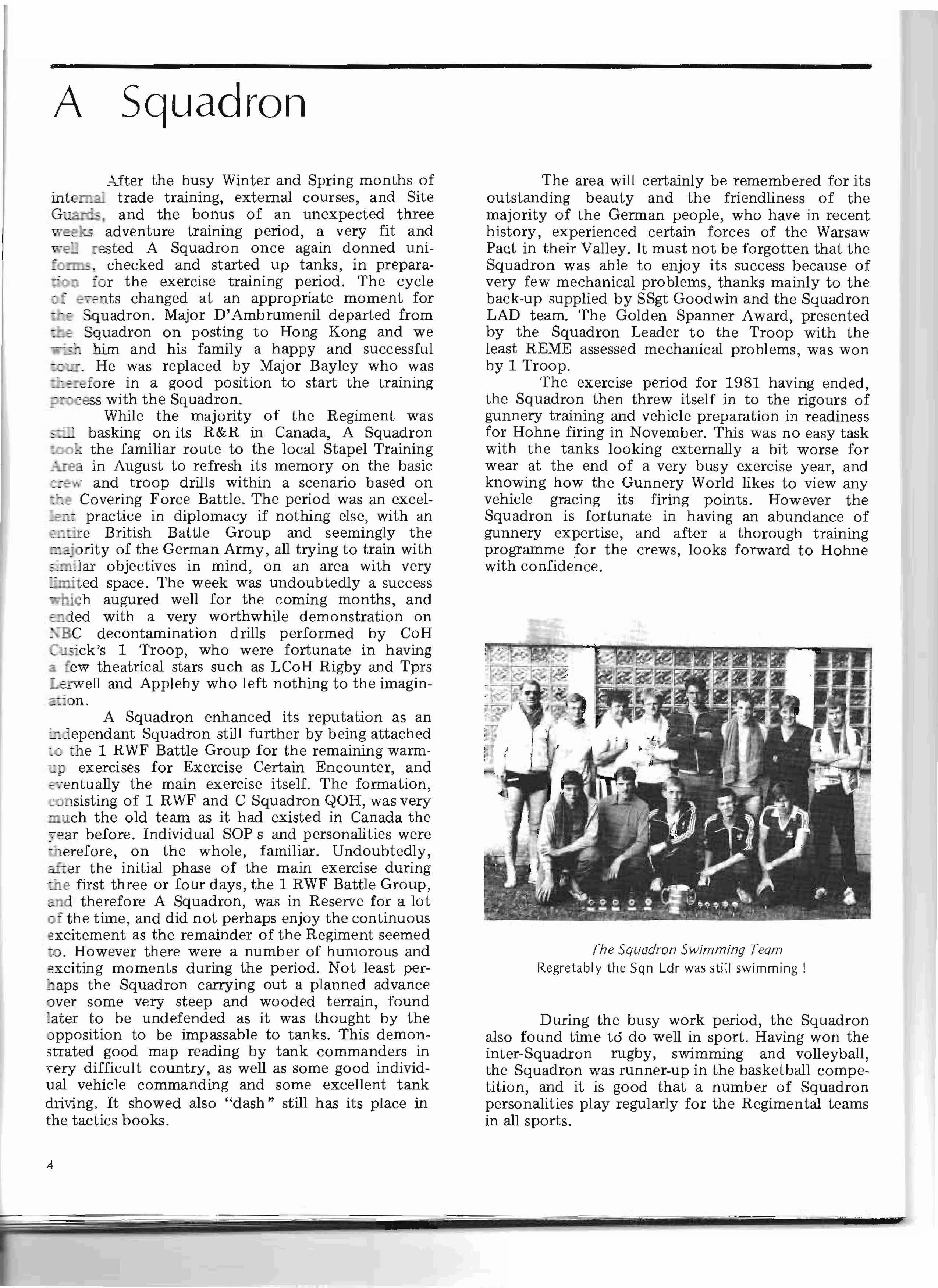
The Squadron SWimming Team Regretably the Sqn Ldr was still swimming!
During the busy work period, the Squadron also found time to do well in sport, Having won the inter-Squadron rugby, swimming and volleyball, the Squadron was runner-up in the basketball competition, and it is good that a number of Squadron personalities play regularly for the Regimental teams in all sports,
B Squadron, like everyone else in the Regiment have had a full year. We have, for six months been part of the 1st Royal Regiment of Fusiliers Battle Group and have only recently come back under the eagle eye of Regimental Headquarters.
Last winter saw the annual period of trade training interspersed with a number of visits to such places as RAF Laarbruch and Berlin, where Corporal Major Slater has a contract to provide Life Guard arena parties to German National equestrian events. In fact over the past twelve months a large number of the Squadron have managed to find their way to Berlin, two arena parties under the Corporal Major, and a large troop under 2Lt Faulkner and CoH Read went with C Sqn to relieve the 4/7 DG for their annual firing and exercise period on Soltau. Everyone who has been has enjoyed it thoroughly and came back with stories of a way of life very different to Detmold.
Also during the winter, twenty five members of the Squadron attended Exercise Snow Queen at the Regimental hut in Bavaria. The aim of the exercise is to teach soldiers cross country and down hill skiing techniques. Despite a certain amount. of reluctance on the part of some of those who 'volunteered' to attend, they all returned having had a very worthwhile ten days in the snow. Some have already put their name down for this winter.
Also in December the Squadron had to produce a team for a Regimental Boxing competition. The team was organised by CoH Read and CoH Bunyan. After a great deal of hard work led by Lt Watson, we put up a creditable performance in the ring, particularly Tpr Broomfield who was a plete novice. It is interesting to note that the RegImental team that went on to box against the Royal Green Jackets later in the year was 40% B Squadron.
The first of May marked the start of our exercise year and found the Squadron on Soltau
training area attached to 1 RRF, for the first phase of our preparation for BATUS. The weather was perfect and we carried out troop and squadron training inside a permanent cloud of brown dust. Three and Four Troops had their first taste of being part of an Infantry combat team and we took on a platoon of Infantry. During this period we sadly saw the departure of the Squadron Leader, Major D'Oyly, who left to take over as Regimental Second in Command. Major T. J. Earl hot from the Combat Team Commanders Course to take over from him.
After a well earned three weeks block leave the Squadron returned to find the rest of the Regiment away at Soltau. Immediately we had to start preparing ourselves for firing at Hohne.
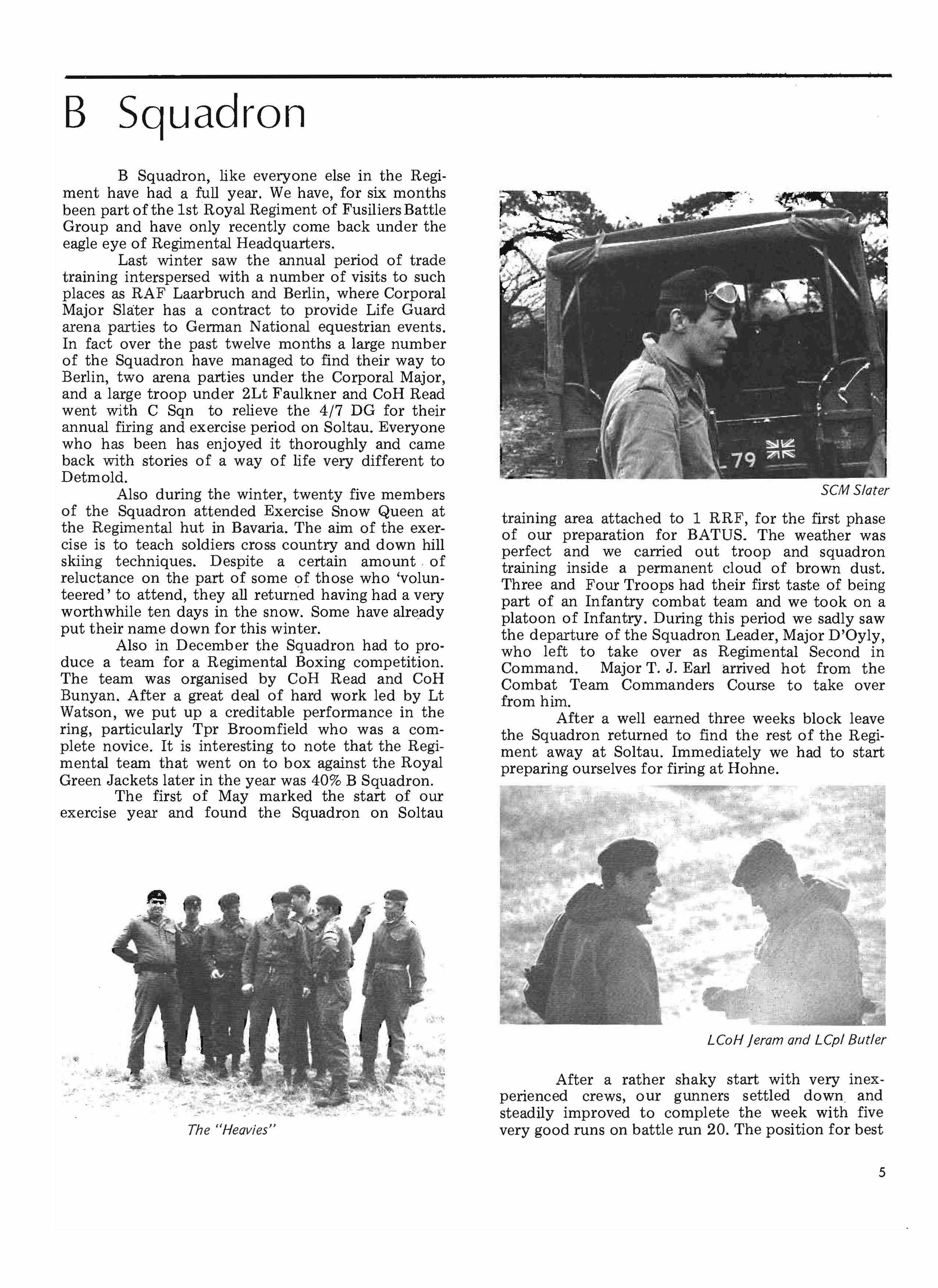
After a rather shaky start with very inexperienced crews, our gunners settled a,nd steadily improved to complete the week wIth fIve very good runs on battle run 20. The position for best
p was hotly contested between SHQ Troop and Troop. SHQ Troop won but Two Troop leader, Corporal Rennie, never believed it was by fair .s.
Once back in Detmold we had to complete _:..rr BFT (Basic Fitness Test) and APWT (Annual _ sonal Weapon Test). To do this we moved to - elager training area and must have been one of -" t few units to be working on the day of the Royal edding. However "Gunga Din ", the SQMC, excelled _::mself by producing a generator and television in e field. The Squadron returned home in time to ·cipate in the numerous celebration parties.
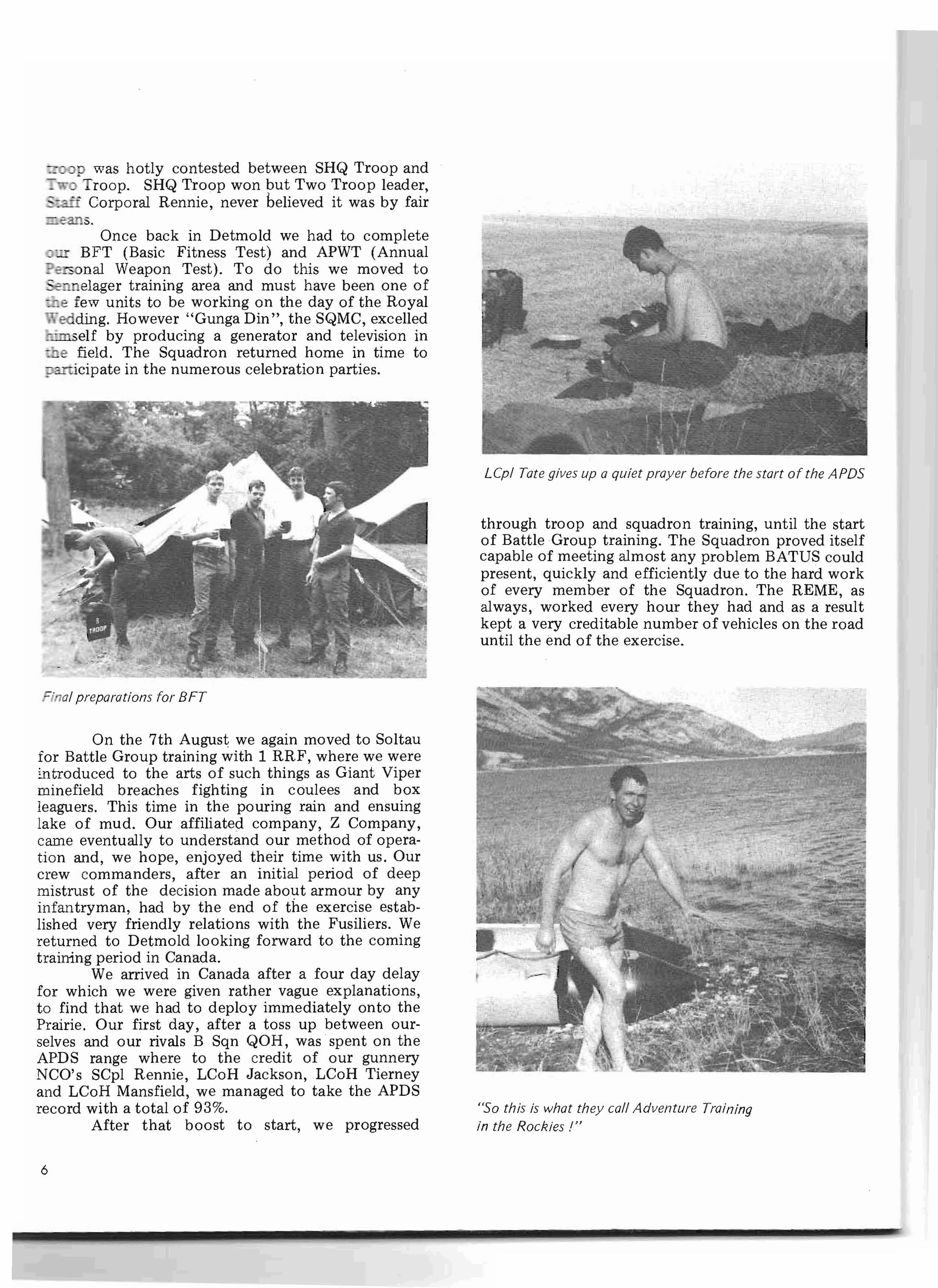
through troop and squadron training, until the start of Battle Group training. The Squadron proved itself capable of meeting almost any problem BATUS could present, quickly and efficiently due to the hard work of every member of the Squadron. The REME, as always, worked every hour they had and as a result kept a very creditable number of vehicles on the road until the end of the exercise.
On the 7th August we again moved to Soltau ror Battle Group training with 1 RRF, where we were introduced to the arts of such things as Giant Viper minefield breaches fighting in coulees and box leaguers. This time in the pouring rain and ensuing lake of mud. Our affiliated company, Z Company, came eventually to understand our method of operation and, we hope, enjoyed their time with us. Our crew commanders, after an initial period of deep mistrust of the decision made about armour by any infantryman, had by the end of the exercise established very friendly relations with the Fusiliers. We returned to Detmold looking forward to the coming training period in Canada.
We arrived in Canada after a four day delay for which we were given rather vague explanations, to find that we had to deploy immediately onto the Prairie. Our first day, after a toss up between ourselves and our rivals B Sqn QOH, was spent on the APDS range where to the credit of our gunnery NCO's SCpl Rennie, LCoH Jackson, LCoH Tierney and LCoH Mansfield, we managed to take the APDS record with a total of 93%.
After that boost to start, we progressed
LCpl Layzell and The Tug of War Team
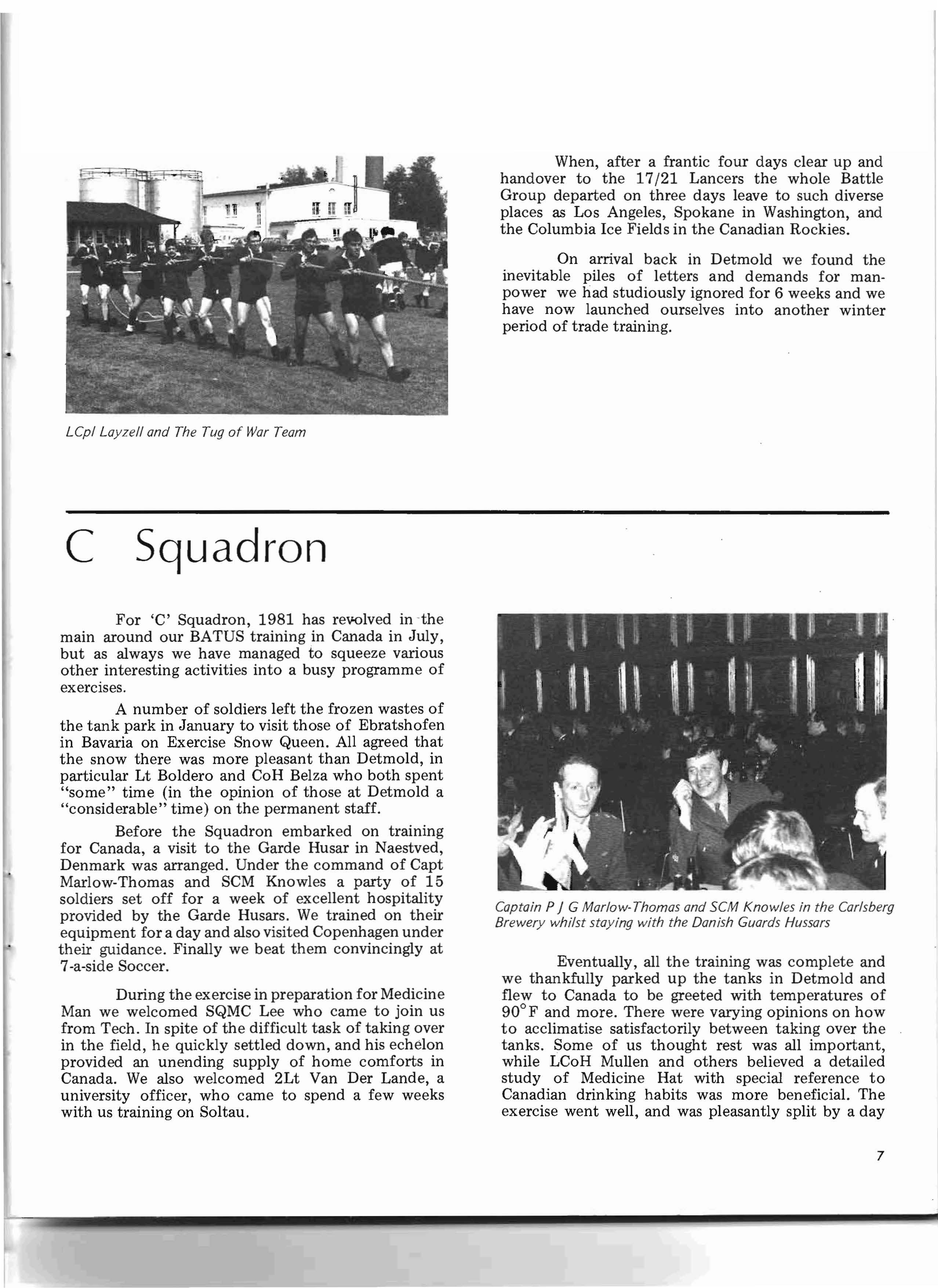
For 'C' Squadron, 1981 has rewlved in -the main around our BATUS training in Canada in July, but as always we have managed to squeeze various other interesting activities into a busy programme of exercises.
A number of soldiers left the frozen wastes of the tank park in January to visit those of Ebratshofen in Bavaria on Exercise Snow Queen. All agreed that the snow there was more pleasant than Detmold, in particular Lt Boldero and CoH Belza who both spent "some" time (in the opinion of those at Detmold a "considerable" time) on the permanent staff.
Before the Squadron embarked on training for Canada, a visit to the Garde Husar in Naestved, Denmark was arranged. Under the command of Capt Marl ow- Thomas and SCM Knowles a party of 15 soldiers set off for a week of excellent hospitality provided by the Garde Husars. We trained on their equipment for a day and also visited Copenhagen under their guidance. Finally we beat them convincingly at 7-a-side Soccer.
During the exercise in preparation for Medicine Man we welcomed SQMC Lee who came to join us from Tech. In spite of the difficult task of taking over in the field, he quickly settled down, and his echelon provided an unending supply of home comforts in Canada. We also welcomed 2Lt Van Der Lande, a university officer, who came to spend a few weeks with us training on Soltau.
When, after a frantic four days clear up and handover to the 17/21 Lancers the whole Battle Group departed on three days leave to such diverse places as Los Angeles, Spokane in Washington, and the Columbia Ice Fields in the Canadian Rockies.
On arrival back in Detmold we found the inevitable piles of letters and demands for manpower we had studiously ignored for 6 weeks and we have now launched ourselves into another winter period of trade training.
Eventually, all the training was complete and we thankfully parked up the tanks in Detmold and flew to Canada to be greeted with temperatures of 90° F and more. There were varying opinions on how to acclimatise satisfactorily between taking over the tanks. Some of us thought rest was all important, while LCoH Mullen and others believed a detailed study of Medicine Hat with special reference to Canadian drinking habits was more beneficial. The exercise went well, and was pleasantly split by a day
to watch the Medicine Hat Stampede. After three days hard work to hand back the tanks, we all dispersed in various directions for four days of well earned R&R. Ranching and fishing were popular, but the SCM maintains he had the most interesting time in a place called Shangri-la (the location of which he says must remain secret).
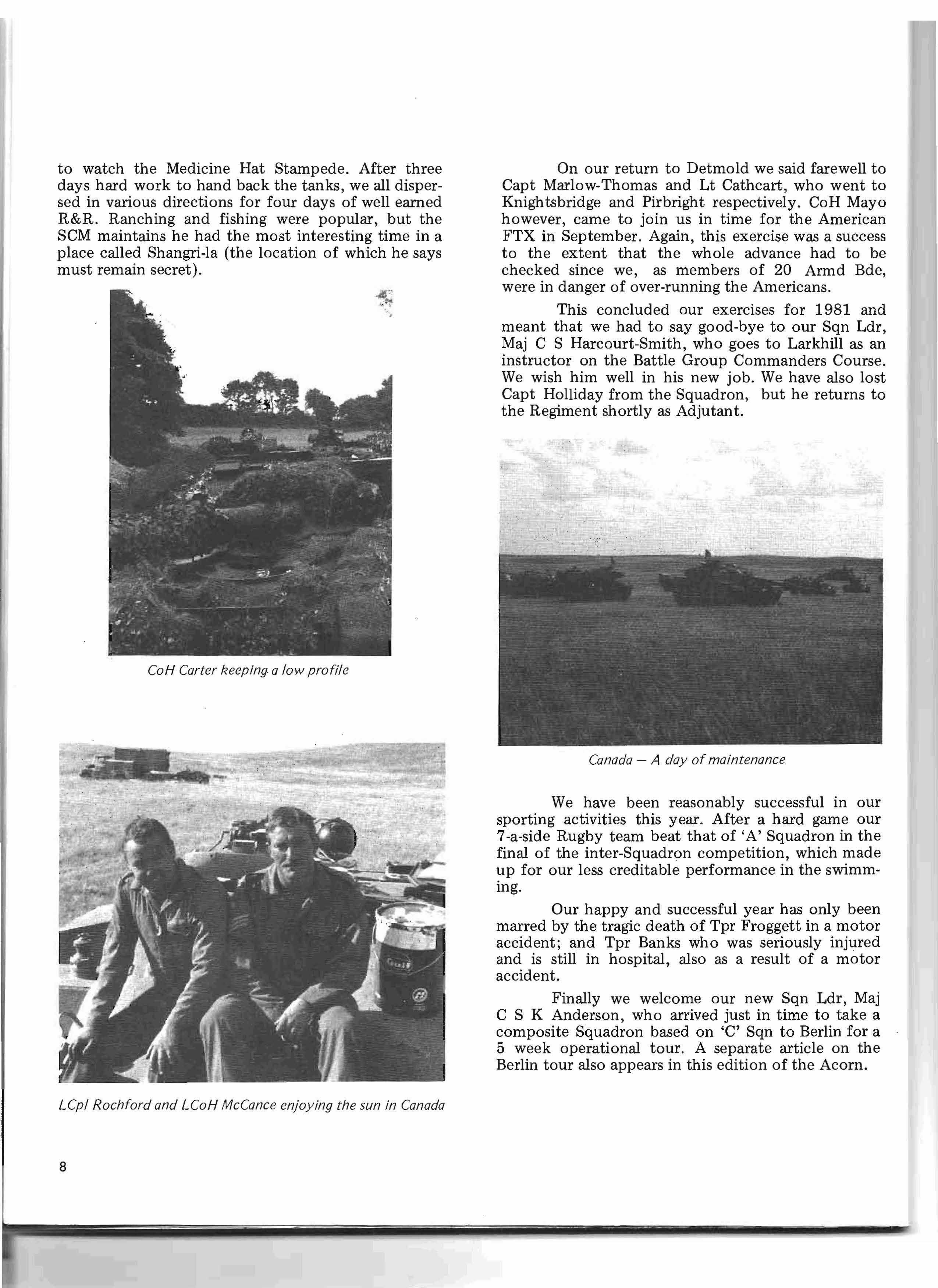
On our return to Detmold we said farewell to Capt Marlow-Thomas and Lt Cathcart, who went to Knightsbridge and Pirbright respectively. CoH Mayo however, came to join us in time for the American FTX in September. Again, this exercise was a success to the extent that the whole advance had to be checked since we, as members of 20 Armd Bde, were in danger of over-running the Americans. This concluded our exercises for 1981 and meant that we had to say good-bye to our Sqn Ldr, Maj C S Harcourt-Smith, who goes to Larkhill as an instructor on the Battle Group Commanders Course. We wish him well in his new job. We have also lost Capt Holliday from the Squadron, but he returns to the Regiment shortly as Adjutant.
We have been reasonably successful in our sporting activities this year. After a hard game our 7 -a-side Rugby team beat that of 'A' Squadron in the final of the inter-Squadron competition, which made up for our less creditable performance in the swimming.
Our happy and successful year has only been marred by the tragic death of Tpr Froggett in a motor accident; and Tpr Banks who was seriously injured and is still in hospital, also as a result of a motor accident.
Finally we welcome our new Sqn Ldr, Maj C S K Anderson, who arrived just in time to take a composite Squadron based on 'C' Sqn to Berlin for a 5 week operational tour. A separate article on the Berlin tour also appears in this edition of the Acorn.
1981 was the year of shortage of fuel, spares and track mileage. Exercises were to have been curtailed and time would hang heavily upon our heads. Did it do so? Did it
Actually the cutbacks, or moritorium to use the equivalent word in veiled speech, did have one effect on D Squadron: we were warned off to go in November 1980 to add a little styleto Berlin while the resident Squadron went to train elsewhere. This was at the last minute cancelled but we did get there in the end if only for a long weekend with the Grenadier Guards. This involved a journey by the British military train - much the most interesting way of travelling down the Berlin Corridor. At the frontier a Russian soldier was determined on exchanging his buff belt with something from Major Ellery, the Squadron Leader - he offered the Squadron Corporal Major's forage cap to the mutual dissatisfaction of both parties. A copy of Playboy magazine might have been more successful.
The extra time afforded by the cancelled Berlin tour enabled Corporal Major Kelly to run a Squadron Riding Course. This was full time for a month and all who took part achieved a very satisfactory standard and as a direct result 3 soldiers have already volunteered and been posted to Knightsbridge. CoH Howard, Trooper Bridges and Trooper Brown 19. Several more will go after our Northern Ireland tour and many have now come from the Mounted Regiment and quickly caught up on their armoured trades. Among them are LCoH McDermott, LCoH Hearn and LCpl O'Donnell proving that the interchange really can be made to work and that one is not a 'proper' Household Cavalryman until both sides of the Regiment have been mastered.
To continue with the equestrian activities, Corporal Major Kelly has successfully entered a number of hunter trials and events on his own horse winning in October the Rhine Army One Day Event. The Subalterns: Mr Soames, Mr Bell and Mr Fraser help in the running of the Weser Vale Hunt; Mr Bell being also the Huntsman.
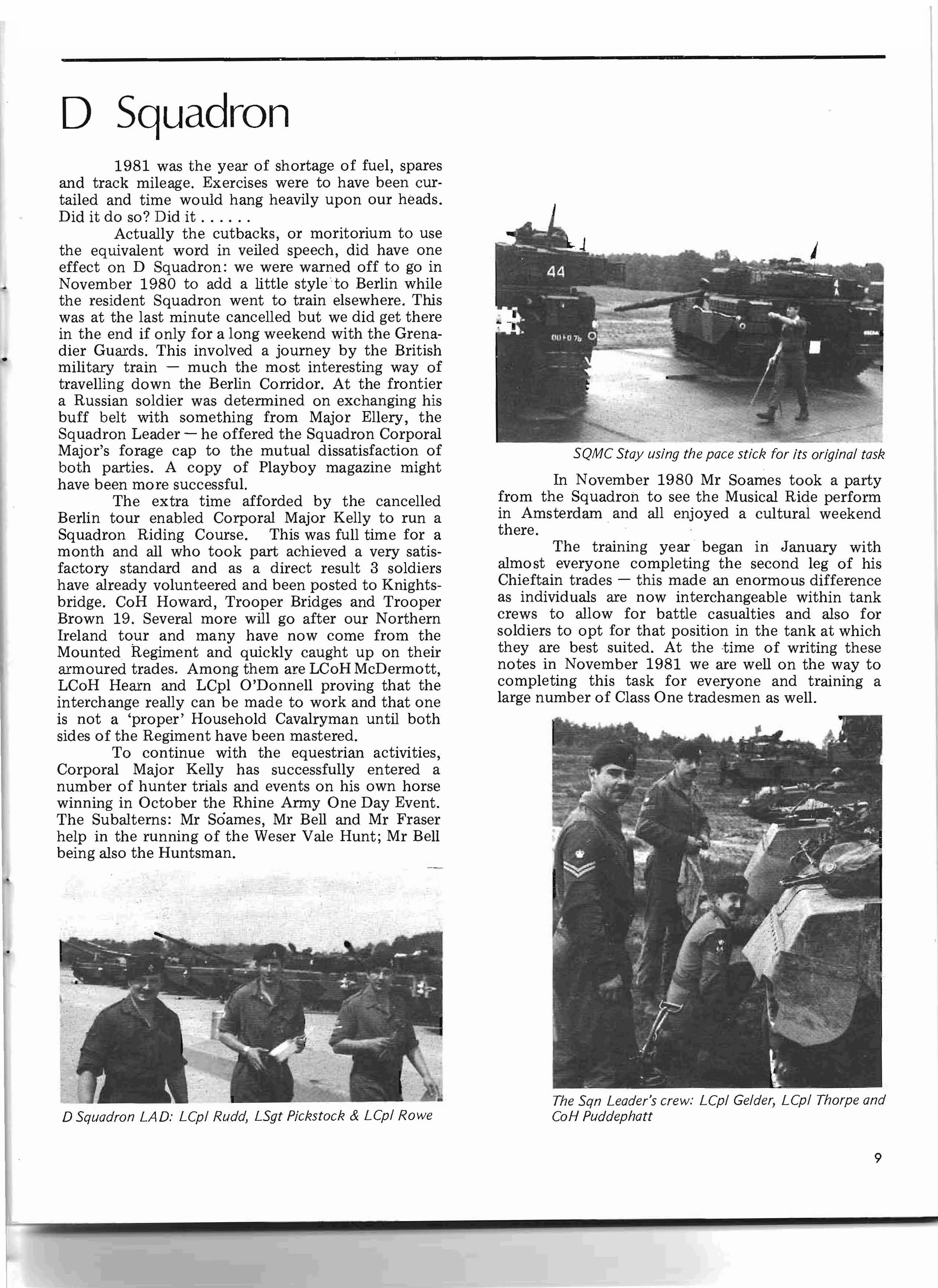
SQMC Stay using the pace stick for its original task
In November 1980 Mr Soames took a party from the Squadron to see the Musical Ride perform in Amsterdam and all enjoyed a cultural weekend there.
The training year began in January with almost everyone completing the second leg of his Chieftain trades - this made an enormous difference as individuals are now interchangeable within tank crews to allow for battle casualties and also for soldiers to opt for that position in the tank at which they are best suited. At the -time of writing these notes in November 1981 we are well on the way to completing this task for everyone and training a large number of Class One tradesmen as well.
In April we were able to get the whole Squadron together in a tented camp at Sennelager for a week's small arms firing culminating in a march back over the Teutoburger Wald - some 25 miles. Take note anyone who thinks the modern Army has gone soft.
Later in the month we set off to Soltau for Troop and Squadron training. This stage of training is always too short in ,BAOR although it must be said that the standard achieved at the Troop tests, won by 3 Troop (Mr Soames and CoH Jones), was very satisfactory. Not so satisfactory in some people's eyes was the time spent on combat survival, in which every member of the Squadron was required to kill, gut and consume a chicken. It Was, however, a good introduction to those who took part in Exercise Ludwig's Lair won by LCoH Hickman and a patrol competition consisting of daily 50 kilometre marches entered by CoH Puddephatt and LCpl Valentine.
The Ministry of Defence in their wisdom cancelled our Annual Firing and instead we went to Hohne for only a week for a series of mainly battle runs. This was a pity because while the good gunners improved, the less experienced ones lacked the necessary individual coaching, only possible on a static firing point, to help them to gain confidence. In spite of this a good report was written and all felt that the hard work put in by way of preparation had been worthwhile.
By now our thoughts were turning to the forthcoming month at the British Army Training Unit in Suffield (BATUS). This is a totally uninhabited area of prairie in Canada. What trees or vegetation there may have once been were erased by successive tests of new weapons and military manoeuvres. Nonetheless it offers unrivalled opportunity for both fire and tactical movement with the whole Battle Group making full use of its military muscle.
Before going to BA TUS, lectures were given on the extreme weather conditions we should expect and the need to take plenty of salt to combat heat exhaustion and to drink at least a gallon of water a day. However the weather was little different to Detmold (you don't know what this is?: usually cold and always wet). Yes, it was the wettest and coldest summer in Canada since records began!
Notwithstanding this the Squadron shot well and moved aggressively and swiftly about the battlefield although it was dissappointing for some crews to have come so far to inherit particularly trouble-' some tanks ---:. it taught us to appreciate the ones we have in Detmold.
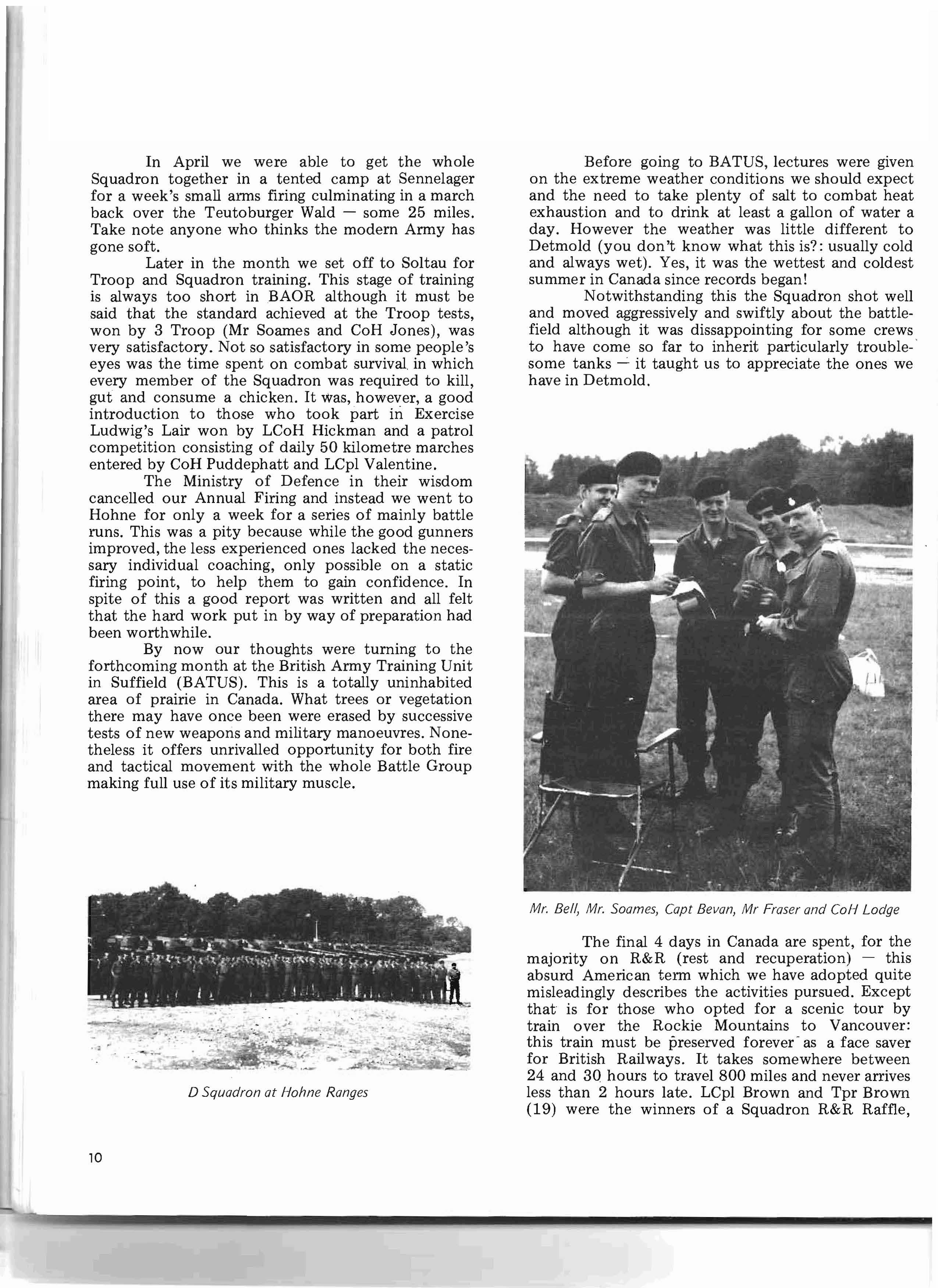
The final 4 days in Canada are spent, for the majority on R&R (rest and recuperation) - this absurd American term which we have adopted quite misleadingly describes the activities pursued. Except that is for those who opted for a scenic tour by train over the Rockie Mountains to Vancouver: this train must be preserved forever - as a face saver for British Railways. It takes somewhere between 24 and 30 hours to travel 800 miles and never arrives less than 2 hours late. LCpl Brown and Tpr Brown (19) were the winners of a Squadron R&R Raffle,
the prize for which was a trip, all found, to San Francisco. For reasons which are better catalogued elsewhere they only got as far as Calgary Airport and spent 4 days at the Holiday Inn Hotel. While the majority returned to Germany to prepare for Exercise Certain Encounter a dozen remained in Canada for Adventure training led by Mr Soames - this was undoubtedly a huge success. As a Squadron we have this year had time for little Troop Adventure Training like last year but practically every man has been away in smaller parties skiing, sailing, climbing, canoeing and even hang gliding.
Exercise Certain Encounter was a large exercise held south of Kassel in which we operated as the enemy. Being over entirely new country and against the American Forces it was something of an adventure for us all particularly the Junior N onCommissioned Officers of the Squadron who almost to a man found themselves as tank commanders for the first time while the more senior ones went off for instructors and upgrading courses.
The exercise was well documented in the British press and it demonstrated one aspect clearly: that there is no substitute for thoroughly rehearsed battle procedure, good backup from the LAD and Echelon and a high standard of individual training. It was a great success and a fitting end to a very busy training season.
It only remained for us to return to barracks and clean up our vehicles prior to going on 3 weeks leave. Before doing so D Squadron cleaned up all the prizes in the Inter Squadron Cross Country Running Competition again. The stars were Trooper McNeill who came second, Mr Fraser, LCpl Nicholson and Troopers Phillpott, Dennis, Smith 70, Hughes.
It has been a good year and with the Squadron now firmly established and well up to strength. It will, by the time you read these notes, be serving in the Emerald Isle adding another chapter to its broken history.
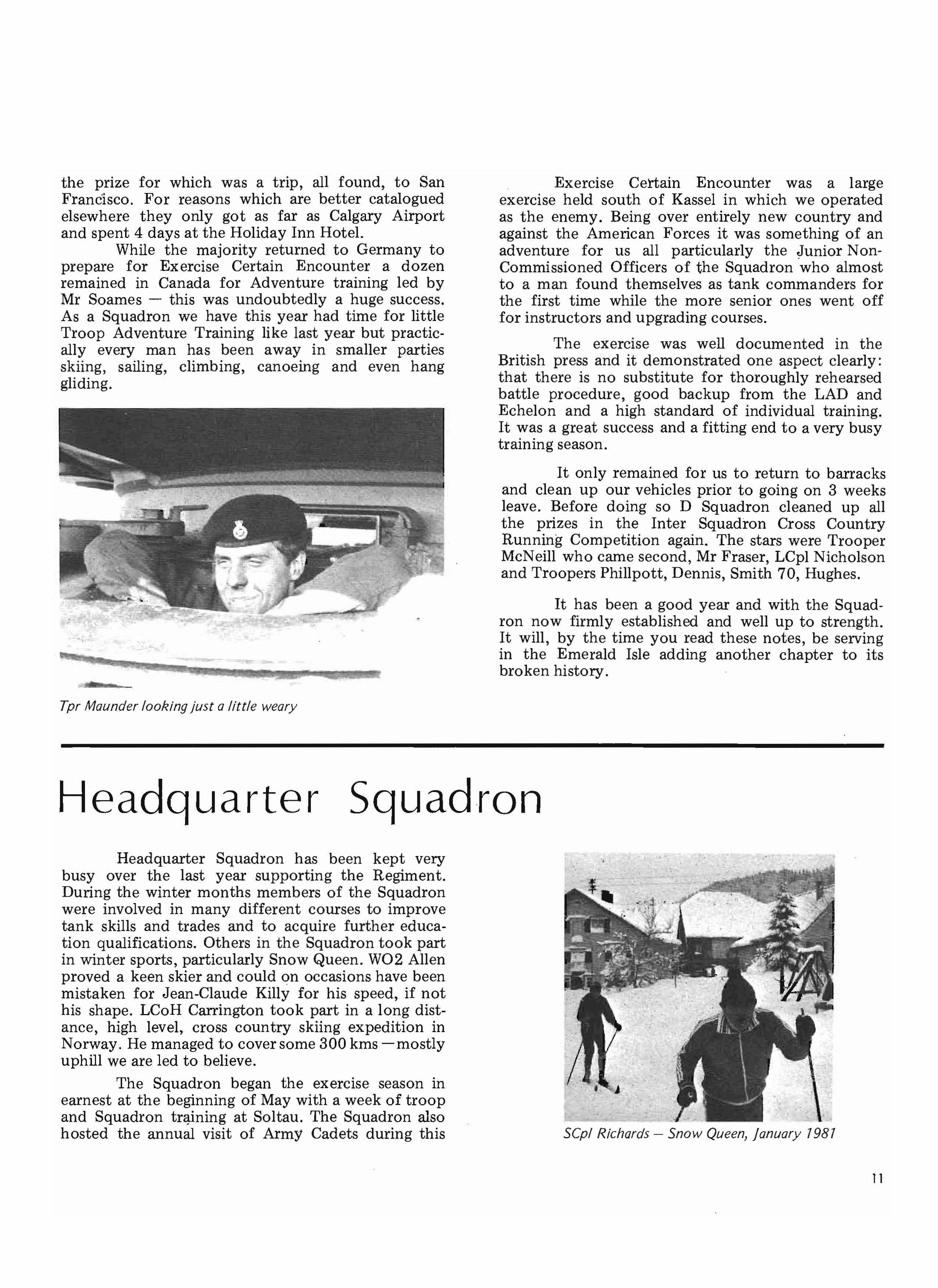
Tpr Maunder looking just a little weary
Headquarter Squadron has been kept very busy over the last year supporting the Regiment. During the winter months members of the Squadron were involved in many different courses to improve tank skills and trades and to acquire further education qualifications. Others in the Squadron took part in winter sports, particularly Snow Queen. W02 Allen proved a keen skier and could on occasions have been mistaken for Jean-Claude Killy for his speed, if not his shape. LCoH Carrington took part in a long distance, high level, cross country skiing expedition in Norway. He managed to cover some 300 kms - mostly uphill we are led to believe.
The Squadron began the exercise season in earnest at the beginning of May with a week of troop and Squadron at Soltau. The Squadron also hosted the annual visit of Army Cadets during this sepl Richards - Snow Queen, January 7987
period. The Gwent Army Cadet Force was soundly shepherded from place to place by LCpl Dunn, and LCoH Reed introduced the cadets to drill and weapon training which were thoroughly enjoyed much to everyone's surprise.
June saw the Squadron fully occupied with live firing at Hohne and a further period of exercise at Soltau, all in preparation for Canada. On this occasion SCpl Mills received the 'Oscar' for holding the most "acting" appointments at the same time. These included MTO, Stalwart Troop Leader and Squadron Corporal Major. A number of map-reading exercises took place and in order to save fuel these were done on foot. For some reason, not yet explained, the LAD were nearly always first home. The MTO, Lt Miles assisted by the Squadron Leader horrified members of D Squadron by producing 40 live chickens for their consumption as part of a lecture on survival. SQMC Milne provided the fowls. They were understood to have fallen or flown, off the back of a lorry.
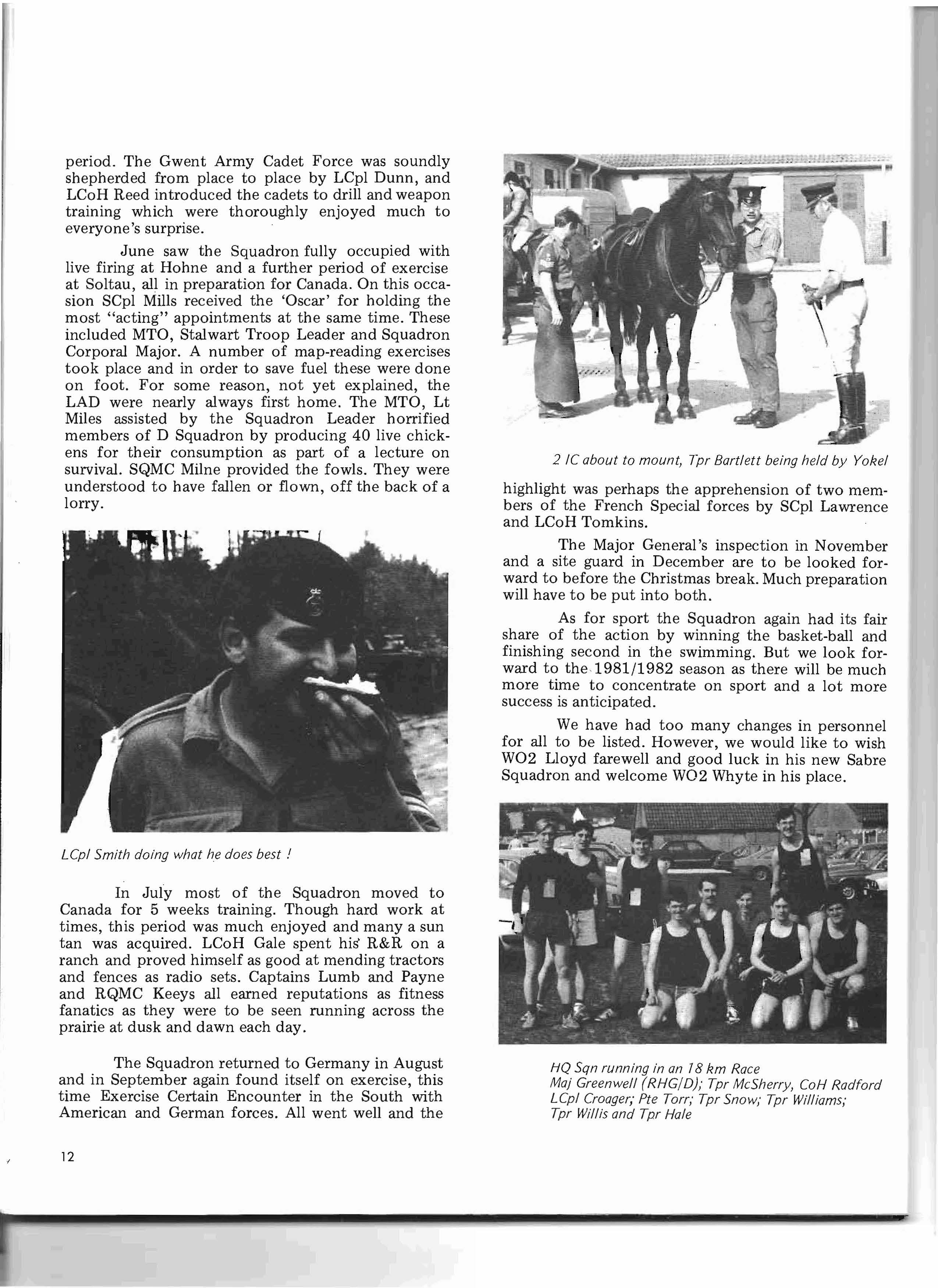
In July most of the Squadron moved to Canada for 5 weeks training. Though hard work at times, this period was much enjoyed and many a sun tan was acquired. LCoH Gale spent his' R&R on a ranch and proved himself as good at mending tractors and fences as radio sets. Captains Lumb and Payne and RQMC Keeys all earned reputations as fitness fanatics as they were to be seen running across the prairie at dusk and dawn each day.
The Squadron returned to Germany in August and in September again found itself on exercise, this time Exercise Certain Encounter in the South with American and German forces. All went well and the
highlight was perhaps the apprehension of two
bers of the French Special forces by SCpl Lawrence and LCoH Tomkins.
The Major General's inspection in November and a site guard in December are to be looked forward to before the Christmas break. Much preparation will have to be put into both.
As for sport the Squadron again had its fair share of the action by winning the basket-ball and finishing second in the swimming. But we look forward to the,1981/1982 season as there will be much more time to concentrate on sport and a lot more success is anticipated.
We have had too many changes in personnel for all to be listed. However, we would like to wish W02 Lloyd farewell and good luck in his new Sabre Squadron and welcome W02 Whyte in his place.
December. Brickhanging. This traditional revelry was enjoyed by all. Two subalterns were . ' as IS the custom, fastened together using a chain that once enjoined over one hundred sub machine guns. Discovering that the keys were lost, the EME immediately employed his technical brilliance and ordered the welder to fetch the oxy-acetylene cutting torch. It was pointed out by no lesser person than the ASM that this might in fact ignite their feet, and the day was saved by a pair of bolt croppers; whatever they are.
January. Christmas leave finished on 5 January and we began a period of preparation for the exercise season, and internal training. Many members of the LAD were away on courses and the remaining few operated in freezing conditions whilst interminable heating problems continued.
Towards the end of the month the LAD said goodbye to Lt Col and Mrs A B S H Gooch. A dinner party was arranged in their honour and all REME NCO s attended. The craftsmen also did their bit by waiting on. Riddell spilt the soup.
April. The Regiment, -and not surprisingly the LAD found themselves once again on Soltau's frozen wastes. To share our misery we had a company of the Royal Regiment of Fusiliers, whose fitter section was lead by S Sgt Roe. The visiting tradesmen soon found themselves heaping the same loving care and attention in the direction of Chieftain that us normal MBT bluebells are wont to do. Headquarters Squadron LAD also had its fair share of work on exercise. S SgtMoore, God bless him, put every smgle Ferret Scout Car off the road. He actually several potentially fatal accidents, as Cpl Major Kelly will no doubt verify, even though the move was not universally popular.
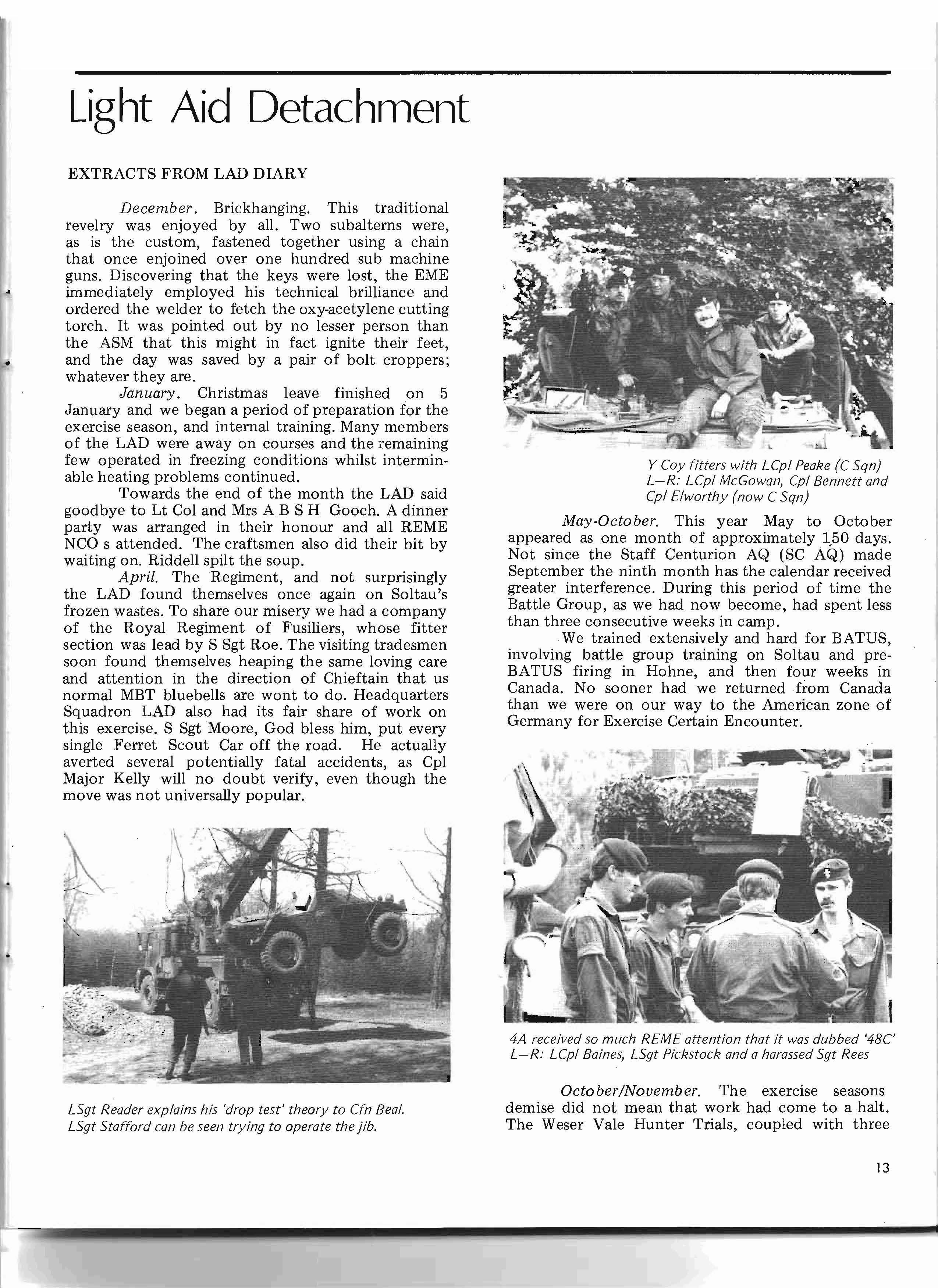
Y Coy fitters with LCpl Peake (C Sqn) L-R: LCpl McGowan, Cpl Bennett and Cpl Elworthy (now C Sqn)
May-October. This year May to October as one month of approximately 1.50 days. Not smce the Staff Centurion AQ (SC AQ) made September the ninth month has the calendar received greater interference. During this period of time the Battle Group, as we had now become, had spent less than three consecutive weeks in camp. We trained extensively and hard for BATUS involving battle group training on Soltau and pre: BATUS firing in Hohne, and then four weeks in Canada. No sooner had we returned from Canada than we were on our way to the American zone of Germany for Exercise Certain Encounter.
4A received so much REME attention that it was dubbed '48C L-R: LCpl Baines, LSgt Pickstock and a harassed Sgt Rees
October/November. The exercise seasons demise did not mean that work had come to a halt. The Weser Vale Hunter Trials, coupled with three
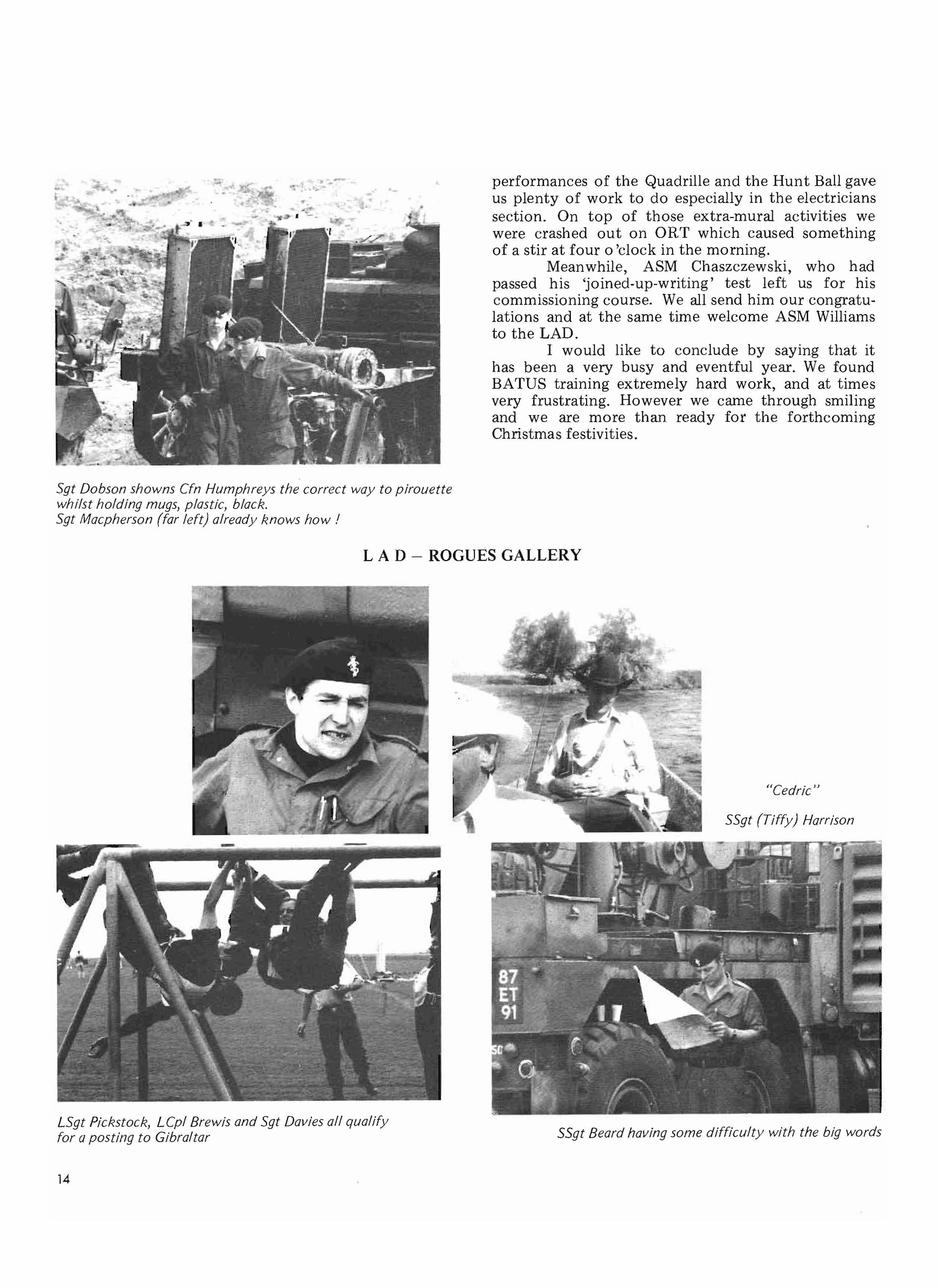
performances of the Quadrille and the Hunt Ball gave us plenty of work to do especially in the electricians section. On top of those extra-mural activities we were crashed out on ORT which caused something of a stir at four 0 'clock in the morning.
Meanwhile, ASM Chaszczewski, who had passed his 'joined-up-writing' test left us for his commissioning course. We all send him our congratulations and at the same time welcome ASM Williams to the LAD.
I would like to conclude by saying that it has been a very busy and eventful year. We found BATUS training extremely hard work, and at times very frustrating. However we came through smiling and we are more than ready for the forthcoming Christmas festivities.
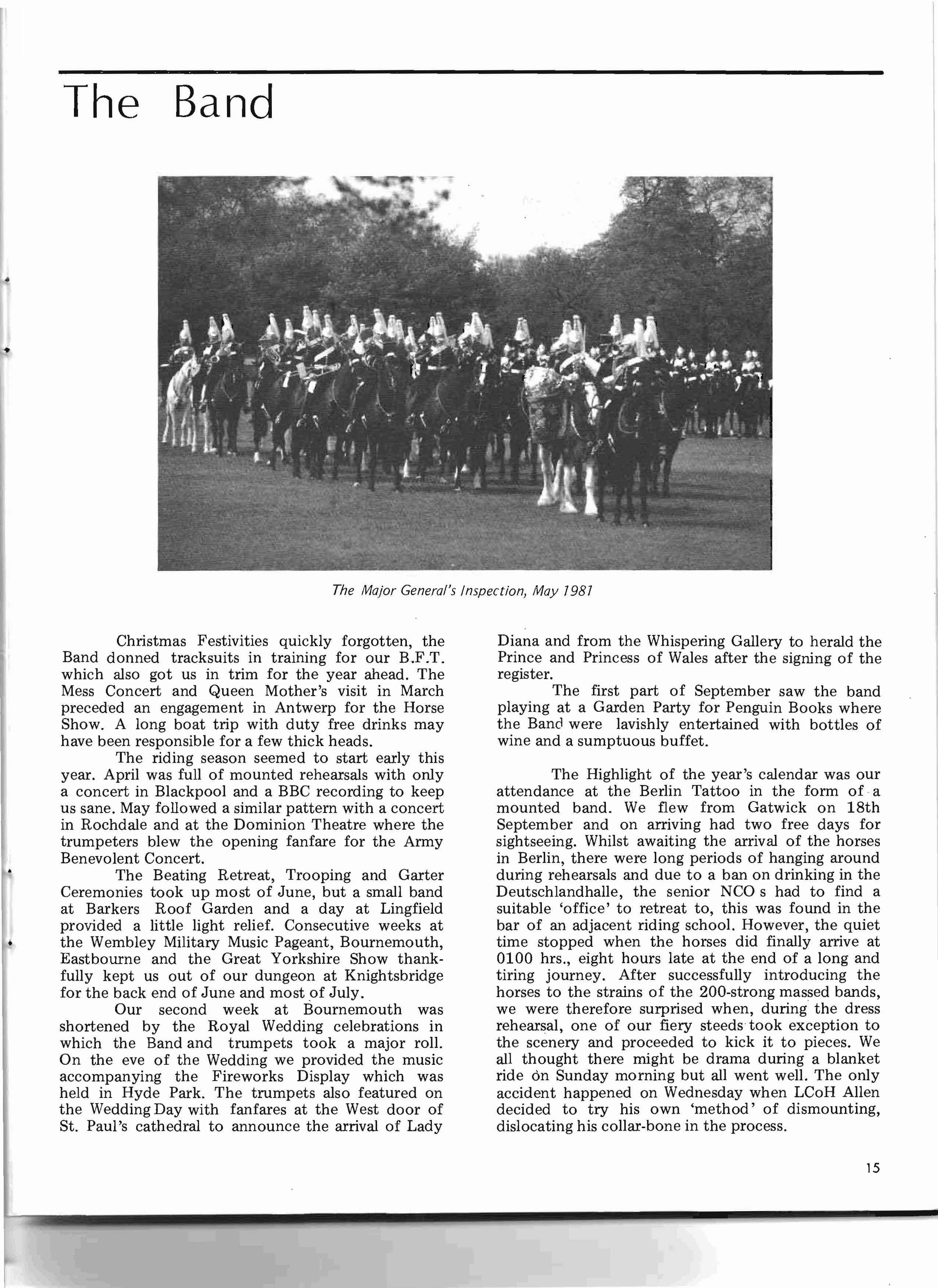
Christmas Festivities quickly forgotten, the Band donned tracksuits in training for our B.F.T. which also got us in trim for the year ahead. The Mess Concert and Queen Mother's visit in March preceded an engagement in Antwerp for the Horse Show. A long boat trip with duty free drinks may have been responsible for a few thick heads.
The riding season seemed to start early this year. April was full of mounted rehearsals with only a concert in Blackpool and a BBC recording to keep us sane. May followed a similar pattern with a concert in Rochdale and at the Dominion Theatre where the trumpeters blew the opening fanfare for the Army Benevolent Concert.
The Beating Retreat, Trooping and Garter Ceremonies took up most of June, but a small band at Barkers Roof Garden and a day at Lingfield provided a little light relief. Consecutive weeks at the Wembley Military Music Pageant, Bournemouth, Eastbourne and the Great Yorkshire Show thankfully kept us out of our dungeon at Knightsbridge for the back end of June and most of July.
Our second week at Bournemouth was shortened by the Royal Wedding celebrations in which the Band and trumpets took a major roll. On the eve of the Wedding we provided the music accompanying the Fireworks Display which was held in Hyde Park. The trumpets also featured on the Wedding Day with fanfares at the West door of St. Paul's cathedral to announce the arrival of Lady
Diana and from the Whispering Gallery to herald the Prince and Princess of Wales after the signing of the register.
The first part of September saw the band playing at a Garden Party for Penguin Books where the Band were lavishly entertained with bottles of wine and a sumptuous buffet.
The Highlight of the year's calendar was our attendance at the Berlin Tattoo in the form of a mounted band. We flew from Gatwick on 18th September and on arriving had two free days for sightseeing. Whilst awaiting the arrival of the horses in Berlin, there were long periods of hanging around during rehearsals and due to a ban on drinking in the Deutschlandhalle, the senior NCO s had to find a suitable 'office' to retreat to, this was found in the bar of an adjacent riding school. However, the quiet time stopped when the horses did finally arrive at 0100 hrs., eight hours late at the end of a long and tiring journey. After successfully introducing the horses to the strains of the 200-strong massed bands, we were therefore surprised when, during the dress rehearsal, one of our fiery steeds took exception to the scenery and proceeded to kick it to pieces. We all thought there might be drama during a blanket ride on Sunday morning but all went well. The only accident happened on Wednesday when LCoH Allen decided to try his own 'method' of dismounting, dislocating his collar-bone in the process.
The Band playing to yet another packed auditorium!
Although many hours were spent in the Stadium, time was found to visit the sights and sample the night life in Berlin.
At the conclusion of the Tattoo, all kit was packed and loaded into horse boxes. The Band horses and our riding kit returned to Knightsbridge, while the Quadrille horses, our uniforms and band instruments were sent direct to Detmold. The Band personnel journeyed to Detmold using a more complicated route. We left Berlin at 1630 hrs on Tuesday and arrived at Hyde Park Barracks at 2100 hrs. The next morning our coach moved off at 0700 hrs and proceeded, via the Dover/Ostend ferry, to Detmold finally arriving at 2330 hrs on Wednesday. During our short stay each performance of the Quadrille was accompanied by rain, especially on the last night when the guests of the Weser Vale Hunt got almost as wet as we did.
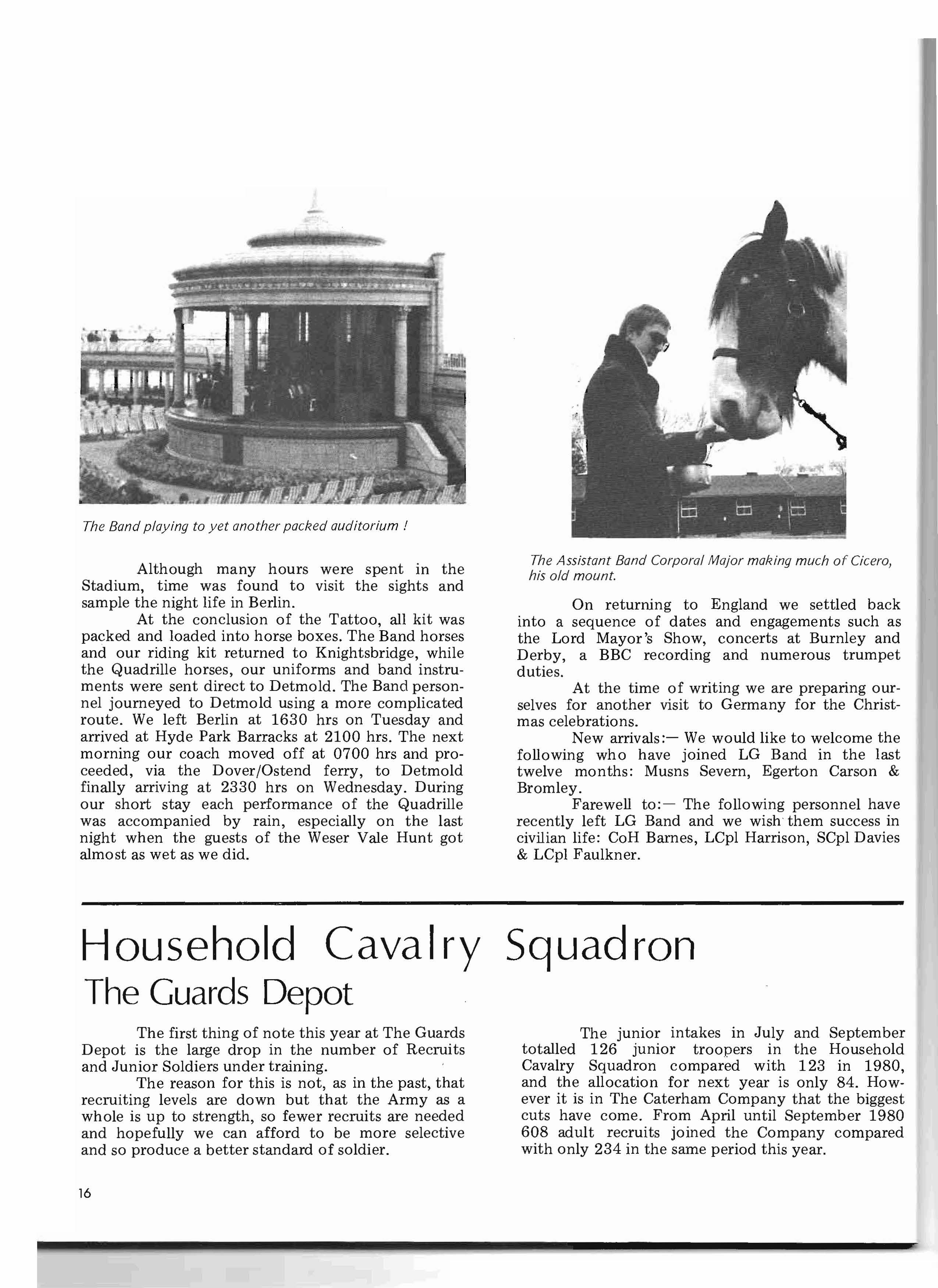
Assistant Band Corporal Major making much of
On returning to England we settled back into a sequence of dates and engagements such as the Lord Mayor's Show, concerts at Burnley and Derby, a BBC recording and numerous trumpet duties.
At the time of writing we are preparing ourselves for another visit to Germany for the Christmas celebrations.
New arrivals:- We would like to welcome the following who have joined LG Band in the last twelve months: Musns Severn, Egerton Carson & Bromley.
Farewell to:- The following personnel have recently left LG Band and we wish them success in civilian life: CoH Barnes, LCpl Harrison, SCpl Davies & LCpl Faulkner.
The first thing of note this year at The Guards Depot is the large drop in the number of Recruits and Junior Soldiers under training.
The reason for this is not, as in the past, that recruiting levels are down but that the Army as a whole is up to strength, so fewer recruits are needed and hopefully we can afford to be more selective and so produce a better standard of soldier.
The junior intakes in July and September totalled 126 junior troopers in the Household Cavalry Squadron compared with 123 in 1980, and the allocation for next year is only 84. However it is in The Caterham Company that the biggest cuts have come. From April until September 1980 608 adult recruits joined the Company compared with only 234 in the same period this year.
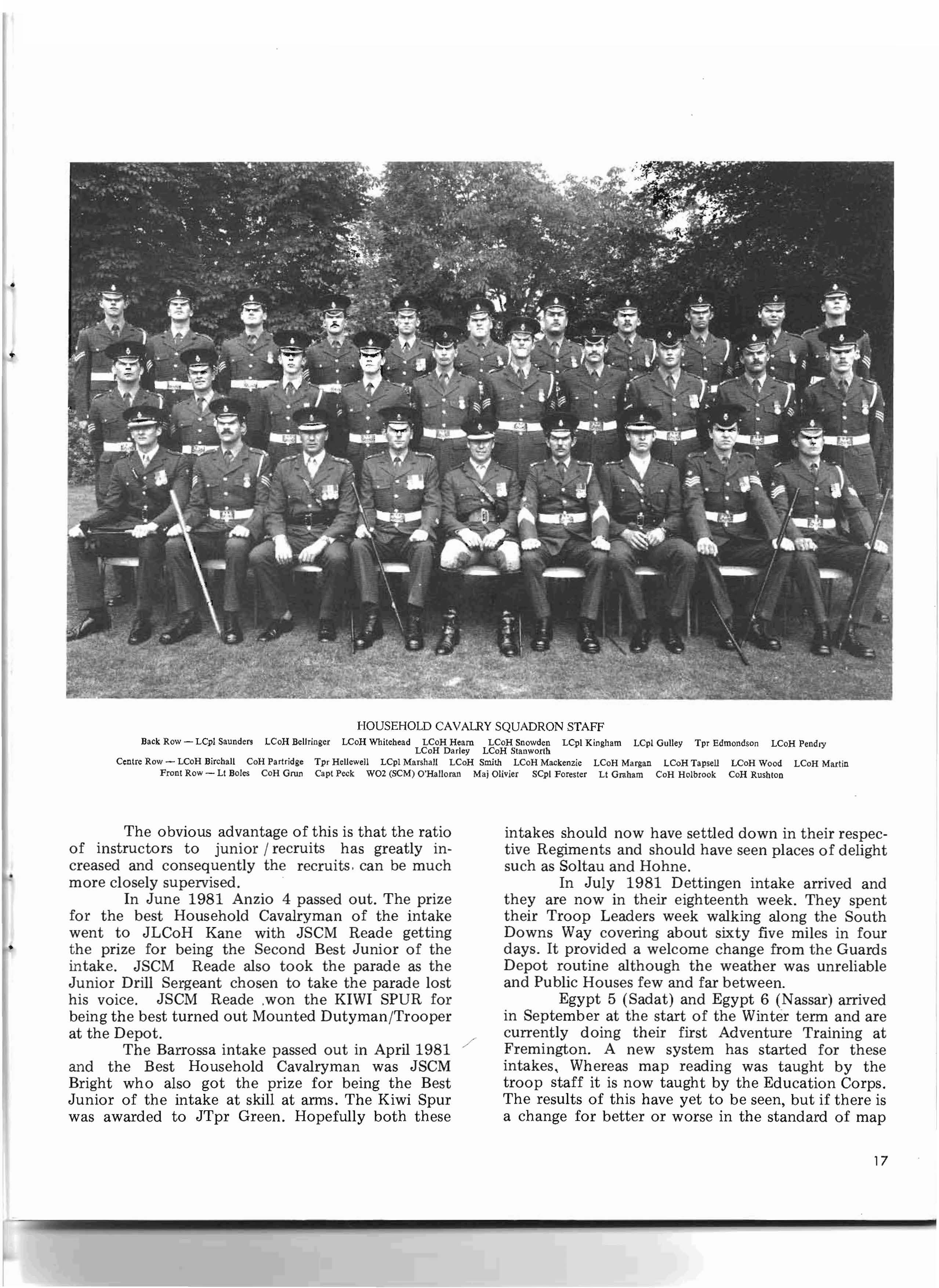
The obvious advantage of this is that the ratio
intakes should now have settled down in their respecof instructors to junior j recruits has greatly in tive Regiments and should have seen places of delight creased and consequently the recruits. can be much such as Soltau and Hohne. more closely supervised. In July 1981 Dettingen intake arrived and In June 1981 Anzio 4 passed out. The prize they are now in their eighteenth week. They spent for the best Household Cavalryman of the intake their Troop Leaders week walking along the South went to JLCoH Kane with JSCM Reade getting Downs Way covering about sixty five miles in four the prize for being the Second Best Junior of the days. It provided a welcome change from the Guards intake. JSCM Reade also took the parade as the Depot routine although the weather was unreliable Junior Drill Sergeant chosen to take the parade lost and Public Houses few and far between. his voice. JSCM Reade ,won the KIWI SPUR for Egypt 5 (Sadat) and Egypt 6 (Nassar) arrived being the best turned out Mounted DutymanjTrooper in September at the start of the Winter term and are at the Depot. currently doing their first Adventure Training at
The Barrossa intake passed out in April 1981 /' Fremington. A new system has started for these and the Best Household Cavalryman was JSCM intakes, Whereas map reading was taught by the Bright who also got the prize for being the Best troop staff it is now taught by the Education Corps. Junior of the intake at skill at arms. The Kiwi Spur The results of this have yet to be seen, but if there is was awarded to JTpr Green. Hopefully both these a change for better or worse in the standard of map
reading of Troopers joining the Regiment, this is the reason.
In August the Squadron Leader Major J S Olivier - RHG/D handed over to Major I M D L Weston - RHG/D. SCM Shaw left us in December and we wish him the best of luck in civilian life.
SCM D A O'Halloran - RHG/D took his place. We have also said goodbye to: Lt CHN Graham who has gone to the RCC, CoH Holbrook who has gone to Knightsbridge and LCsoH Margan and Hearn who have joined the Regiment in Detmold.
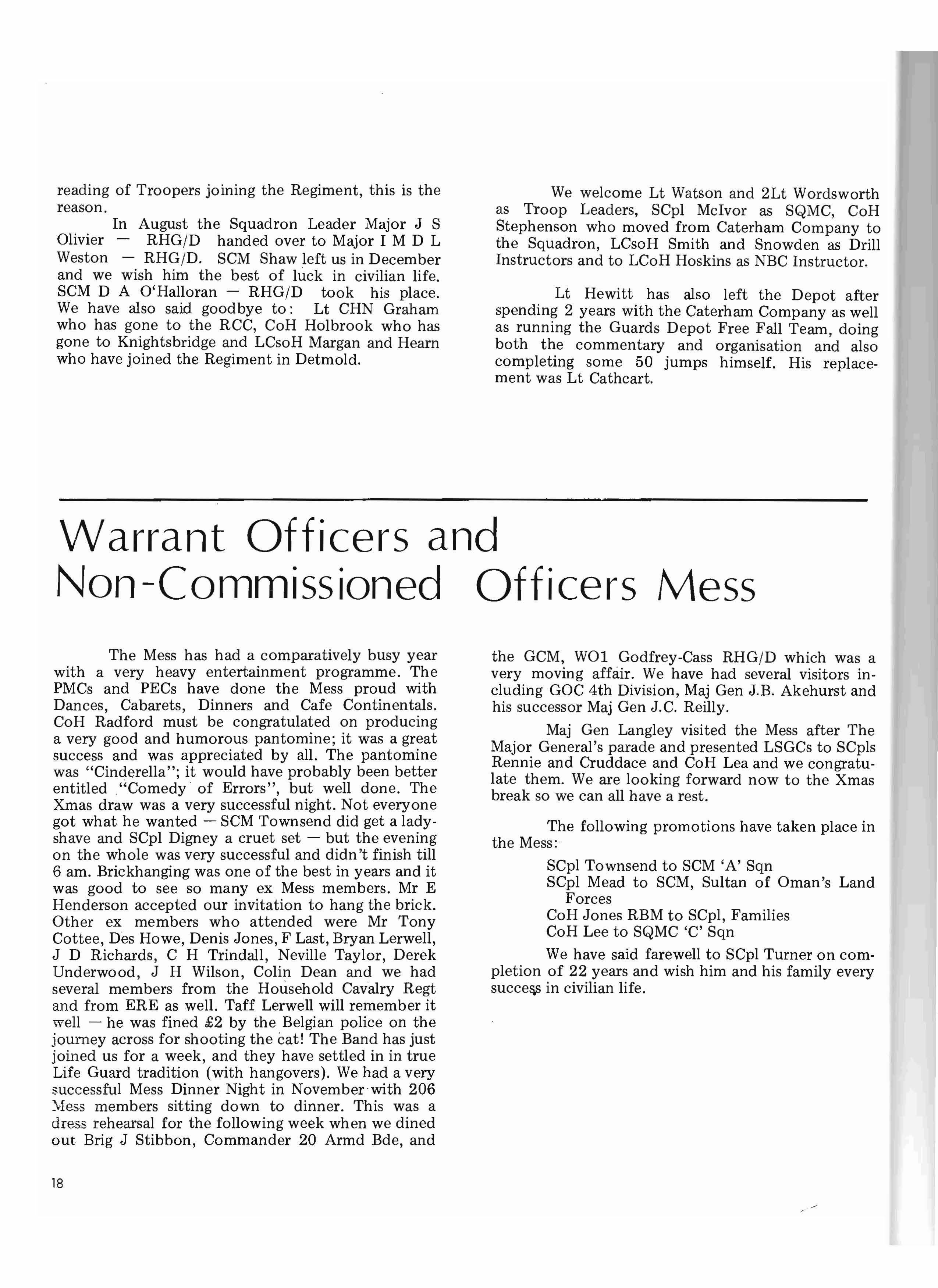
We welcome Lt Watson and 2Lt Wordsworth as Troop Leaders, SCpl McIvor as SQMC, CoH Stephenson who moved from Caterham Company to the Squadron, LCsoH Smith and Snowden as Drill Instructors and to LCoH Hoskins as NBC Instructor.
Lt Hewitt has also left the Depot after spending 2 years with the Caterham Company as well as running the Guards Depot Free Fall Team, doing both the commentary and organisation and also completing some 50 jumps himself. His replacement was Lt Cathcart.
The Mess has had a comparatively busy year with a very heavy entertainment programme. The PMCs and PECs have done the Mess proud with Dances, Cabarets, Dinners and Cafe Continentals. CoH Radford must be congratulated on producing a very good and humorous pantomine; it was a great success and was appreciated by all. The pantomine was "Cinderella"; it would have probably been better entitled "Comedy· of Errors", but well done. The Xmas draw was a very successful night. Not everyone got what he wanted - SCM Townsend did get a ladyshave and SCpl Digney a cruet set - but the evening on the whole was very successful and didn't finish till 6 am. Brickhanging was one of the best in years and it was good to see so many ex Mess members. Mr E Henderson accepted our invitation to hang the brick. Other ex members who attended were Mr Tony Cottee, Des Howe, Denis Jones, F Last, Bryan Lerwell, J D Richards, C H Trindall, Neville Taylor, Derek Underwood, J H Wilson, Colin Dean and we had several members from the Household Cavalry Regt and from ERE as well. Taff Lerwell will remember it well - he was fined £2 by the Belgian police on the journey across for shooting the cat! The Band has just joined us for a week, and they have settled in in true Life Guard tradition (with hangovers). We had a very successful Mess Dinner Night in November with 206 :\<le58 members sitting down to dinner. This was a dress rehearsal for the following week when we dined out Brig J Stibbon, Commander 20 Armd Bde, and
the GCM, WOl Godfrey-Cass RHG/D which was a very moving affair. We have had several visitors including GOC 4th Division, Maj Gen J.B. Akehurst and his successor Maj Gen J.C. Reilly.
Maj Gen Langley visited the Mess after The Major General's parade and presented LSGCs to SCpls Rennie and Cruddace and CoH Lea and we congratulate them. We are looking forward now to the Xmas break so we can all have a rest.
The following promotions have taken place in the Mess:
SCpl Townsend to SCM 'A' Sqn
SCpl Mead to SCM, Sultan of Oman's Land Forces
CoH Jones RBM to SCpl, Families
CoH Lee to SQMC 'C' Sqn
We have said farewell to SCpl Turner on completion of 22 years and wish him and his family every in civilian life.
The Regimental Polo Team has once again been plagued by not having four regular players together all through the season. However, in spite of this there have been some successes, a lot of fun for both players and grooms and a gathering of good low and medium goal experience.
The main team was once again based in England although Capt Forbes Cockell played in Germany with beginners Maj D' Ambrumenil and Lt A J Watson.
As it is the grooms who do most of the hard work, it was appropriate that The Major General's Cup between the polo grooms of the Household Cavalry and those of the Foot Guards should be held early in the season. Capt Hunter bolstered up the home team with LCpl Walton, Tpr Day and three Blues and Royals sharing the other chukkas. LCpl Walton played well on Lt Graham's ponies but Sergeant Lasbrey's more experienced Foot Guards just ran out the winner by 4 - 3. This was appropriate in retrospect as it· is his last season with the club and Mrs Langley very kindly presented a whip to all those who had competed.
The main success of the season was during the Ascot week tournament when we had the honour of Prince Charles playing in The Life Guards low goal team. He is a good 4 goal player, well mounted and is

an effective team captain. After five matches we had reached the final of the Caterham Cup and lost to a better mounted, if slightly underhandicapped, Kirtlington side. The standard of pony at Windsor has improved dramatically over the last three years and we will have to improve our string when we want to compete effectively there again. Our team for this was:
1. Capt PRL Hunter 1 2. Lt C H N Graham 2 3. HRH The Prince of Wales 4
In the Inter Regimental Cup we beat the Blues and Royals 7 -2 but lost in the semi final to the Welsh Guards 5 - 1. Maj Reddy Watt, at 5 goals, the highest handicapped serving officer, is very difficult to beat.
In the Captains and Subalterns Cup we beat the Irish Guards 7 -2 and The Blues and Royals 6 -1 to reach the Final. Here we were the favourites to win but ringworm knocked out all our private ponies and we went down to the Queen's Royal Irish Hussars 4 - 3. Our team for this was:
Capt PRL Hunter 1
Lt DC Darley 1
Lt C H N Graham 2
Lt J L Hewitt 1
At the Royal Tournament there were two matches on the 16 July between the Army and Royal Navy. Capt Hunter and Lt Graham played for the Army and won the Domecq Trophy both times. Lt Hewitt was also selected to play for the Army in the Rundle Cup but the Navy with Prince Charles narrowly ran out the winner 5 - 4. In the Whit bread Cup we reached the final
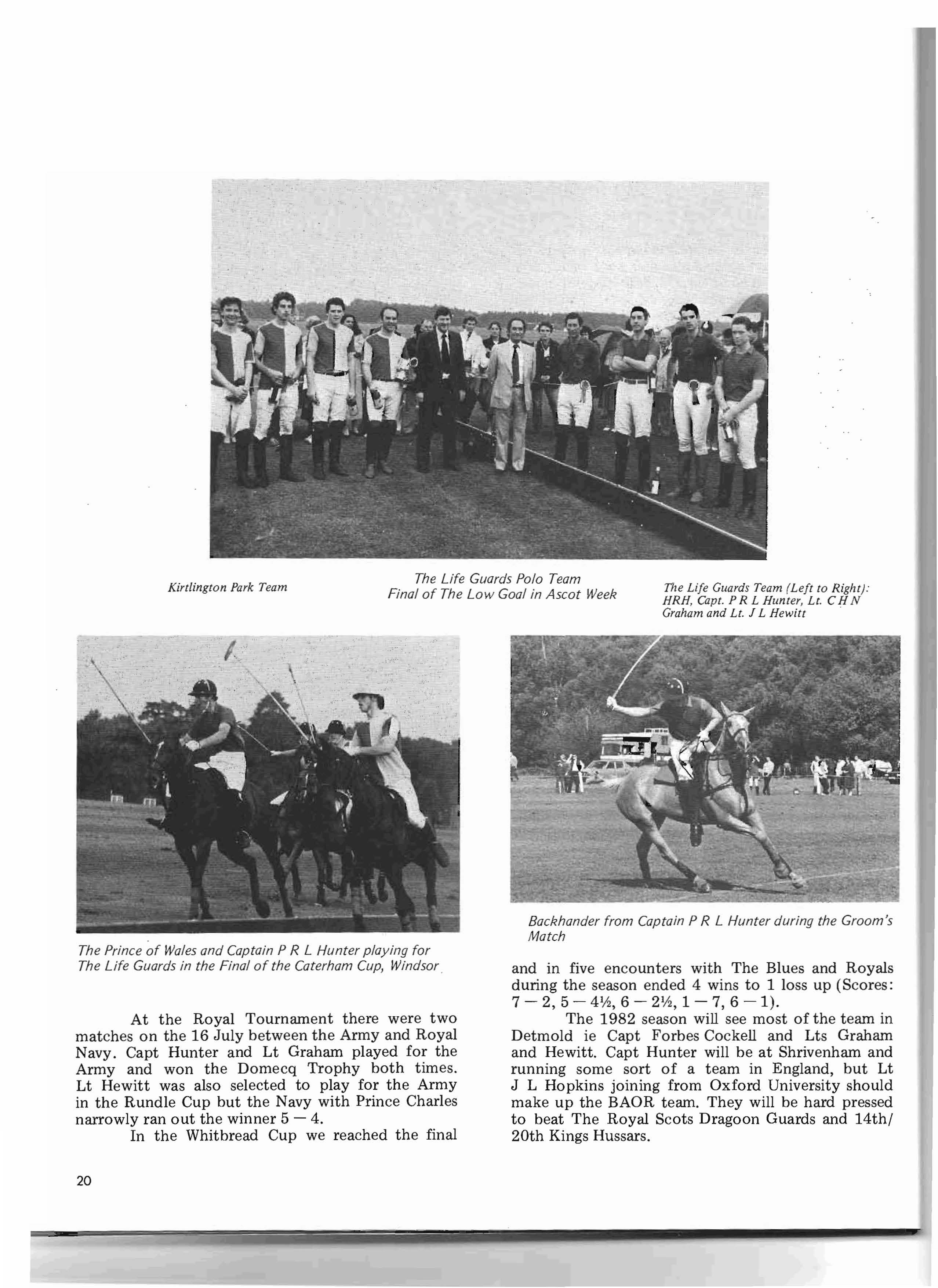
Backhander from Captain P R L Hunter during the
and in five encounters with The Blues and Royals during the season ended 4 wins to 1 loss up (Scores: 7- 2,5 - 4V2, 6- 2 112,1- 7,6 -1).
The 1982 season will see most of the team in Detmold ie Capt Forbes Cockell and Lts Graham and Hewitt. Capt Hunter will be at Shrivenham and running some sort of a team in England, but Lt J L Hopkins joining from Oxford University should make up the BAOR team. They will be hard pressed to beat The Royal Scots Dragoon Guards and 14th/ 20th Kings Hussars.
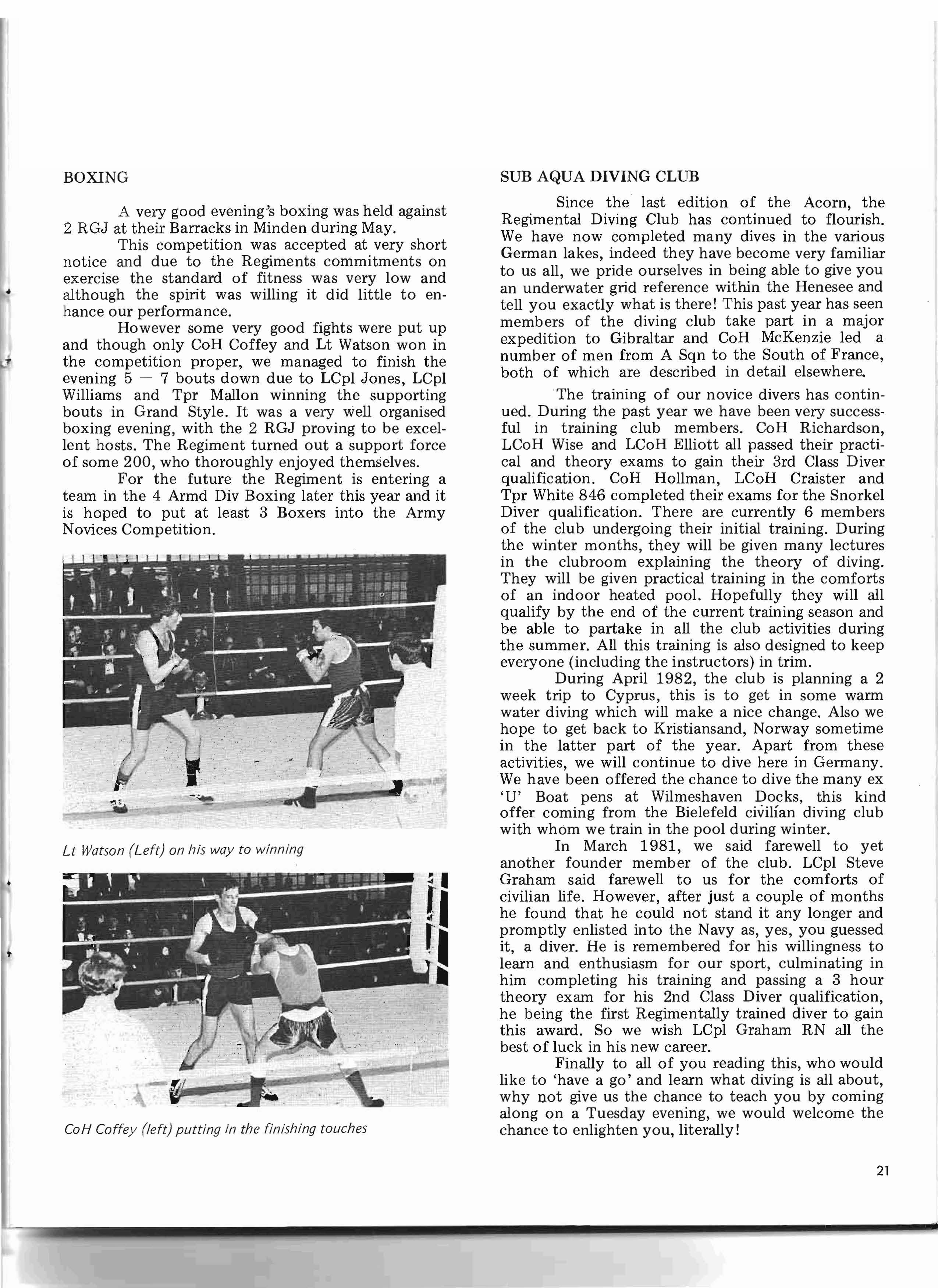
A very good evening's boxing was held against 2 RGJ at their Barracks in Minden during May. This competition was accepted at very short notice and due to the Regiments commitments on exercise the standard of fitness was very low and although the spirit was willing it did little to enhance our performance.
However some very good fights were put up and though only CoH Coffey and Lt Watson won in the competition proper, we managed to finish the evening 5 -7 bouts down due to LCpl Jones, LCpl Williams and Tpr Mallon winning the supporting bouts in Grand Style. It was a very well organised boxing evening, with the 2 RGJ proving to be excellent hosts. The Regiment turned out a support force of some 200, who thoroughly enjoyed themselves.
For the future the Regiment is entering a team in the 4 Armd Div Boxing later this year and it is hoped to put at least 3 Boxers into the Army Novices Competition.
Since the last edition of the Acorn, the Regimental Diving Club has continued to flourish. We have now completed many dives in the various German lakes, indeed they have become very familiar to us all, we pride ourselves in being able to give you an underwater grid reference within the Henesee and tell you exactly what is there! This past year has seen members of the diving club take part in a major expedition to Gibraltar and CoH McKenzie led a number of men from A Sqn to the South of France, both of which are described in detail elsewhere.
The training of our novice divers has continued. During the past year we have been very successful in training club members. CoH Richardson, LCoH Wise and LCoH Elliott all passed their practical and theory exams to gain their 3rd Class Diver qualification. CoH Hollman, LCoH Craister and Tpr White 846 completed their exams for the Snorkel Diver qualification. There are currently 6 members of the club undergoing their initial training. During the winter months, they will be given many lectures in the clubroom explaining the theory of diving. They will be given practical training in the comforts of an indoor heated pool. Hopefully they will all qualify by the end of the current training season and be able to partake in all the club activities during the summer. All this training is also designed to keep everyone (including the instructors) in trim.
During April 1982, the club is planning a 2 week trip to Cyprus, this is to get in some warm water diving which will make a nice change. Also we hope to get back to Kristiansand, Norway sometime in the latter part of the year. Apart from these activities, we will continue to dive here in Germany. We have been offered the chance to dive the many ex 'U' Boat pens at Wilmeshaven Docks, this kind offer coming from the Bielefeld civilian diving club with whom we train in the pool during winter.
In March 1981, we said farewell to yet another founder member of the club. LCpl Steve Graham said farewell to us for the comforts of civilian life. However, after just a couple of months he found that he could not stand it any longer and promptly enlisted into the Navy as, yes, you guessed it, a diver. He is remembered for his willingness to learn and enthusiasm for our sport, CUlminating in him completing his training and passing a 3 hour theory exam for his 2nd Class Diver qualification, he being the first Regimentally trained diver to gain this award. So we wish LCpl Graham RN all the best of luck in his new career.
Finally to all of you reading this, who would like to 'have a go' and learn what diving is all about, why not give us the chance to teach you by coming along on a Tuesday evening, we would welcome the chance to enlighten you, literally!
The inter-Squadron rugby winners for the 1980/81 season were A Squadron after a very hard game against B Squadron in which the final score was 10-0. This is the second year running that A Squadron has won the cup but now that SCM Whyte has moved to HQ Squadron he is hoping to change that in the 1981/82 season!
The new season started in August with the inter-Squadron 7 -a-side competition. The Regiment fielded 16 teams and C Squadron's 'A' team were the winners. Bad weather has prevented much activity so far, despite a full fixture list. In the Army Cup, the Regiment was beaten in the second round by a very strong Royal Welch Fusiliers team, and 3 RTR defeated us in the RAC Cup. Finally mention must be made of Tprs Lerwell, Evans 964 and Kozakiewicz all of whom represented 4th Armoured Division in the Divisional finals.
We have had a below average year in the stables due to the Regiment being heavily committed and a number of horses going back to London for the Royal Wedding.
The 1st major win of the season was CoH Hague on Dinder winning the novice class at the Rhine Army Hunter Trials. At the Verden show LCpl Burge and Zebedee won the Verden Garrison Challenge Cup in the class M jumping. Unfortunately we could only manage a few minor honours due to the lack of horse power. LCoH Robertson won the Restricted Novice at Fallingbostel on Christine and CoH Hague won the open at 39 Field Regiment Hunter Trial. Lt The Hon M Watson and CoH Hague both had success on Black Chief which won the competition for the best open horse ridden by an officer or soldier. CoH Hague and Dinder won the best novice horse of the season. SCM Kelly on his own horse Lossyn Bach, after being consistently placed all season, did particularly well at Moosdorf, winning the one day event against some very strong opposition.
It would be wrong not to give the farrier a mention. CoH Williams won the BAOR Shoeing Trophy for the second time.
September saw the arrival of SCpl Lawrence who, after a long absence from the Mounted Squadron, tried his hand at the Weser Vale Hunter Trial in the intermediate section on Amos where he demonstrated a quick dismount at the last fence, but he made up for it by coming second in the following week at the QOH Hunter Trial.
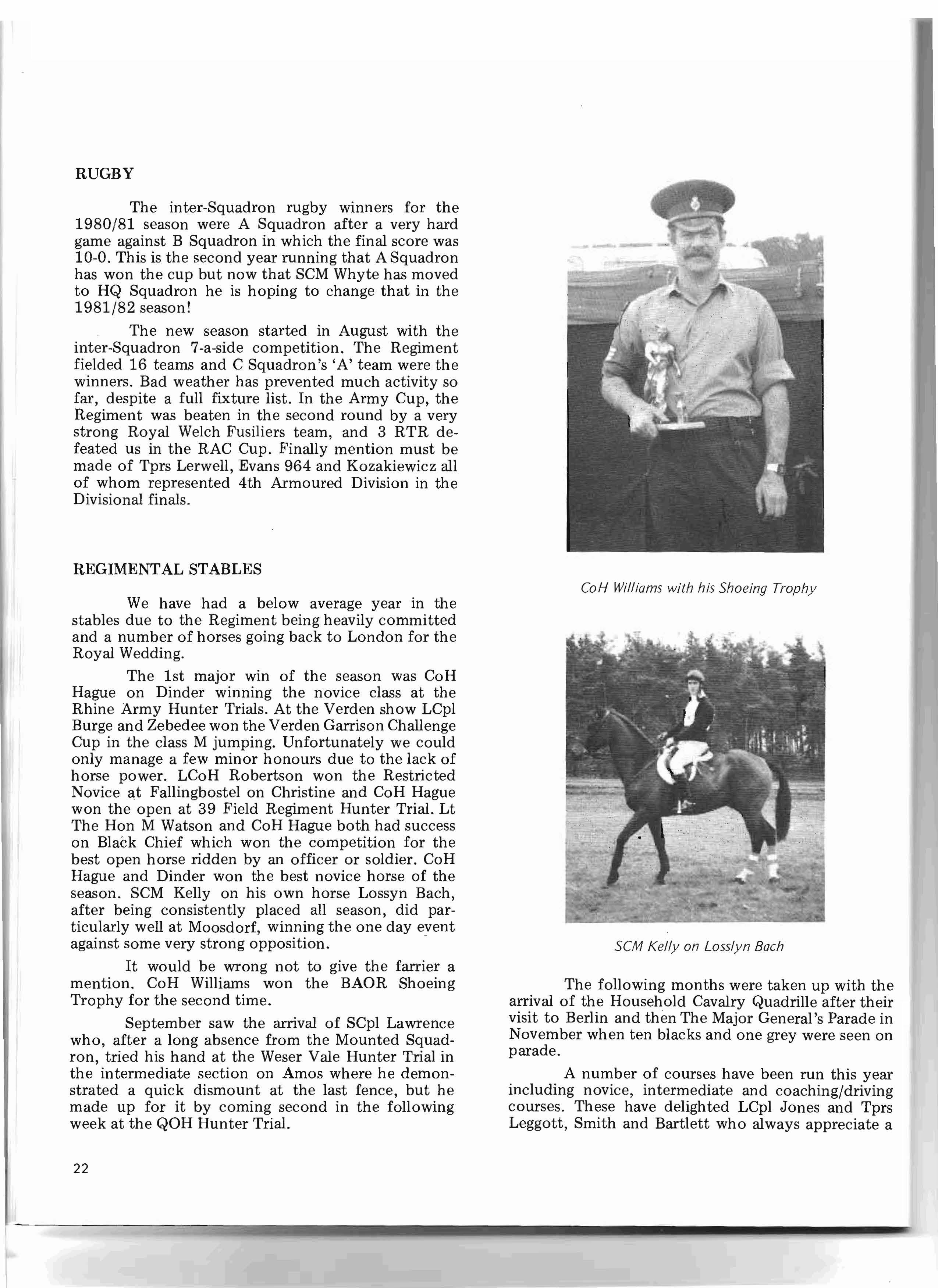
The following months were taken up with the arrival of the Household Cavalry Quadrille after their visit to Berlin and thEm The Major General's Parade in November when ten blacks and one grey were seen on parade.
A number of courses have been run this year including novice, intermediate and coaching/driving courses. These have delighted LCpl Jones and Tprs Leggott, Smith and Bartlett who always appreciate a
helping hand with the daily routine. And finally we say goodbye to LCpl Norgrove who is being posted away from us, and we wish him the best of luck in the future.
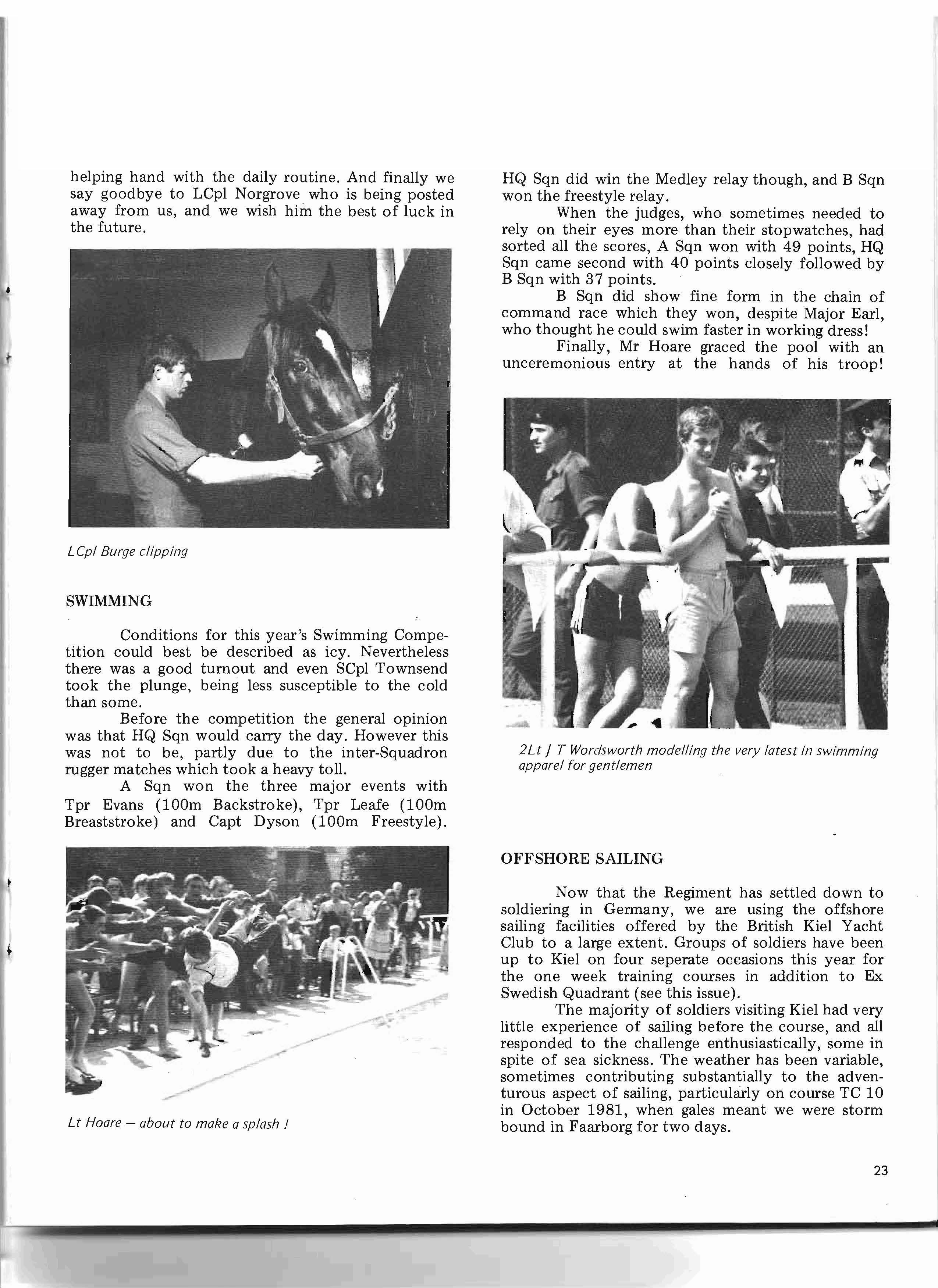
Conditions for this year's Swimming Competition could best be described as icy. Nevertheless there was a good turnout and even SCpl Townsend took the plunge, being less susceptible to the cold than some.
Before the competition the general opinion was that HQ Sqn would carry the day. However this was not to be, partly due to the inter-Squadron rugger matches which took a heavy toll.
A Sqn won the three major events with Tpr Evans (100m Backstroke), Tpr Leafe (100m Breaststroke) and Capt Dyson (100m Freestyle).
HQ Sqn did win the Medley relay though, and B Sqn won the freestyle relay.
When the judges, who sometimes needed to rely on their eyes more than their stopwatches, had sorted all the scores, A Sqn won with 49 points, HQ Sqn came second with 40 points closely followed by B Sqn with 37 points.
B Sqn did show fine form in the chain of command race which they won, despite Major Earl, who thought he could swim faster in working dress! Finally, Mr Hoare graced the pool with an unceremonious entry at the hands of his troop!
Now that the Regiment has settled down to soldiering in Germany, we are using the offshore sailing facilities offered by the British Kiel Yacht Club to a large extent. Groups of soldiers have been up to Kiel on four seperate occasions this year for the one week training courses in addition to Ex Swedish Quadrant (see this issue).
The majority of soldiers visiting Kiel had very little experience of sailing before the course, and all responded to the challenge enthusiastically, some in spite of sea sickness. The weather has been variable, sometimes contributing substantially to the adventurous aspect of sailing, particularly on course TC 10 in October 1981, when gales meant we were storm bound in Faarborg for two days.
Space is too short to mention all of the forty three soldiers who have been to Kiel this year, but the training is reaching the stage where some, to whom sailing was a new adventure on arrival in Germany, have enough sea-time to be able to take their Skippers Tickets next year. In this context we hope Tpr MEGGISON will lead the way, and contribute to our shortage of instructors.
We look forward to next season with keen anticipation.
The winter 1980/81 saw considerable activity on the part of Maj N J D' Ambrumenil, who, with the help of Frau Rau, unearthed a phaeton for use by the Coaching Club. Bits of harness were acquired by various means, and in April the coach, pulled by Abigail and Conn aught took to the road - for all of 5 minutes! At the end of that period the coach was literally spread across the German countryside and a slightly damaged Maj D' AJ!lbrumenil was seated beside the road surrounded by the debris. Fortunately both horses survived unscathed.
A lengthy rebuild by the RPC at Schloss Neuhaus followed, and they did a first class job. The phaeton emerged black and gleaming, with smart moleskin upholstery. The harness was repaired and Abigail and Conn aught, driven this time by LCoH Robertson pulled the C in C BAOR, General Sir Michael Gow, onto the showground at Bad Lippspringe to open the Rhine Army Summer Show. They then put on a small demonstration each day to the pleasure of the general public.

This stimulated much interest, as a result of which we have started running a new type of D & M course, a coaching course! DRAC on his annual visit could hardly believe his eyes. We hope to run further courses of this nature in the future using Frau Rau's phaeton, and a shooting brake borrowed complete with a harness from a local German farmer. And then - who knows?!
The writer of Cresta notes rides in January, is invited to write in October when he has forgotten all about it and reads the result in March when he has returned from the following years race wondering whether he could delay the editor and get hot press news of the current year. It never quite works and so these notes cover the 1980/81 season.
1980 was a year of in tense activity for Major d'Ambrumenil after he was asked to Captain the Army Team since he clearly wanted all his friends in St Moritz and eventually persuaded 9 Life Guard officers that a ride or two down the Cresta was exhilarating and fun even if a little nerve wracking at times. Full support was given by the Commanding Officer, and Major Gilbart-Denham led by age and seniority joined in the new experience of hurtling down an ice run on one's stomach at 85 miles an hour.
The 9 Regimental officers formed the largest Regimental contingent of some 25 Army riders but so many were there in the early morning that frustrations of not being able to get more than one, or two rides inevitably forced the officers into more
serious activities in the Club bar. The Royal Navy and Royal Air Force teams remain convinced to this day that the whole thing was a ploy by Major d 'Ambrumenil to bring all his rich friends to St Moritz with the sole intention of clogging the course so that the opposition could not get training rides themselves. It nearly worked.
Lt Alistair Watson and Major d 'Ambrumenil were first and second in the Army on the Interservices Race Day which was great credit to Lt Watson in his second year of riding.
Other notable riders were Captain Hayward and Lt Miles Watson both of whom learnt more about the outside of the run than the inside, especially the outside area of Shuttlecock comer, joined the famous Shuttlecock Club. Captain Falkner who was not a member of the Club arrived at the Annual Dinner anyway and having composed a line or two of rhyme gallantly sang with much gusto and two Foot Guard officers with similar tuned up voices.
Messrs Hoare and Wordsworth reduced their times very respectably as did one or two other officers who wish to remain anonymous since their squadron leader still thinks that they were on the tank park or somewhere else. Captain Black, in St Moritz at the time looked at the Run thoughtfully as always and decided that self preservation, wisdom and skiing were much more sensible than Cresta riding.
By the time this is read another year of riding will have passed and hopefully more officers will have learnt of the exhilaration, sheer panic at times, the bruises, the cold standing around and the enthusiasm of all other riders. Hopefully the Regiment, after 10 years of one, generally two, officers in the Army Team of 6, will continue its record for some years to come.
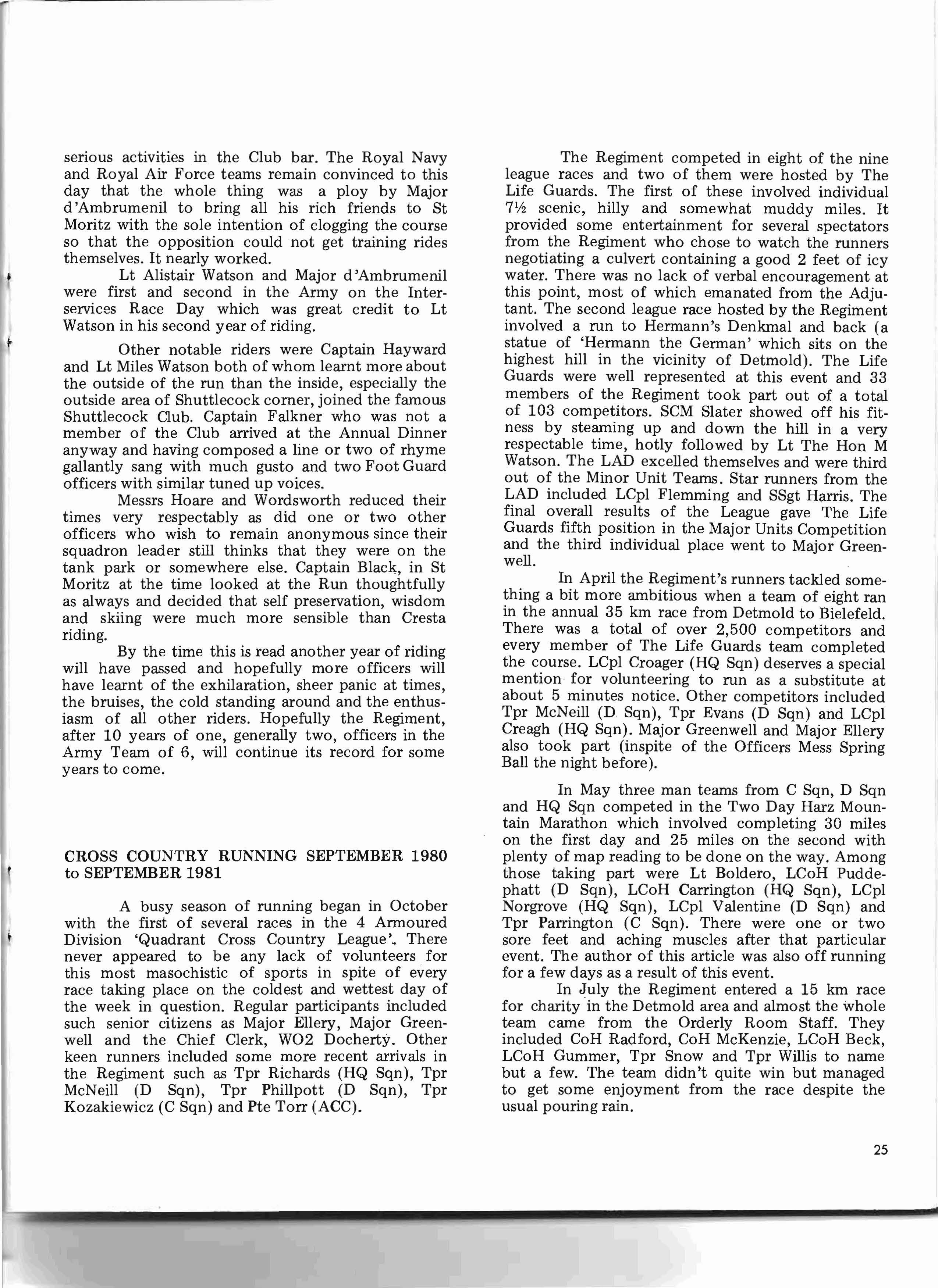
CROSS COUNTRY RUNNING SEPTEMBER 1980 to SEPTEMBER 1981
A busy season of running began in October with the first of several races in the 4 Armoured Division 'Quadrant Cross Country League ',. There never appeared to be any lack of volunteers for this most masochistic of sports in spite of every race taking place on the coldest and wettest day of the week in question. Regular participants included such senior citizens as Major Ellery, Major Greenwell and the Chief Clerk, W02 Docherty. Other keen runners included some more recent arrivals in the Regiment such as Tpr Richards (HQ Sqn), Tpr McNeill (D Sqn), Tpr Phillpott (D Sqn), Tpr Kozakiewicz (C Sqn) and Pte Torr (ACC).
The Regiment competed in eight of the nine league races and two of them were hosted by The Life Guards. The first of these involved individual 7 1h scenic, hilly and somewhat muddy miles. It provided some entertainment for several spectators from the Regiment who chose to watch the runners negotiating a culvert containing a good 2 feet of icy water. There was no lack of verbal encouragement at this point, most of which emanated from the Adjutant. The second league race hosted by the Regiment involved a run to Hermann's Denkmal and back (a statue of 'Hermann the German' which sits on the highest hill in the vicinity of Detmold). The Life Guards were well represented at this event and 33 members of the Regiment took part out of a total of 103 competitors. SCM Slater showed off his fitness by steaming up and down the hill in a very respectable time, hotly followed by Lt The Hon M Watson. The LAD excelled themselves and were third out of the Minor Unit Teams. Star runners from the LAD included LCpl Flemming and SSgt Harris. The final overall results of the League gave The Life Guards fifth position in the Major Units Competition and the third individual place went to Major Greenwell.
In April the Regiment's runners tackled something a bit more ambitious when a team of eight ran in the annual 35 km race from Detmold to Bielefeld. There was a total of over 2,500 competitors and every member of The Life Guards team completed the course. LCpl Croager (HQ Sqn) deserves a special mention for volunteering to run as a substitute at about 5 minutes notice. Other competitors included Tpr McNeill (D Sqn), Tpr Evans (D Sqn) and LCpl Creagh (HQ Sqn). Major Greenwell and Major Ellery also took part (inspite of the Officers Mess Spring Ball the night before).
In May three man teams from C Sqn, D Sqn and HQ Sqn competed in the Two Day Harz Mountain Marathon which involved completing 30 miles on the first day and 25 miles on the second with plenty of map reading to be done on the way. Among those taking part were Lt Boldero, LCoH Puddephatt (D Sqn), LCoH Carrington (HQ Sqn), LCpl Norgrove (HQ Sqn), LCpl Valentine (D Sqn) and Tpr Parrington (C Sqn). There were one or two sore feet and aching muscles after that particular event. The author of this article was also off running for a few days as a result of this event.
In July the Regiment entered a 15 km race for charity in the Detmold area and almost the whole team came from the Orderly Room Staff. They included CoH Radford, CoH McKenzie, LCoH Beck, LCoH Gummer, Tpr Snow and Tpr Willis to name but a few. The team didn't quite win but managed to get some enjoyment from the race despite the usual pouring rain.
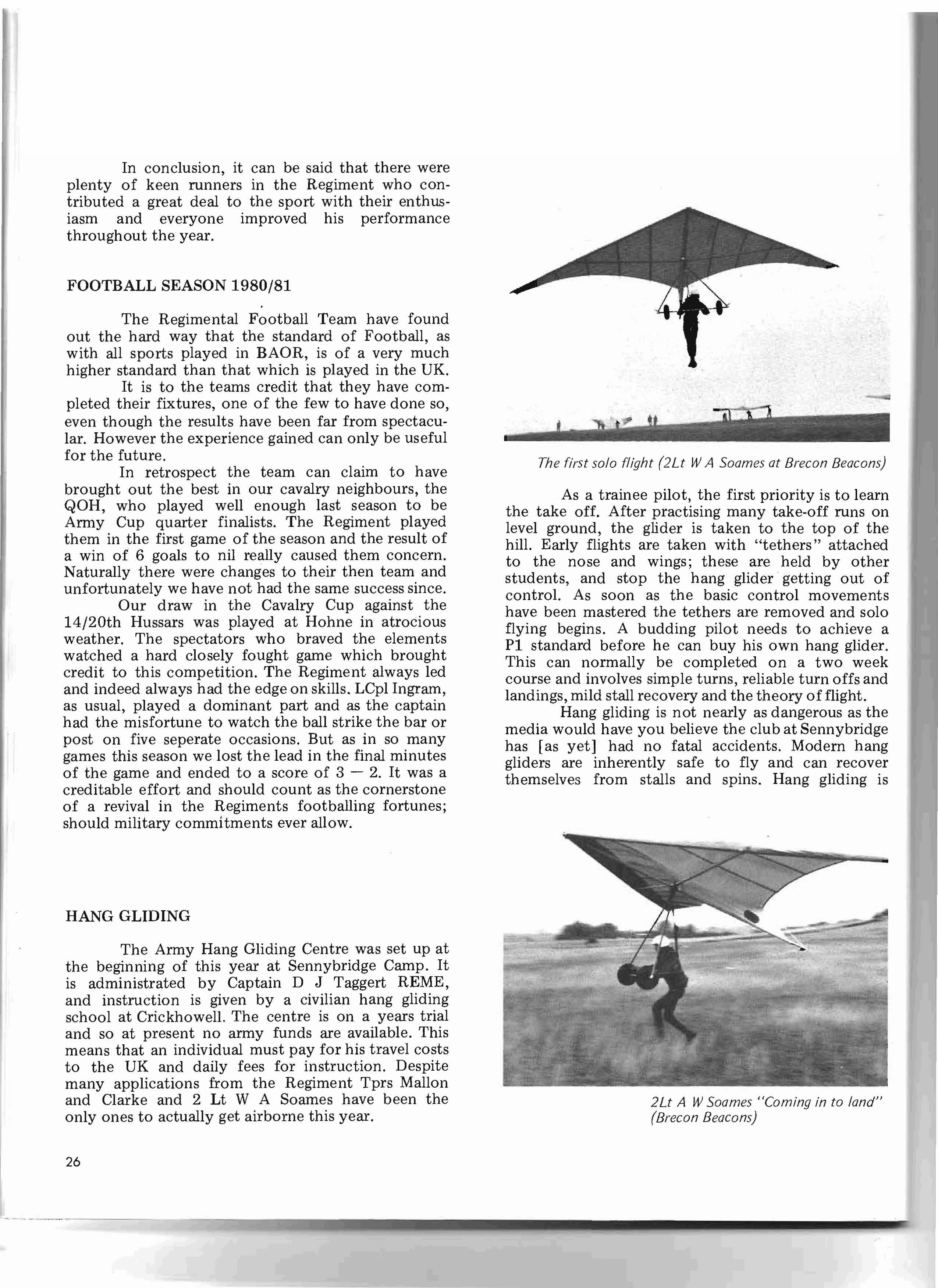
In conclusion, it can be said that there were plenty of keen runners in the Regiment who contributed a great deal to the sport with their enthusiasm and everyone improved his performance throughout the year.
The Regimental Football Team have found out the hard way that the standard of Football, as with all sports played in BAOR, is of a very much higher standard than that which is played in the UK. It is to the teams credit that they have completed their fixtures, one of the few to have done so, even though the results have been far from spectacular. However the experience gained can only be useful for the future.
In retrospect the team can claim to have brought out the best in our cavalry neighbours, the QOH, who played well enough last season to be Army Cup quarter finalists. The Regiment played them in the first game of the season and the result of a win of 6 goals to nil really caused them concern. Naturally there were changes to their then team and unfortunately we have not had the same success since. Our draw in the Cavalry Cup against the 14/20th Hussars was played at Hohne in atrocious weather. The spectators who braved the elements watched a hard closely fought game which brought credit to this competition. The Regiment always led and indeed always had the edge on skills. LCpl Ingram, as usual, played a dominant part and as the captain had the misfortune to watch the ball strike the bar or post on five seperate occasions. But as in so many games this season we lost the lead in the final minutes of the game and ended to a score of 3 - 2. It was a creditable effort and should count as the cornerstone of a revival in the Regiments footballing fortunes; should military commitments ever allow.
The Army Hang Gliding Centre was set up at the beginning of this year at Sennybridge Camp. It is administrated by Captain D J Taggert REME, and instruction is given by a civilian hang gliding school at Crickhowell. The centre is on a years trial and so at present no army funds are available. This means that an individual must pay for his travel costs to the UK and daily fees for instruction. Despite many applications from the Regiment Tprs Mallon and Clarke and 2 Lt W A Soames have been the only ones to actually get airborne this year.
As a trainee pilot, the first priority is to learn the take off. After practising many take-off runs on level ground, the glider is taken to the top of the hill. Early flights are taken with "tethers" attached to the nose and wings; these are held by other students, and stop the hang glider getting out of control. As soon as the basic control movements have been mastered the tethers are removed and solo flying begins. A budding pilot needs to achieve a PI standard before he can buy his own hang glider. This can normally be completed on a two week course and involves simple turns, reliable turn offs and landings, mild stall recovery and the theory of flight. Hang gliding is not nearly as dangerous as the media would have you believe the club at Sennybridge has [as yet] had no fatal accidents. Modern hang gliders are inherently safe to fly and can recover themselves from stalls and spins. Hang gliding is
flying in its purest and cheapest form. The aim of all hang glider pilots is to learn "soaring", the art of finding thermals and using them to gain height. The top pilots have now been over 25,000 ft and achieved cross-country distances of 100 miles.
JSPC Lippspringe in February kindly laid on a special course for 15 Life Guard students. Since then there have been a steady stream of Life Guards on the three week long basic courses.
On his first jump LCpl Appleyard landed in a tree and Lt Dyson was noted to scream on leaving the plane!
The initial experience is quite unlike anything on earth! Tension is usually at its greatest on the second jump when the student knows full well what is coming. The first actual free fall is an exciting moment too. Once out of the aircraft there is an overwhelming desire to "save one's life" by grabbing the rip cord immediately rather than calmly counting to three before pulling.
Presently there is a high degree of interest in the Regiment, though few of those initially trained go on to become competent parachutists.
JSPC (L) offers the best facilities to be found in Europe. The initial course is free of charge, subsequent student jumps cost DM 6 each, a very large selection of parachute equipment is loaned at no cost, and the standard of tuition is extremely high.
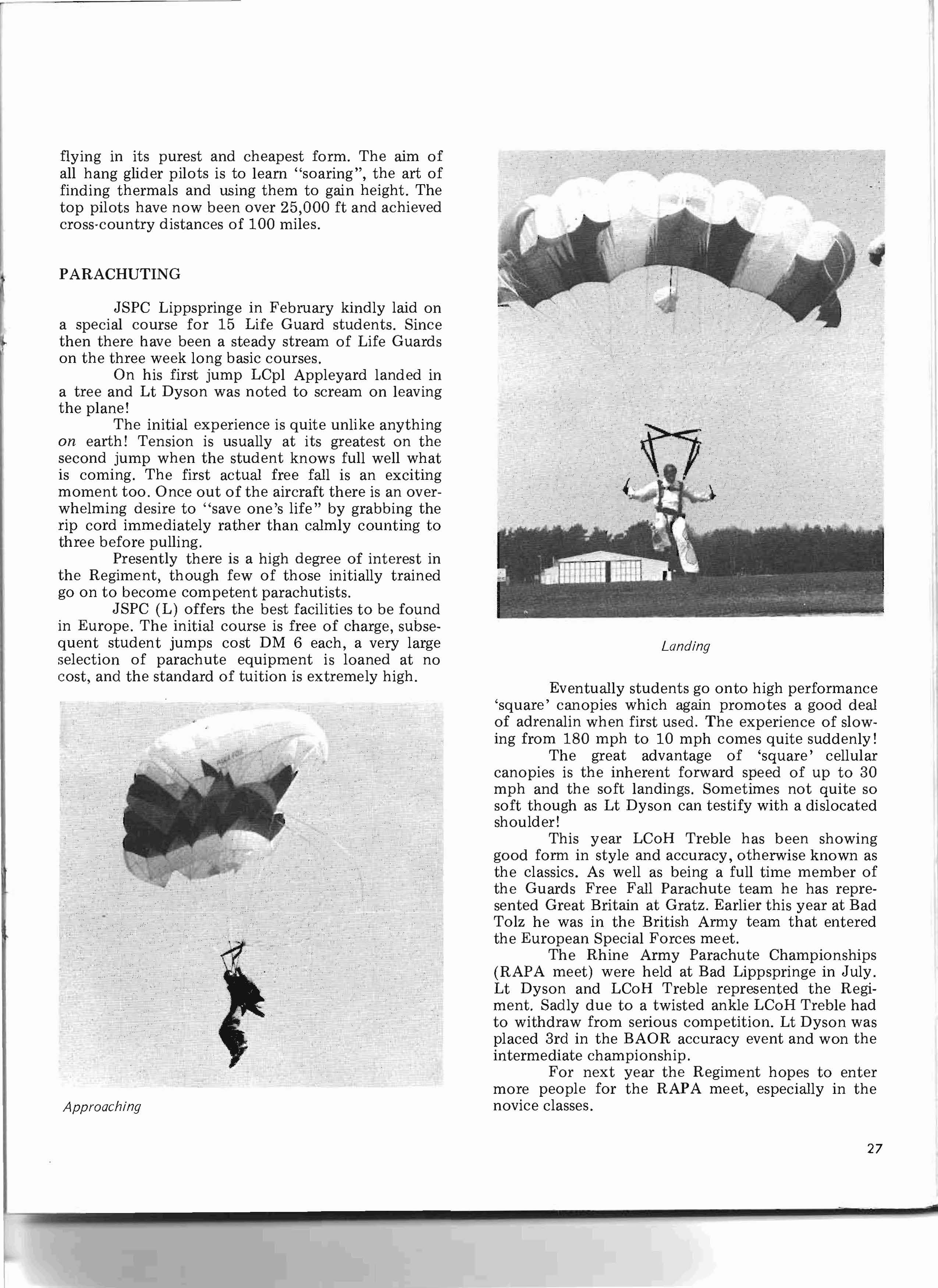
Eventually students go onto high performance 'square' canopies which again promotes a good deal of adrenalin when first used. The experience of slowing from 180 mph to 10 mph comes quite suddenly!
The great advantage of 'square' cellular canopies is the inherent forward speed of up to 30 mph and the soft landings. Sometimes not quite so soft though as Lt Dyson can testify with a dislocated shoulder!
This year LCoH Treble has been showing good form in style and accuracy, otherwise known as the classics. As well as being a full time member of the Guards Free Fall Parachute team he has represented Great Britain at Gratz. Earlier this year at Bad Tolz he was in the British Army team that entered the European Special Forces meet.
The Rhine Army Parachute Championships (RAPA meet) were held at Bad Lippspringe in July. Lt Dyson and LCoH Treble represented the Regiment. Sadly due to a twisted ankle LCoH Treble had to withdraw from serious competition. Lt Dyson was placed 3rd in the BAOR accuracy event and won the intermediate championship.
For next year the Regiment hopes to enter more people for the RAP A meet, especially in the novice classes.
The Hunt Committee has had more than its fair share of changes. The Commanding Officer Lt Col Emson has taken over as the Hunt Chairman and the Joint-Masters have had Maj D'Oyly and Maj Vetch. Maj Vetch hunted hounds for the second half of the 80/81 season, passing the horn to Lt Bell for the new 81/82 season.
The Hunt has gone from strength to strength and hounds have improved on each outing. Even though a hard winter curtailed activity in the old season, there were many good days.
Hounds were shown on two occasions, the Rhine Army Summer Show and the Berlin Show. Both were a success and the organisers kindly made donations towards hunt funds.
The Hunter Trial venue was changed to Heiden, only a few miles from Barracks. Herr Kamper, the owner of the farm, kindly allowed us to build the new course on his land. The day proved a success and the course a challenge. The 10 October was also the date of the Hunt Ball which, though not a resounding financial success, was thoroughly enjoyed by all.
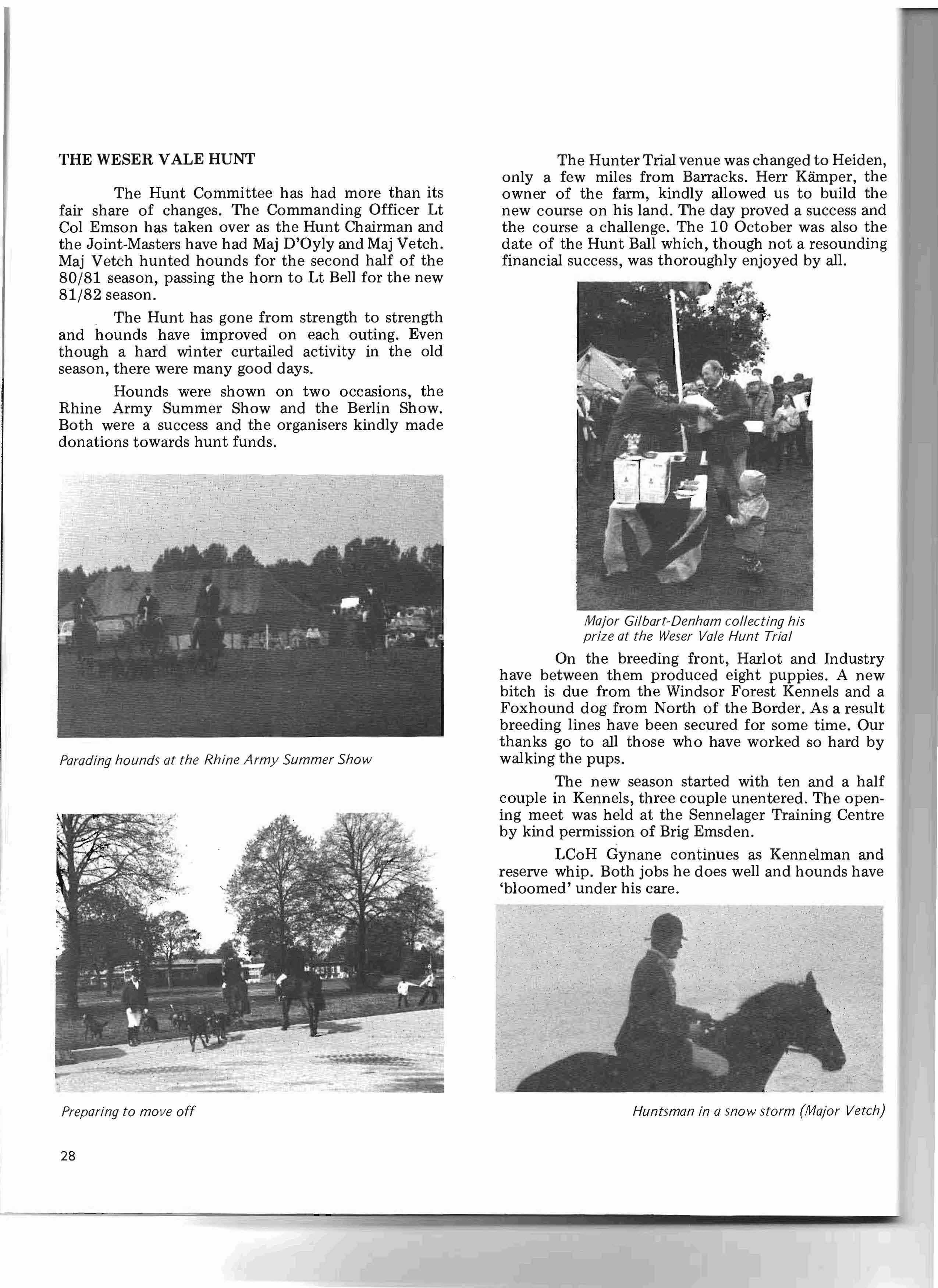
On the breeding front, Harlot and Industry have between them produced eight puppies. A new bitch is due from the Windsor Forest Kennels and a Foxhound dog from North of the Border. As a result breeding lines have been secured for some time. Our thanks go to all those who have worked so hard by walking the pups.
The new season started with ten and a half couple in Kennels, three couple unentered. The opening meet was held at the Sennelager Training Centre by kind permission of Brig Emsden.
LCoH Gynane continues as Kennelman and reserve whip. Both jobs he does well and hounds have 'bloomed' under his care.
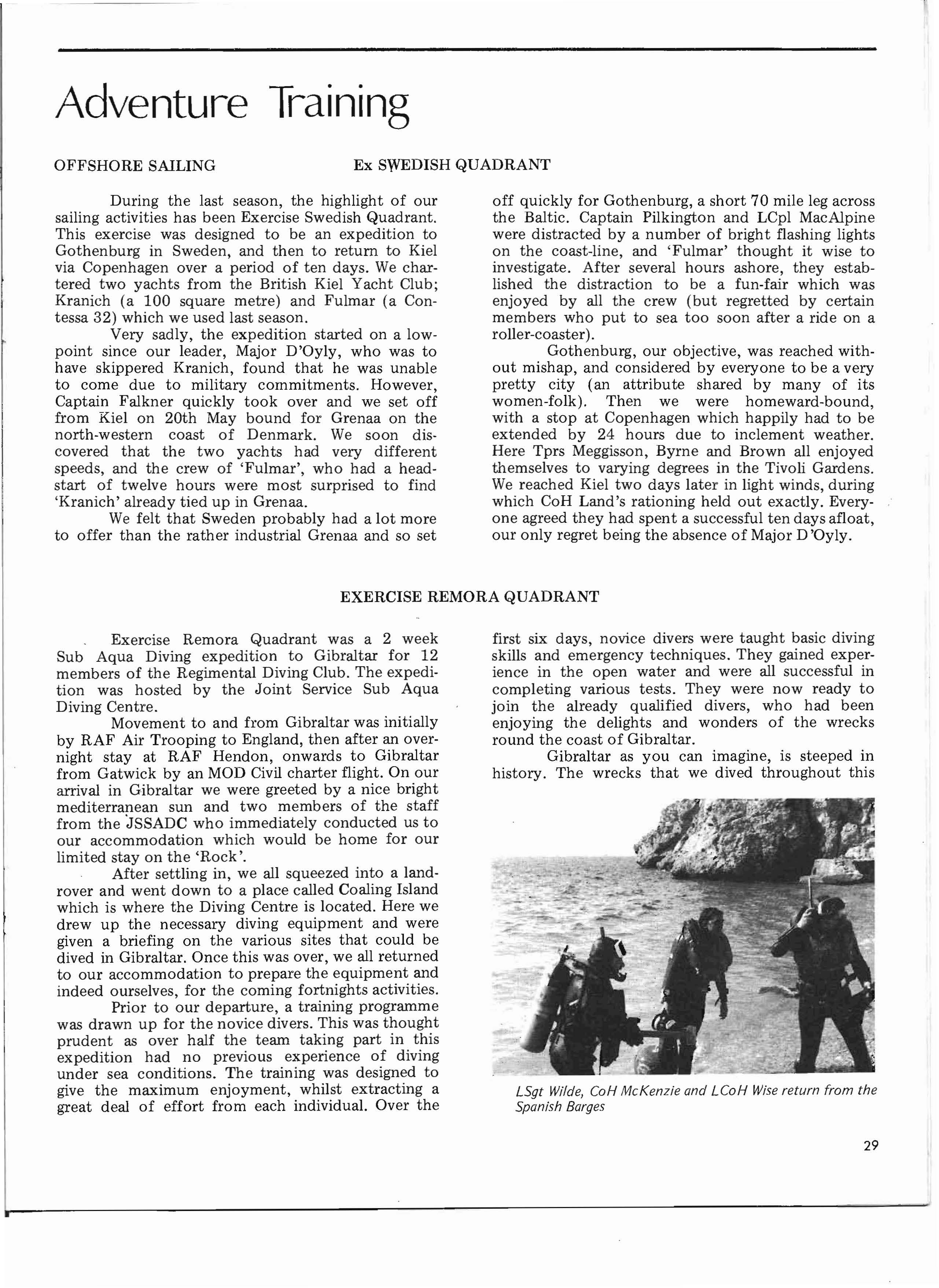
During the last season, the highlight of our sailing activities has been Exercise Swedish Quadrant. This exercise was designed to be an expedition to Gothenburg in Sweden, and then to return to Kiel via Copenhagen over a period of ten days. We chartered two yachts from the British Kiel Yacht Club; Kranich (a 100 square metre) and Fulmar (a Contessa 32) which we used last season.
Very sadly, the expedition started on a lowpoint since our leader, Major D'Oyly, who was to have skippered Kranich, found that he was unable to come due to military commitments. However, Captain Falkner quickly took over and we set off from Kiel on 20th May bound for Grenaa on the north-western coast of Denmark. We soon discovered that the two yachts had very different speeds, and the crew of 'Fulmar', who had a headstart of twelve hours were most surprised to find 'Kranich' already tied up in Grenaa.
We felt that Sweden probably had a lot more to offer than the rather industrial Grenaa and so set
off quickly for Gothenburg, a short 70 mile leg across the Baltic. Captain Pilkington and LCpl MacAlpine were distracted by a number of bright flashing lights on the coast-line, and 'Fulmar' thought it wise to investigate. After several hours ashore, they established the distraction to be a fun-fair which was enjoyed by all the crew (but regretted by certain members who put to sea too soon after a ride on a roller-coaster)
Gothenburg, our objective, was reached without mishap, and considered by everyone to be a very pretty city (an attribute shared by many of its women-folk). Then we were homeward-bound, with a stop at Copenhagen which happily had to be extended by 24 hours due to inclement weather. Here Tprs Meggisson, Byrne and Brown all enjoyed themselves to varying degrees in the Tivoli Gardens. We reached Kiel two days later in light winds, during which CoH Land's rationing held out exactly. Everyone agreed they had spent a successful ten days afloat, our only regret being the absence of Major D 'Oyly.
Exercise Remora Quadrant was a 2 week Sub Aqua Diving expedition to Gibraltar for 12 members of the Regimental Diving Club. The expedition was hosted by the Joint Service Sub Aqua Diving Centre.
Movement to and from Gibraltar was initially by RAF Air Trooping to England, then after an overnight stay at RAF Hendon, onwards to Gibraltar from Gatwick by an MOD Civil charter flight. On our arrival in Gibraltar we were greeted by a nice bright mediterranean sun and two members of the staff from the JSSADC who immediately conducted us to our accommodation which would be home for our limited stay on the 'Rock'.
After settling in, we all squeezed into a landrover and went down to a place called Coaling Island which is where the Diving Centre is located. Here we drew up the necessary diving equipment and were given a briefing on the various sites that could be dived in Gibraltar. Once this was over, we all returned to our accommodation to prepare the equipment and indeed ourselves, for the coming fortnights activities. Prior to our departure, a training programme was drawn up for the novice divers. This was thought prudent as over half the team taking part in this expedition had no previous experience of diving under sea conditions. The training was designed to give the maximum enjoyment, whilst extracting a great deal of effort from each individual. Over the
first six days, novice divers were taught basic diving skills and emergency techniques. They gained experience in the open water and were all successful in completing various tests. They were now ready to join the already qualified divers, who had been enjoying the delights and wonders of the wrecks round the coast of Gibraltar.
Gibraltar as you can imagine, is steeped in history. The wrecks that we dived throughout this
expedition graphically illustrated this. One of the first dives we completed was on two Spanish invasion barges which had had the misfortune of having their keel s smashed through by a 100 wt concrete cannonball hurled at them by the defending British Garrison sometime in 1750. We completed three dives on these barges, one of these being a night dive which is always an exciting experience as it gets the adrenalin going not knowing what might be lurking outside the glare from the torchlights.
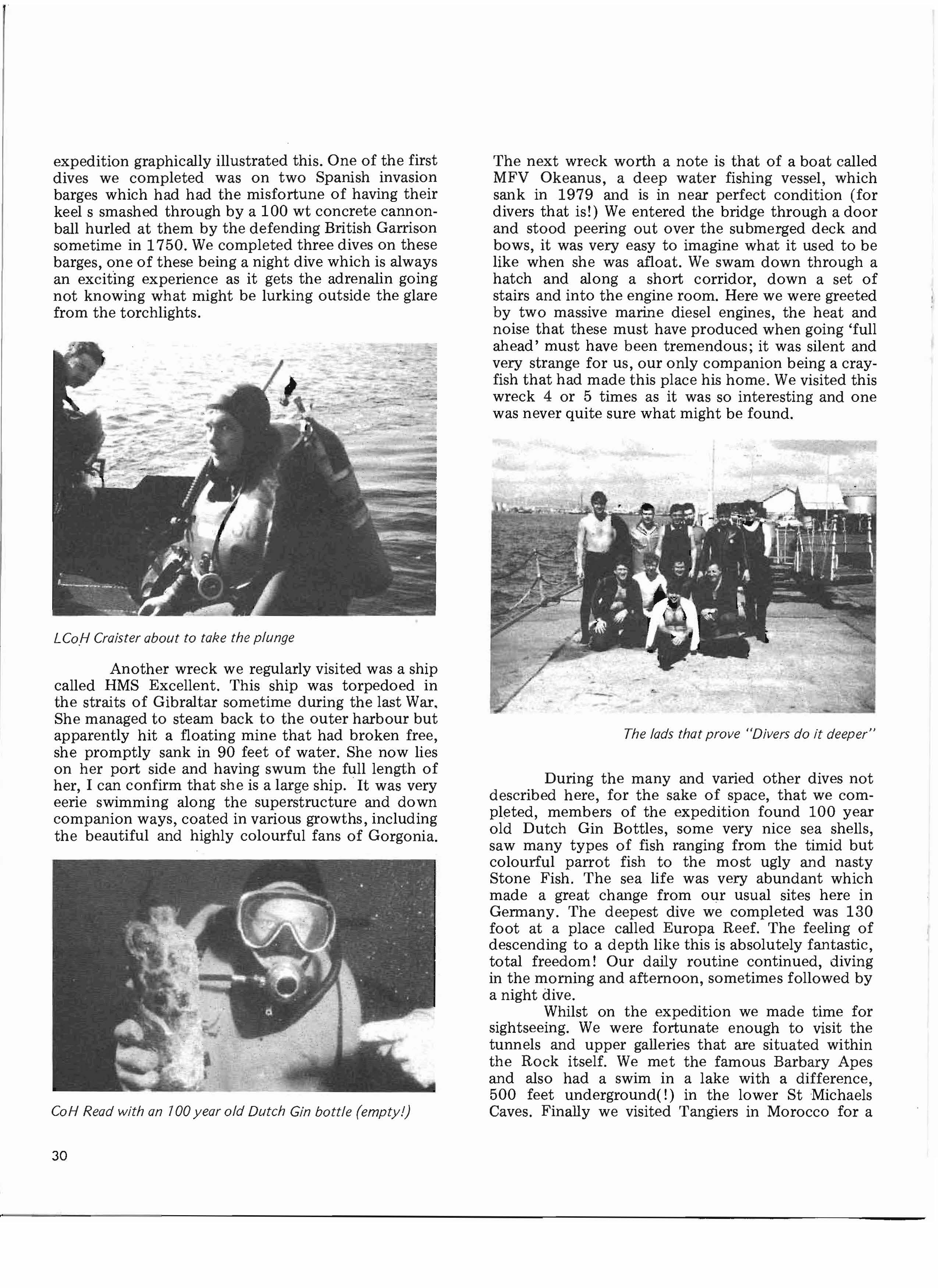
Another wreck we regularly visited was a ship called HMS Excellent. This ship was torpedoed in the straits of Gibraltar sometime during the last War. She managed to steam back to the outer harbour but apparently hit a floating mine that had broken free, she promptly sank in 90 feet of water. She now lies on her port side and having swum the full length of her, I can confirm that she is a large ship .. It was very eerie swimming along the superstructure and down companion ways, coated in various growths, including the beautiful and highly colourful fans of Gorgonia.
The next wreck worth a note is that of a boat called MFV Okeanus, a deep water fishing vessel, which sank in 1979 and is in near perfect condition (for divers that is!) We entered the bridge through a door and stood peering out over the submerged deck and bows, it was very easy to imagine what it used to be like when she was afloat. We swam down through a hatch and along a short corridor, down a set of stairs and into the engine room. Here we were greeted by two massive marine diesel engines, the heat and noise that these must have produced when going 'full ahead' must have been tremendous; it was silent and very strange for us, our only companion being a crayfish that had made this place his home. We visited this wreck 4 or 5 times as it was so interesting and one was never quite sure what might be found.
During the many and varied other dives not described here, for the sake of space, that we completed, members of the expedition found 100 year old Dutch Gin Bottles, some very nice sea shells, saw many types of fish ranging from the timid but colourful parrot fish to the most ugly and nasty Stone Fish. The sea life was very abundant which made a great change from our usual sites here in Germany. The deepest dive we completed was 130 foot at a place called Europa Reef. The feeling of descending to a depth like this is absolutely fantastic, total freedom! Our daily routine continued, diving in the morning and afternoon, sometimes followed by a night dive.
Whilst on the expedition we made time for sightseeing. We were fortunate enough to visit the tunnels and upper galleries that are situated within the Rock itself. We met the famous Barbary Apes and also had a swim in a lake with a difference, 500 feet underground(!) in the lower St Michaels Caves. Finally we visited Tangiers in Morocco for a
day. This oasis of Arab culture will not, indeed cannot, be forgotten by those that travelled there.
On our final evening we had a barbeque on the quay at Coaling Island; this was followed by a games night against the staff of the JSSADC. Some of the rules were a bit obscure, and some of the games were new to even us (drinking a pint upside down, through a snorkel tube!) but I'm pleased to report we finally won.
The following morning was spent saying far!=lwell to the friends that we had made during our brief stay, and as we boarded the plane that was to take us home, we had some fine memories of the 'Rock' and look forward to returning someday for another expedition.
CoH Richardson purchasing a new hat "just like that !"
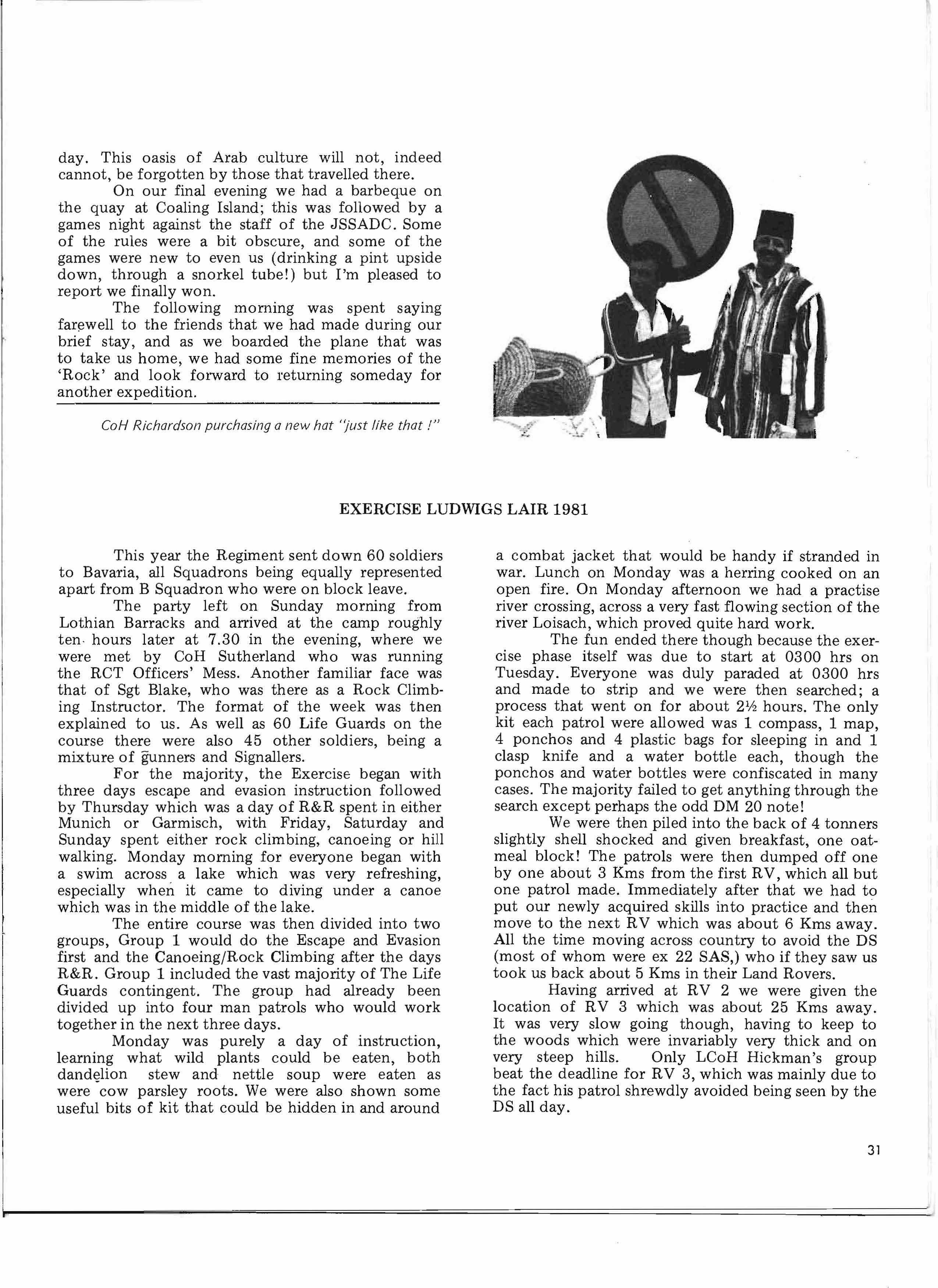
This year the Regiment sent down 60 soldiers to Bavaria, all Squadrons being equally represented apart from B Squadron who were on block leave.
The party left on Sunday morning from Lothian Barracks and arrived at the camp roughly ten- hours later at 7.30 in the evening, where we were met by CoH Sutherland who was running the RCT Officers' Mess. Another familiar face was that of Sgt Blake, who was there as a Rock Climbing Instructor. The format of the week was then explained to us. As well as 60 Life Guards on the course there were also 45 other soldiers, being a mixture of gunners and Signallers.
For the majority, the Exercise began with three days escape and evasion instruction followed by Thursday which was a day of R&R spent in either Munich or Garmisch, with Friday, Saturday and Sunday spent either rock climbing, canoeing or hill walking. Monday morning for everyone began with a swim across a lake which was very refreshing, especially when it came to diving under a canoe which was in the middle of the lake.
The entire course was then divided into two groups, Group 1 would do the Escape and Evasion first and the Canoeing/Rock Climbing after the days R&R. Group 1 included the vast majority of The Life Guards contingent. The group had already been divided up into four man patrols who would work together in the next three days.
Monday was purely a day of instruction, learning what wild plants could be eaten, both stew and nettle soup were eaten as were cow parsley roots. We were also shown some useful bits of kit that could be hidden in and around
a combat jacket that would be handy if stranded in war. Lunch on Monday was a herring cooked on an open fire. On Monday afternoon we had a practise river crossing, across a very fast flowing section of the river Loisach, which proved quite hard work. The fun ended there though because the exercise phase itself was due to start at 0300 hrs on Tuesday. Everyone was duly paraded at 0300 hrs and made to strip and we were then searched; a process that went on for about 2 112 hours. The only kit each patrol were allowed was 1 compass, 1 map, 4 ponchos and 4 plastic bags for sleeping in and 1 clasp knife and a water bottle each, though the ponchos and water bottles were confiscated in many cases. The majority failed to get anything through the search except perhaps the odd DM 20 note!
We were then piled into the back of 4 tonners slightly shell shocked and given breakfast, one oatmeal block! The patrols were then dumped off one by one about 3 Kms from the first RV, which all but one patrol made. Immediately after that we had to put our newly acquired skills into practice and then move to the next RV which was about 6 Kms away. All the time moving across country to avoid the DS (most of whom were ex 22 SAS,) who if they saw us took us back about 5 Kms in their Land Rovers. Having arrived at RV 2 we were given the location of RV 3 which was about 25 Kms away. It was very slow going though, having to keep to the woods which were invariably very thick and on very steep hills. Only LCoH Hickman's group beat the deadline for RV 3, which was mainly due to the fact his patrol shrewdly avoided being seen by the DS all day.
Eventually groups filtered into RV 3 and were given the next destination which was 8 Kms further North, and not on our maps! This proved a stumbling block for many but the majority of patrols arrived sometime or other to kill, pluck, gut and eat their chicken and sleep in their plastic bags!
In the morning we had to do an assault boat crossing across a lake which was about a 2 m paddle. Having done that we were taken back to camp in the 4 tonners where we had a simply delicious brunch, having eaten virtually nothing the day before and covered about 50 Kms over very difficult wooded terraine.
In the afternoon we had the confidence course, which had at the end of it an exhilerating death slide. The confidence course was done fastest by LCpl Thorpe's group, who were perhaps spurred on by the fact that when they were on the first
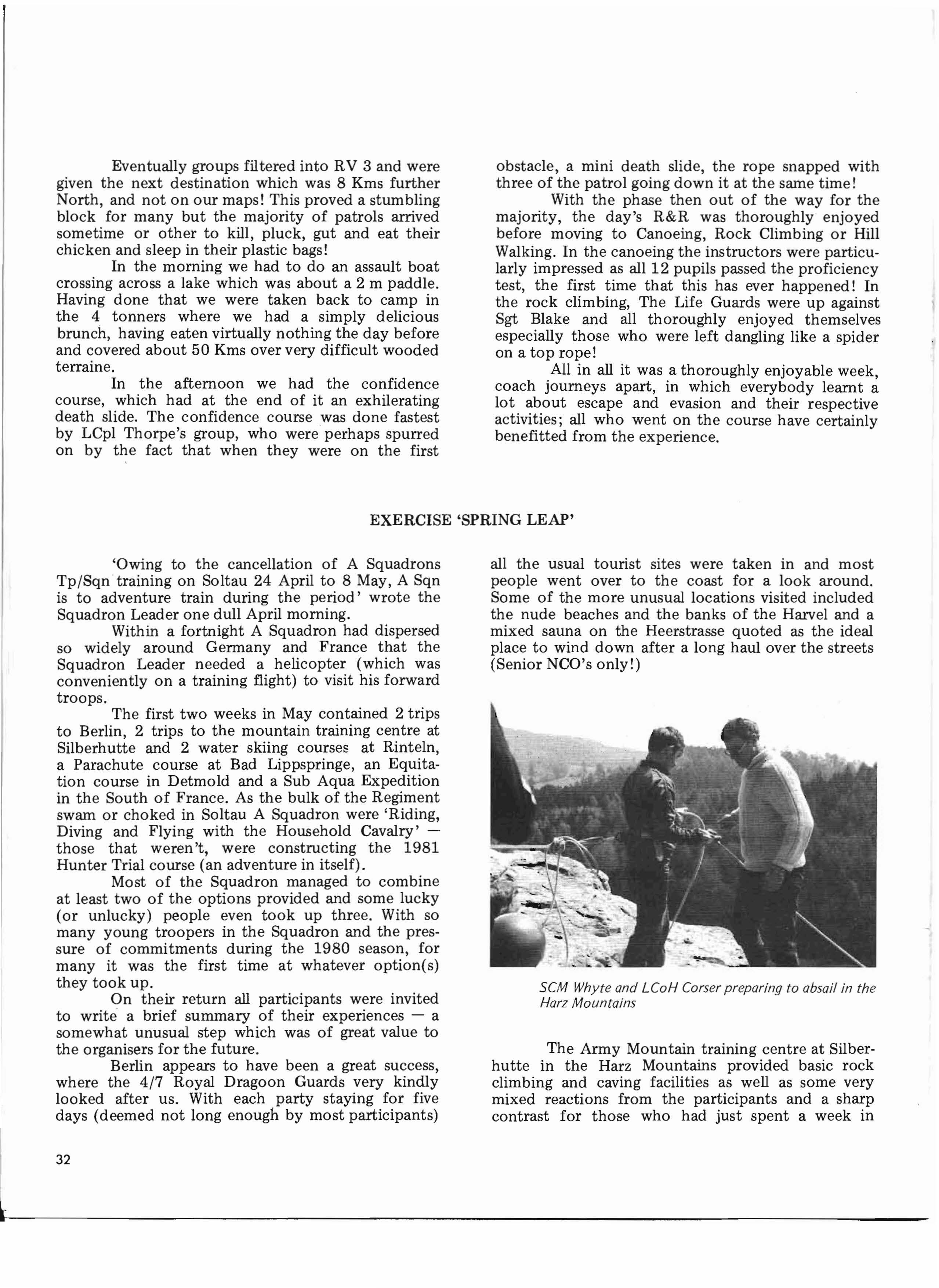
'Owing to the cancellation of A Squadrons Tp/Sqntraining on Soltau 24 April to 8 May, A Sqn is to adventure train during the period' wrote the Squadron Leader one dull April morning.
Within a fortnight A Squadron had dispersed so widely around Germany and France that the Squadron Leader needed a helicopter (which was conveniently on a training flight) to visit his forward troops.
The first two weeks in May contained 2 trips to Berlin, 2 trips to the mountain training centre at Silberhutte and 2 water skiing courses at Rinteln, a Parachute course at Bad Lippspringe, an Equitation course in Detmold and a Sub Aqua Expedition in the South of France. As the bulk of the Regiment swam or choked in Soltau A Squadron were 'Riding, Diving and Flying with the Household Cavalry' those that weren't, were constructing the 1981 Hunter Trial course (an adventure in itself).
Most of the Squadron managed to combine at least two of the options provided and some lucky (or unlucky) people even took up three. With so many young troopers in the Squadron and the pressure of commitments during the 1980 season, for many it was the first time at whatever option(s) they took up.
On their return all participants were invited to write" a brief summary of their experiences -a somewhat unusual step which was of great value to the organisers for the future.
Berlin appears to have been a great success, where the 4/7 Royal Dragoon Guards very kindly looked after us. With each party staying for five days (deemed not long enough by most participants)
obstacle, a mini death slide, the rope snapped with three of the patrol going down it at the same time! With the phase then out of the way for the majority, the day's R&R was thoroughly enjoyed before moving to Canoeing, Rock Climbing or Hill Walking. In the canoeing the instructors were particularly impressed as all 12 pupils passed the proficiency test, the first time that this has ever happened! In the rock climbing, The Life Guards were up against Sgt Blake and all thoroughly enjoyed themselves especially those who were left dangling like a spider on a top rope!
All in all it was a thoroughly enjoyable week, coach journeys apart, in which everybody learnt a lot about escape and evasion and their respective activities; all who went on the course have certainly benefitted from the experience.
all the usual tourist sites were taken in and most people went over to the coast for a look around. Some of the more unusual locations visited included the nude beaches and the banks of the Harvel and a mixed sauna on the Heerstrasse quoted as the ideal place to wind down after a long haul over the streets (Senior NCO's only!)
The Army Mountain training centre at Silberhutte in the Harz Mountains provided basic rock climbing and caving facilities as well as some very mixed reactions from the participants and a sharp contrast for those who had just spent a week in
Berlin. The whole experience was possibly best summed up by Tpr Walker
"I went rock climbing and pot holing. The rock climbing was quite enjoyable although I got the shakes. Absailing was very enjoyable but I would let go of the rope and land on my morals and it was very painfaul. Pot holing is a stupid pastime/sport getting stuck and wet. They say the Irish are thick but if you go pot holling you are thicker that is my opinion as I kept getting stuck and LCpl Stiff kept standing on me "
The SCM excelled in catching and dropping most of the Squadron (in what is not quite clear).
The water skiing course at Varenholz near Rinteln was run by Lt Perry-Warnes. Unlike conventional water skiing where one is towed by a power boat, the Germans have installed a fiendish ski-tow circuit around an artificial lake, comparable to the more familiar ski lifts seen at mountain resorts. The right angled corners defeated even the hardened UNFICYP hands initially, however almost everyone managed to beat the system on two or less skis by the end (the first corner being the most distant point in the lake). The water has been described as cool by some, arctic by others.
The parachuting at Bad Lippspringe (one of the best DZ's in Europe) was run by the Squadron suicide officer Capt Dyson who is completely addicted. Though low cloud dogged the early days of the course twelve normally quite sane members of the Squadron left a perfectly airworthy plane at 1500 ft with only a few minor fractures. Post jump reports reveal the experience to be 'exhilarating' and it has at least a 10% addiction rate.

The Equitation course at Detmold went much the same way as all equitation courses, having carefully selected the most horse-shy members of the Squadron, they all thoroughly enjoyed it by the end. Apparently, boots, saddles and stirrups would have helped.
.
The Sub Aqua Expedition to Cavalaire (not a million miles from St Tropez) in the South of France must have been the 'most ambitious' of the entire fortnight. Largely thanks to CoH McKenzie (RHQ) a fanatical diver/instructor we were able to send 13 members of the Squadron to one of Europes more exotic diving locations. Information on this trip is not immediately disseminable (the stories don't tie up!) After a picturesque drive through Switzerland and Italy the party arrived on location on schedule and were introduced to the delights of Sub Aqua on relatively uncrowded (out of season) beaches. Nude beaches appear to have had the best underwater scenery - the Sub Aqua club claimed many new converts. Most of the nights I am assured were spent quietly. LCoH Steed appears to have been the only winner at Monte Carlo. Much deep water diving was done.
In all a thoroughly worthwhile and enjoyable fortnight for the Squadron. Much credit must go to Captain Sampson for some very swift organisation and our thanks to the Commanding Officer for a very generous grant which eased what would have been a relatively expensive fortnight for the Squadron.
Exercise Bamse 81 was a joint service high level ski expedition held in the Jotunheimen and Hardangavitta areas of central Norway. This trip was open to all classes of cross country skier from novice to the more experienced. There were four routes, varying from 200 to 600 kilometres, all over similar regions, the whole venture sponsored by the British Outward Bound Centre, Norway.
I was in the second or 'trade' route group and we set off from Veolli on our langlauf skis and with our 30 lb packs on a hot sunny day for our initial leg of 28 kilometres to the tourist hut at Glitterheim. This passage served to test our style and fitness and season us in some measure for what was to come.
On subsequent days we eased our somewhat complaining bodies up and down mountains, across frozen lakes and past avalanche bruised slopes. We were heading on a southerly bearing, slithering our way through the inhospitable Jotunheimen range
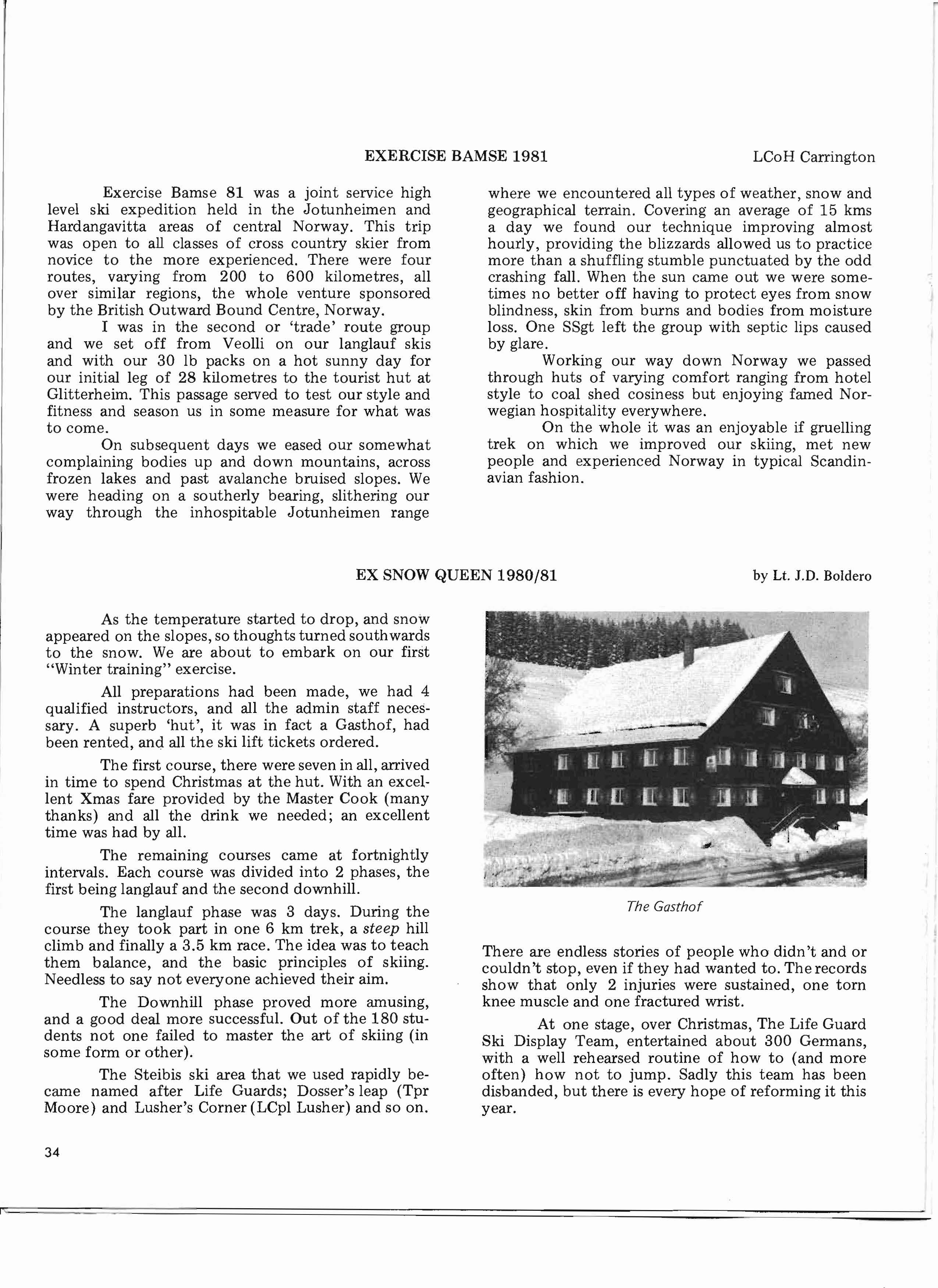
As the temperature started to drop, and snow appeared on the slopes, so thoughts turned southwards to the snow. We are about to embark on our first "Winter training" exercise.
All preparations had been made, we had 4 qualified instructors, and all the admin staff necessary. A superb 'hut', it was in fact a Gasthof, had been rented, and all the ski lift tickets ordered.
The first course, there were seven in all, arrived in time to spend Christmas at the hut. With an excellent Xmas fare provided by the Master Cook (many thanks) and all the drink we needed; an excellent time was had by all.
The remaining courses came at fortnightly intervals. Each cours(=) was divided into 2 phases, the first being langlauf and the second downhill.
The langlauf phase was 3 days. During the course they took part in one 6 km trek, a steep hill climb and finally a 3.5 km race. The idea was to teach them balance, and the basic principles of skiing. Needless to say not everyone achieved their aim.
The Downhill phase proved more amusing, and a good deal more successful. Out of the 180 students not one failed to master the art of skiing (in some form or other).
The Steibis ski area that we used rapidly became named after Life Guards; Dosser's leap (Tpr Moore) and Lusher's Corner (LCpl Lusher) and so on.
where we encountered all types of weather, snow and geographical terrain. Covering an average of 15 kms a day we found our technique improving almost hourly, providing the blizzards allowed us to practice more than a shuffling stumble punctuated by the odd crashing fall. When the sun came out we were sometimes no better off having to protect eyes from snow blindness, skin from burns and bodies from moisture loss. One SSgt left the group with septic lips caused by glare.
Working our way down Norway we passed through huts of varying comfort ranging from hotel style to coal shed cosiness but enjoying famed Norwegian hospitality everywhere.
On the whole it was an enjoyable if gruelling trek on which we improved our skiing, met new people and experienced Norway in typical Scandinavian fashion.
There are endless stories of people who didn't and or couldn't stop, even if they had wanted to. The records show that only 2 injuries were sustained, one torn knee muscle and one fractured wrist.
At one stage, over Christmas, The Life Guard Ski Display Team, entertained about 300 Gennans, with a well rehearsed routine of how to (and more often) how not to jump. Sadly this team has been disbanded, but there is every hope of reforming it this year.
Apart from skiing, the luxurious Gasthof had everything one could ask for -3 of those Space Invader machines, cards and beer on tap. For those that wanted to see how skiing was really done, there were films of the K 2 demonstration team. A number of feature films were also shown.
It would be wrong not to say a very large thank you to the various departments in Detmold "without whom", briefly, the QM's, the Master Cook, the MTO and the Paymaster.
Next season we will be down in Bavaria again and we look forward to another Ex Snow Queen. Rumour has it that the racing team will also be taking to the slopes - you have been warned.
Mr Boldera and his class. It looks easy standing up, but . ....
General The Earl of Wellington looked at the overextending French Army and exclaimed to his Staff "Marmont est perdu!" So began the battle of Salamanca and as we stood on the same spot 169 years later we reflected momentarily on our g(>od fortune to be there at all.
A few days before, six of us had set off from England in two cars to be joined in Madrid by two historians, Doctor Philip Mansel and Major John MacKenzie (retd). The latter is an expert on the Peninsular War and whilst running his own business in Madrid spends his spare time tramping over the local battlefields.
Salamanca is 150 miles to the West of Madrid and to observe Marshal Marmont's army at dawn as Wellington did, involves an early start. The day progresses and we dash on foot hither and thither. First we look at the areas in dead ground to the approaching French. These are extensive and Wellington uses them brilliantly to conceal his army and also to give the impression that his army is slipping away to the North West. Skirmishing takes place near Marmont's observation point and he wrongly concludes that this is the screen for yet another masterly Allied rearguard action.
He orders his army to move rapidly to the West in order to outflank and perhaps split Wellington's retreating forces. The whole of the British, Spanish and Portuguese forces lie or sit impatiently behind the crests to their front. Marmont can see one British Division, the 7th, languidly guarding the frontal approach. His troops rush a prominent feature, the Arapil Grande, just beating off the Portuguese who race for it too. Two British guns are
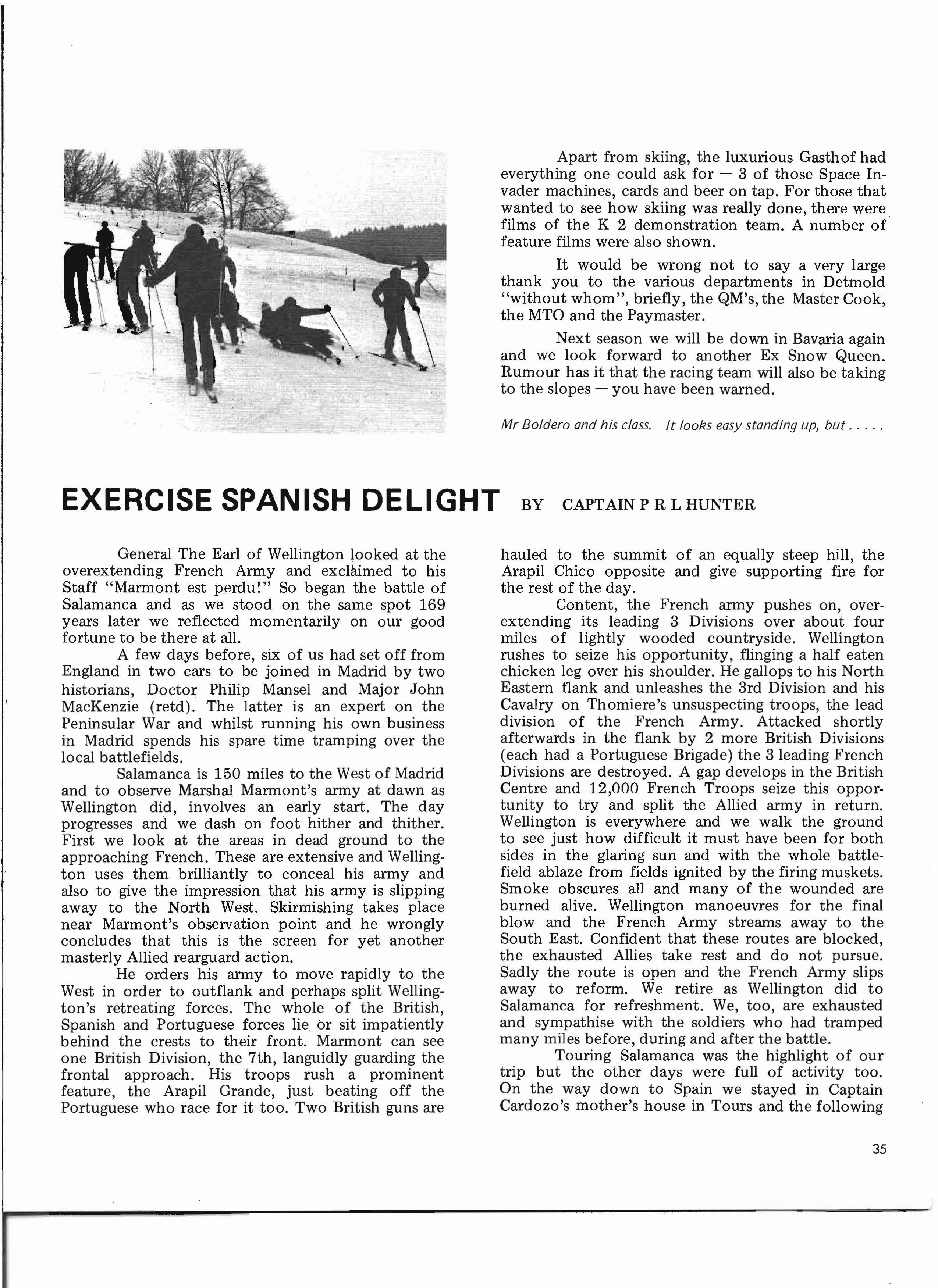
CAPTAINPRLHUNTER
hauled to the summit of an equally steep hill, the Arapil Chico opposite and give supporting fire for the rest of the day.
Content, the French army pushes on, overextending its leading 3 Divisions over about four miles of lightly wooded countryside. Wellington rushes to seize his opportunity, flinging a half eaten chicken leg over his shoulder. He gallops to his North Eastern flank and unleashes the 3rd Division and his Cavalry on Thomiere's unsuspecting troops, the lead division of the French Army. Attacked shortly afterwards in the flank by 2 more British Divisions (each had a Portuguese Brigade) the 3 leading French Divisions are destroyed. A gap develops in the British Centre and 12,000 French Troops seize this opportunity to try and split the Allied army in return. Wellington is everywhere and we walk the ground to see just how difficult it must have been for both sides in the glaring sun and with the whole battlefield ablaze from fields ignited by the firing muskets. Smoke obscures all and many of the wounded are burned alive. Wellington manoeuvres for the final blow and the French Army streams away to the South East. Confident that these routes are blocked, the exhausted Allies take rest and do not pursue. Sadly the route is open and the French Army slips away to reform. We retire as Wellington did to Salamanca for refreshment. We, too, are exhausted and sympathise with the soldiers who had tramped many miles before, during and after the battle.
Touring Salamanca was the highlight of our trip but the other days were full of activity too. On the way down to Spain we stayed in Captain Cardozo's mother's house in Tours and the following
day visited the French cavalry school at Saumur. Major Philip Beavoir 13j18H, the British Liaison Officer, met us and we were lucky enough on the Saturday morning to see a special performance of the celebrated Cadre Noir. There has been a threat to move them from the town and this performance had been specially laid on for Les Amis de Cadre Noir a group organised to prevent this. We were therefore lucky enough to see a full programme of movements forty-five minutes in length led by their Chef d 'Equipe the famous Colonel Durand. The drive into Spain took us through the Pyrenees and Basque country where needless to say, we kept our heads down. The Spanish are very hospitable and looked after us superbly wherever we went. On the Monday we visited the Guardia Civile who are nation wide paramilitary police. They showed us their equivalent of the Junior Leaders Regiment where every boy has to be a son or relation of a member of the force. They put on a very professional judo and box vaulting display and then a motorcycle show to rival the White Helmets. The finale of this was a human pyramid where as they passed the stand, two flags Spanish and British were flourished from within the mass of bodies.
At the end of the displays we were entertained to a "Copa" -a stand-up lunch with wine and hors d'oeuvres. This proved to be the pattern of all our visits and was very popular once we had all become used to it.
The Civil Guard has a mounted Squadron and we saw this on parade as well as the Municipal Police of Madrid which we visited the following day. Their dismounted band played a specially prepared medley of Scottish airs which was greatly appreciated. Their horses are evenly split bays and greys so they look symmetrical and extremely smart on parade.
The final visit we made was to the Royal Guard at the Pardo Palace outside Madrid. This was
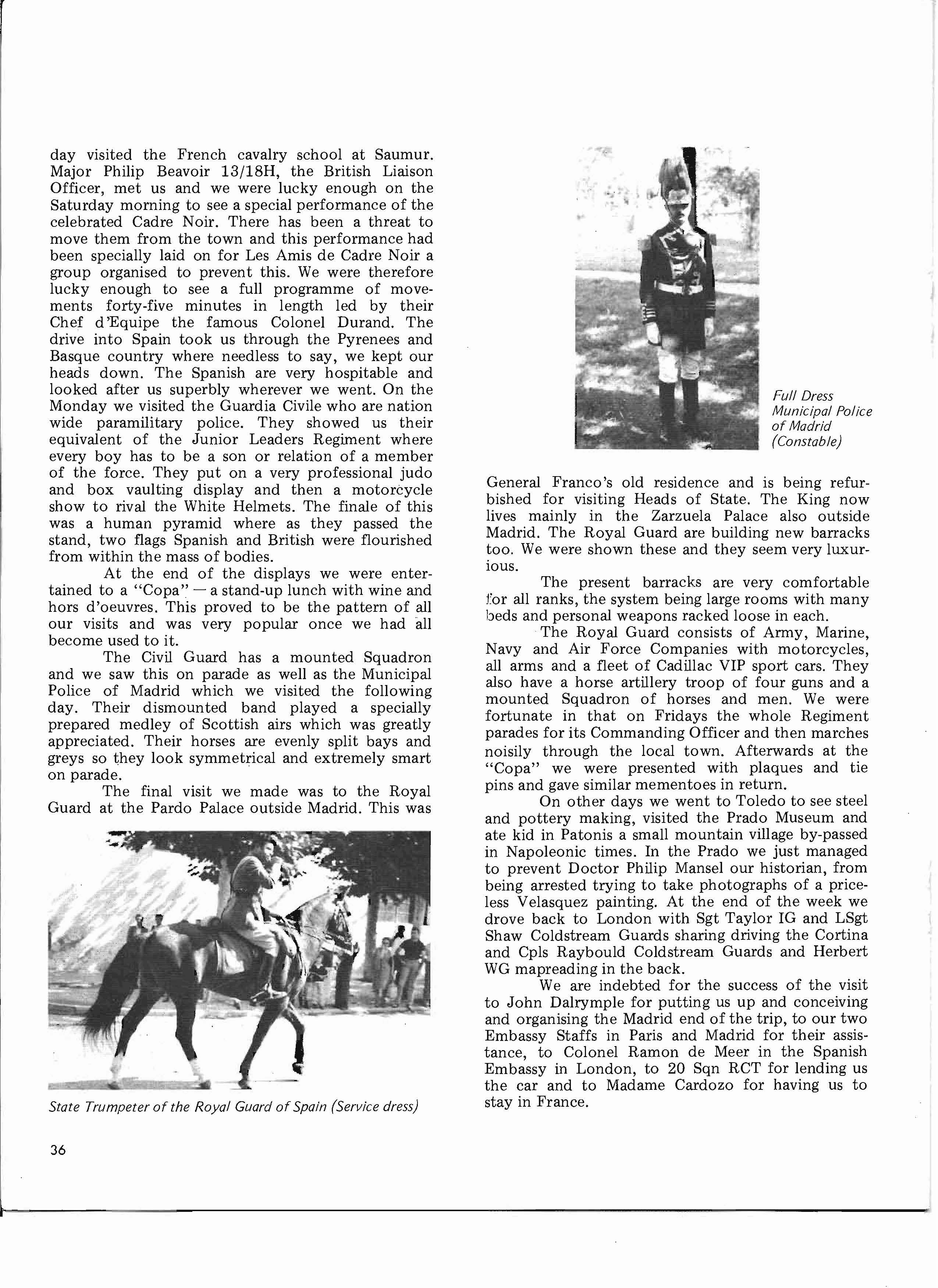
General Franco's old residence and is being refurbished for visiting Heads of State. The King now lives mainly in the Zarzuela Palace also outside Madrid. The Royal Guard are building new barracks We were shown these and they seem very luxurIOUS.
The present barracks are very comfortable for all ranks, the system being large rooms with many beds and personal weapons racked loose in each.
The Royal Guard consists of Army Marine Navy and Air Force Companies with motorcycles: all arms and a fleet of Cadillac VIP sport cars. They also have a horse artillery troop of four guns and a mounted Squadron of horses and men. We were fortunate in that on Fridays the whole Regiment parades for its Commanding Officer and then marches noisily through the local town. Afterwards at the "Copa" we were presented with plaques and tie pins and gave similar mementoes in return.
On other days we went to Toledo to see steel and pottery making, visited the Prado Museum and ate kid in Patonis a small mountain village by-passed in Napoleonic times. In the Prado we just managed to prevent Doctor Philip Mansel our historian, from being arrested trying to take photographs of a priceless Velasquez painting. At the end of the week we drove back to London with Sgt Taylor IG and LSgt Shaw Cold stream Guards sharing driving the Cortina and Cpls Raybould Cold stream Guards and Herbert WG mapreading in the back.
Weare indebted for the success of the visit to John Dalrymple for putting us up and conceiving and organising the Madrid end of the trip, to our two Embassy Staffs in Paris and Madrid for their assistance, to Colonel Ramon de Meer in the Spanish Embassy in London, to 20 Sqn RCT for lending us the car and to Madame Cardozo for having us to stay in France.
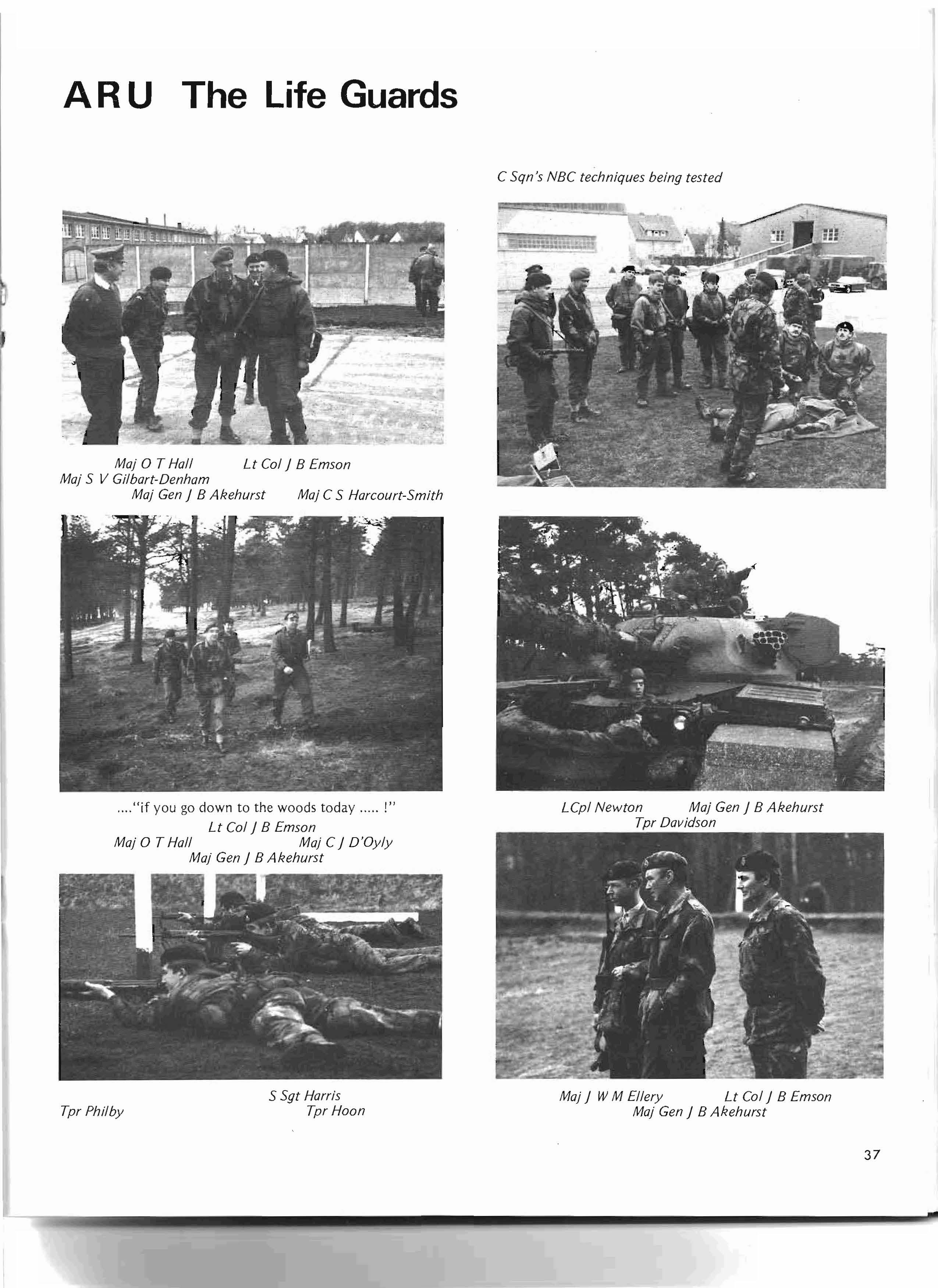
C Sqn's NBC techniques being tested
BATUS 1981 began early for the Regiment. In January to be precise. The BATUS road-show descended on BAOR, led by its intrepid leader, Colonel Dick Webster, and gave us a briefing on what to expect. It proved very use· ful, as it was many years since the Regiment was last in Canada, and some of us had never been there at all.
Thereafter there was a pause until June when pre BATUS training started in earnest. The Battle Group started getting together at Soltau, and included Y Coy I RRF, 176 (Abu Klea) Battery RA and many others. Everyone quickly settled down, and a good rapport was soon established. Our attached engineer (E 12 L) enlivened proceedings from time to time with his unusual tactical manoeuvres and provided the Battle Group with some light entertainment and the Commanding Officer with a few grey hairs.
In early July the advance parties left, courtesy of the RAF via Gutersloh. Parkas and sleeping bags were carried for the journey. Quote by the MTO "You've got to take sleeping bags and parkas. If the aircraft force-lands in the Arctic there are plenty of polar bears and seals. But there is no 'R' in the month so you are not allowed to shoot them".
The journey out went well for all parties. Jet-lag didn't help, but the Adjutant solved his with a massive intraveinous injection of whisky, which worked a treat. We took over from the Grenadiers who gave us a marvellous handover. Training then started in earnest, and the Battle Group split into its component parts for the initial training. We got to know exercises Willett, Pronghorn, Chinook and many others.
1981
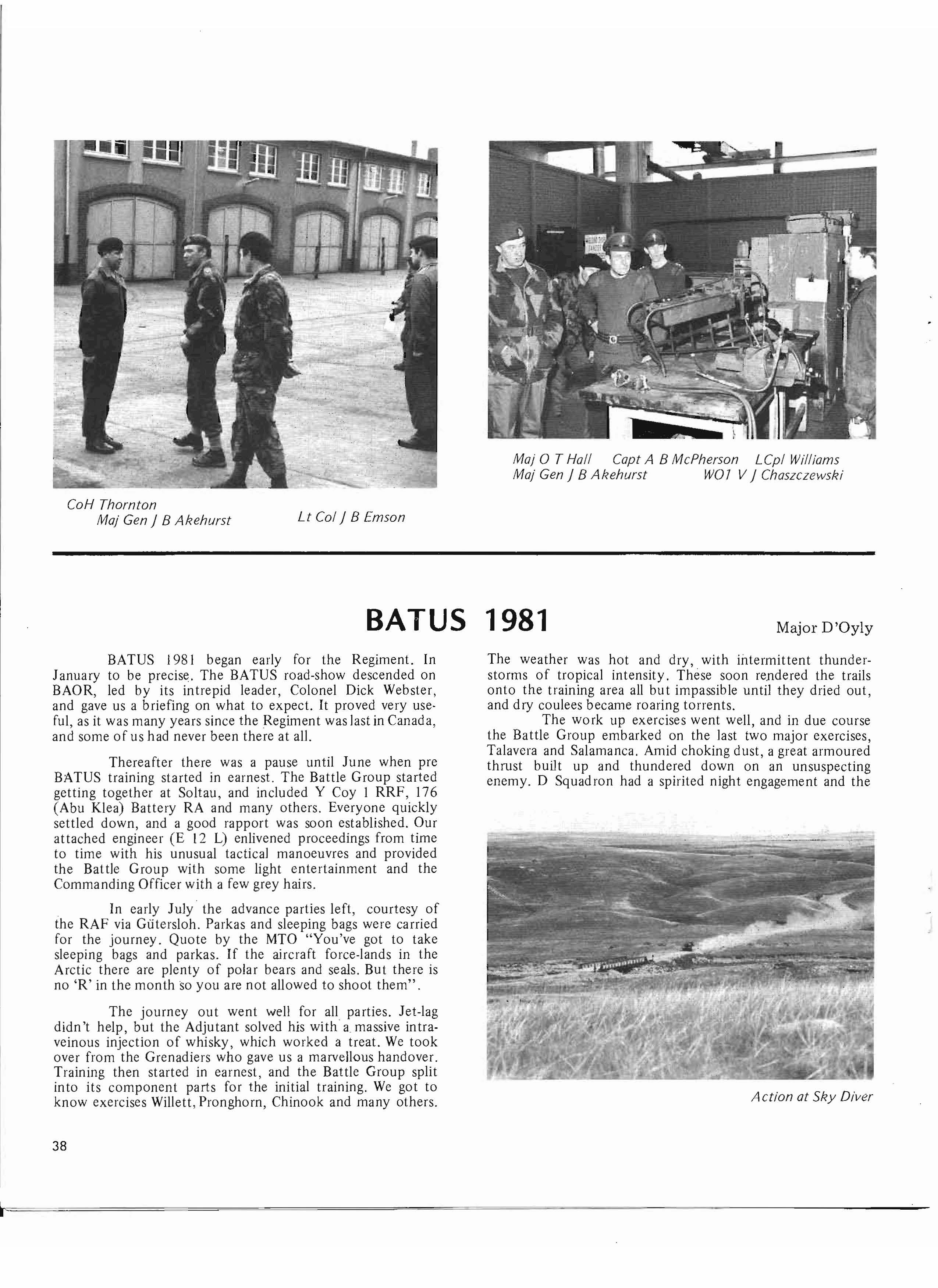
Major D 'Oyly
The weather was hot and dry, with intermittent thunderstorms of tropical intensity. These soon rendered the trails onto the training area all bu t impassible until they dried out, and dry coulees became roaring torrents.
The work up exercises went well, and in due course the Battle Group embarked on the last two major exercises, Talavera and Salamanca. Amid choking dust, a great armoured thrust built up and thundered down on an unsuspecting enemy. D Squadron had a spirited night engagement and the
phew !- that was close!"
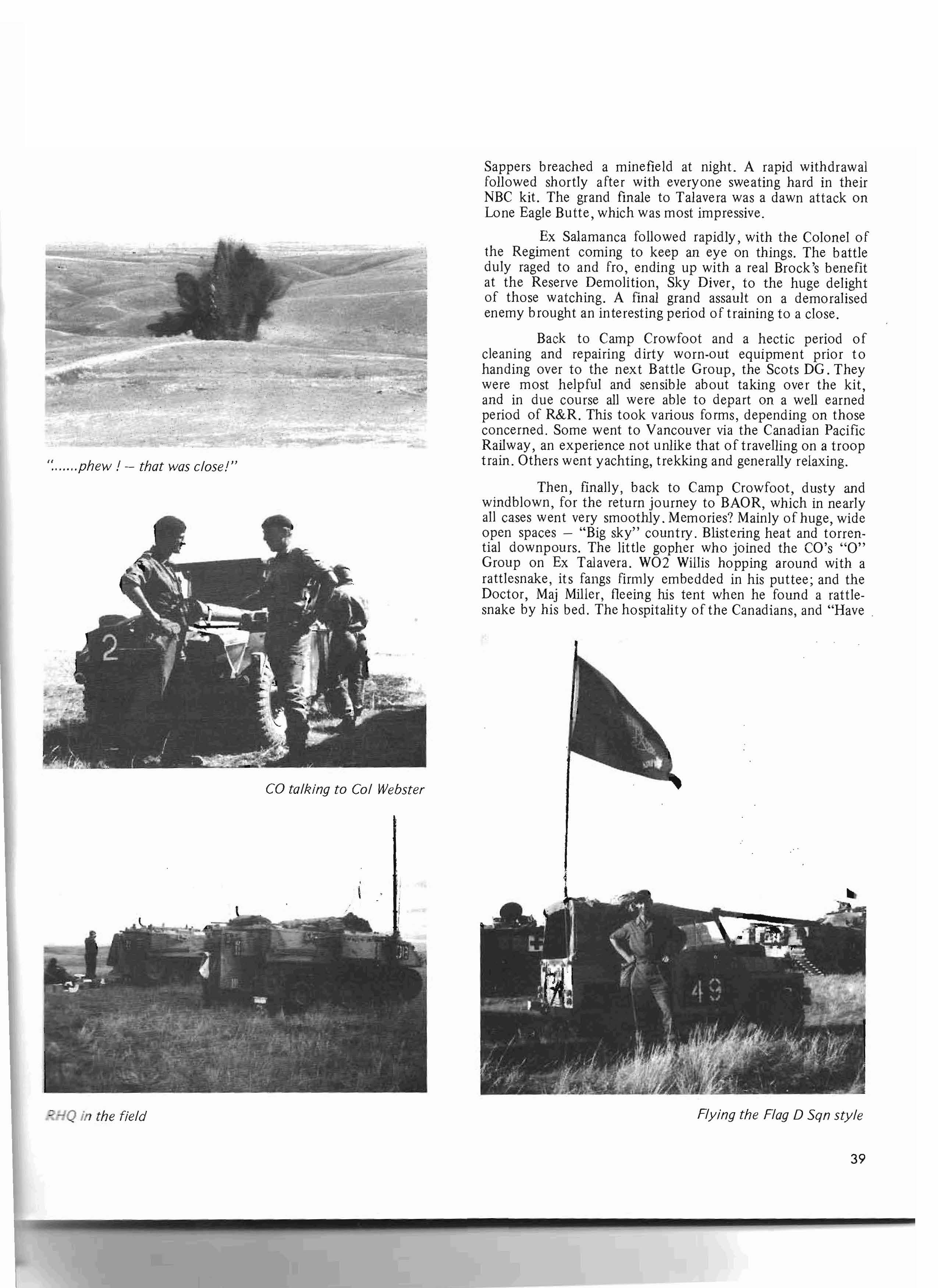
Sappers breached a minefield at night. A rapid withdrawal followed shortly after with everyone sweating hard in their NBC kit. The grand finale to Talavera was a dawn attack on Lone Eagle Butte, which was most impressive.
Ex Salamanca followed rapidly, with the Colonel of the Regiment coming to keep an eye on things. The battle duly raged to and fro, ending up with a real Brock's benefit at the Reserve Demolition, Sky Diver, to the huge delight of those watching. A final grand assault on a demoralised enemy brought an interesting period of training to a close.
Back to Camp Crowfoot and a hectic period of cleaning and repairing dirty worn-out equipment prior to handing over to the next Battle Group, the Scots DG. They were most helpful and sensible about taking over the kit, and in due course all were able to depart on a well earned period of R&R. This took various forms, depending on those concerned. Some went to Vancouver via the Canadian Pacific Railway, an experience not unlike that of travelling on a troop train. Others went yachting, trekking and generally relaxing.
Then, finally, back to Camp Crowfoot, dusty and windblown, for the return journey to BAOR, which in nearly all cases went very smoothly. Memories? Mainly of huge, wide open spaces - "Big sky" country. Blistering heat and torrential downpours. The little gopher who joined the CO's "0" Group on Ex Talavera. W02 Willis hopping around with a rattlesnake, its fangs firmly embedded in his puttee; and the Doctor, Maj Miller, fleeing his tent when he found a rattlesnake by his bed. The hospitality of the Canadians, and "Have
a nice day!" But above all it can truly be said that BATUS provides the most realistic armoured training the British Army has.
And a final footnote. B Sqn, who went to BATUS later with 1 RRF Battle Group, shot their way to becoming the British Army champions at APDS shooting, with a total of 93% hits. Well done!
I have watched you training on Exercise Talavera and exercise Salamanca with great interest and have been greatly impressed with all the energy and enthusiasm which you put into it all. You have benefited greatly by Ex Medicine Man which must have been the best concentrated training package most of you will have undergone. Given more time even more strides could be made and training standards improved still further. But you will remember I said at the end of Ex Moonlight charge that the prairie would be a test. That test was whether or not at the end of it you could consider the BG fit for war. You can: it is. Enjoy your R&R.
2 Lieutenant WA Soames
After the end of Exercise Medicine Man 4, when most of the Battle group flew back to BAOR, a party of 100 soldiers went west to the Rockies for two weeks Adventure Training. The tented base camp was situated on the North shore of Lake Abraham, about halfway between Jasper and Banff, and was administrated by SCpl Richards. The activities were as follows: white water canoeing, trekking, rock and ice climbing, rafting, pot holing and ski mountaineering. Every soldier spent three days on each of the four activities and a select few went skiing. Instructors were drawn from all arms of the Battle group, with 2Lts So ames and Tuson REME going from the Regiment.
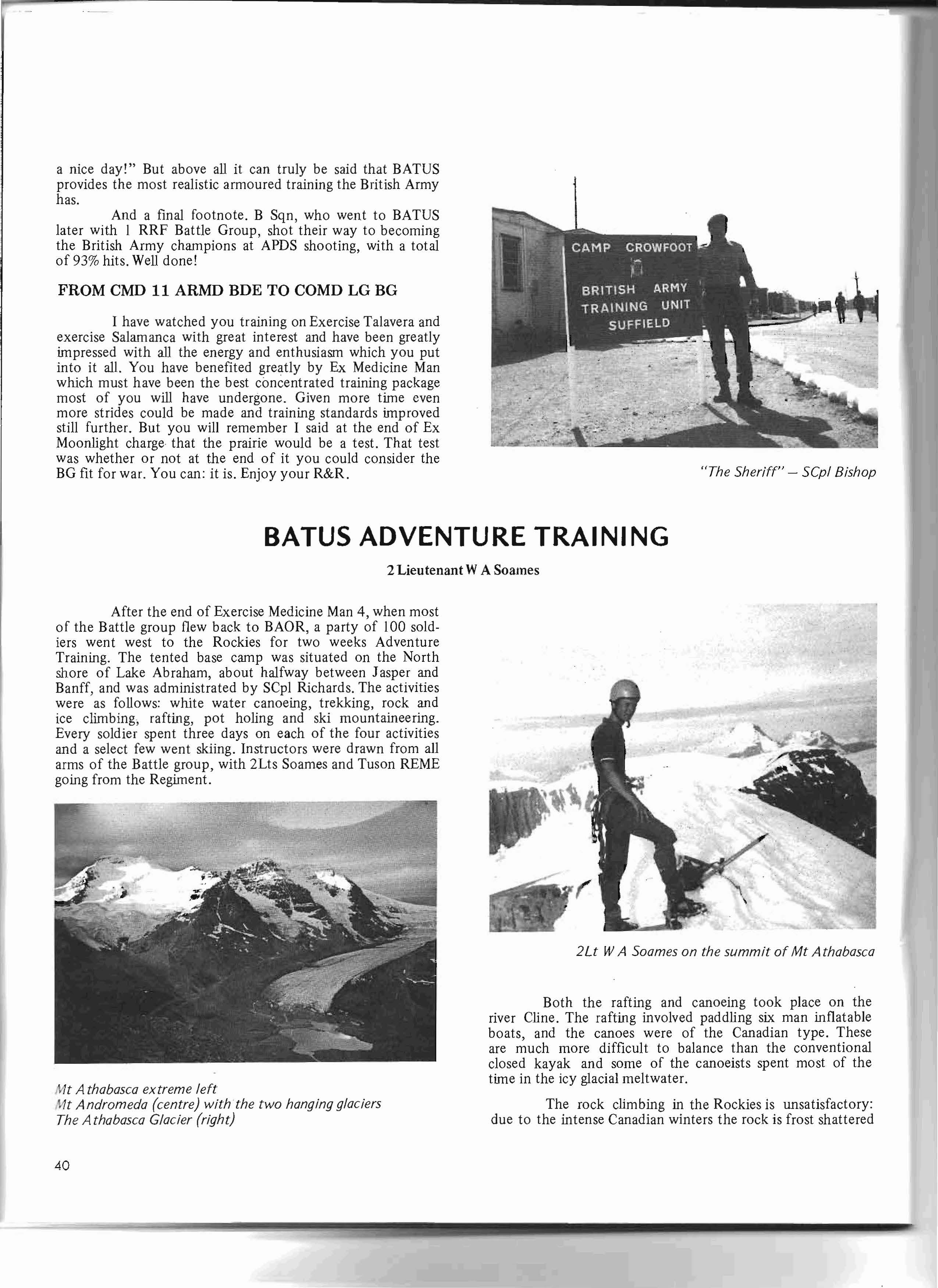
Both the rafting and canoeing took place on the river Cline. The rafting involved paddling six man inflatable boats, and the canoes were of the Canadian type. These are much more difficult to balance than the conventional closed kayak and some of the canoeists spent most of the time in the icy glacial meltwater.
The rock climbing in the Rockies is unsatisfactory: due to the intense Canadian winters the rock is frost shattered
and friable. Therefore, most of the time was spent ice climbing on the Athabasca Glacier. Ice was a completely new medium for the soldiers and they thoroughly enjoyed exploring the glacier with their crampons and ice axe. The basics were taught amongst the crevasses of the Athabasca glacier itself, and ice climbing on a small hanging glacier. It was originally intended to take the best students up Mount Athabasca (11058 ft), but the weather closed in and the route was only climbed by Lieutenant D Sperry (Royal Engineers) and 2Lt W.A. Soames.
Perhaps the most adventurous of all the activities was the ski-mountaineering. This took place on the Columbia icefield and the trip took in five peaks over 8,000 ft. The soldiers used downhill skis and spent the nights in Alpine style huts.
We packed up the camp just as the first snows of winter were following on the lower peaks and within two days most of us were to be out on Exercise Certain Encounter.
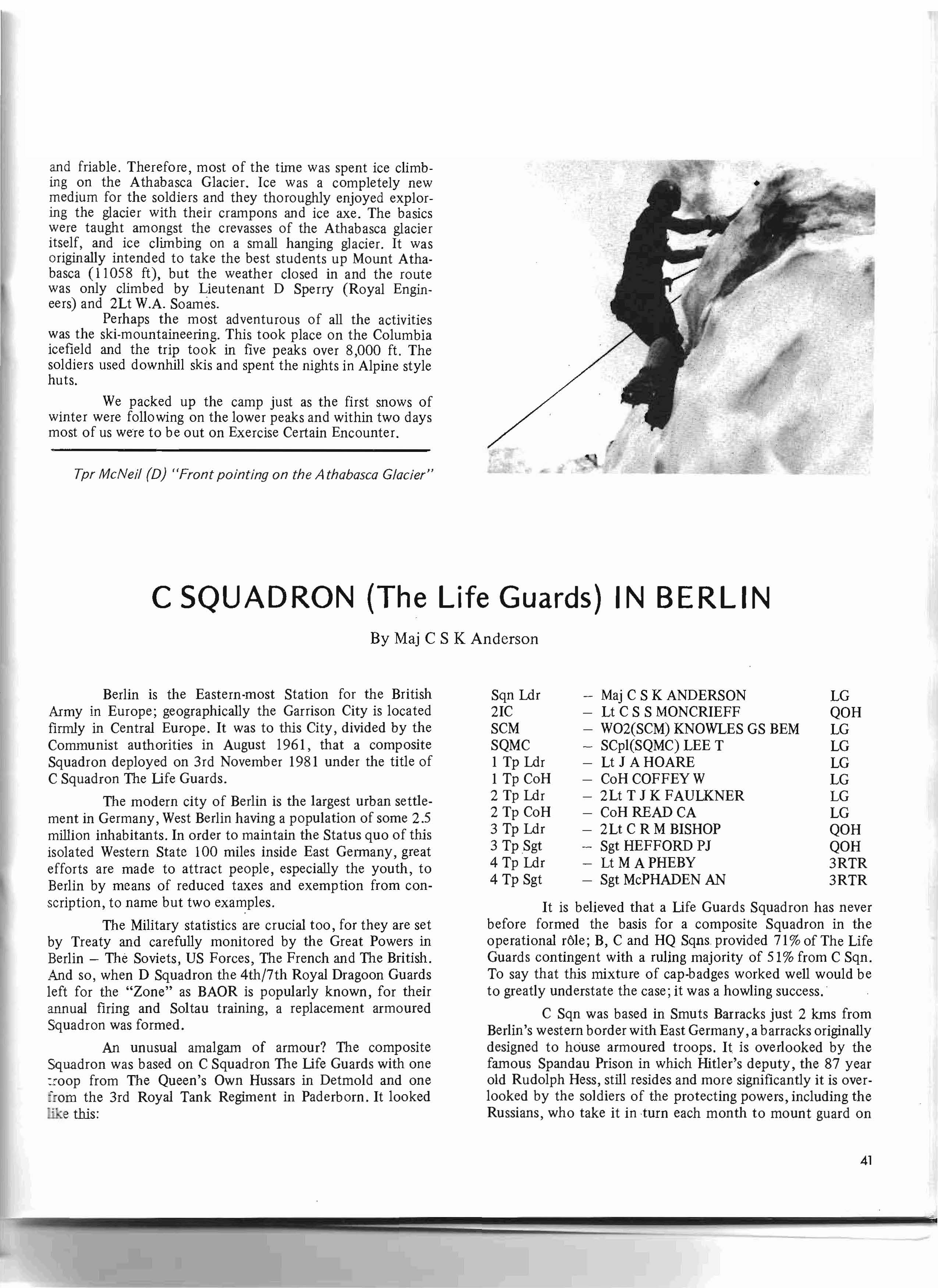
By Maj C S K Anderson
Berlin is the Eastern-most Station for the British Army in Europe; geographically the Garrison City is located firmly in Central Europe. It was to this City, divided by the Communist authorities in August 1961, that a composite Squadron deployed on 3rd November 1981 under the title of C Squadron The Life Guards.
The modern city of Berlin is the largest urban settlement in Germany, West Berlin having a population of some 2.5 million inhabitants. In order to maintain the Status quo of this isolated Western State 100 miles inside East Germany, great efforts are made to attract people, especially the youth, to Berlin by means of reduced taxes and exemption from conscription, to name but two examples.
The Military statistics are crucial too, for they are set by Treaty and carefully monitored by the Great Powers in Berlin - The Soviets, US Forces, The French and The British. And so, when D Squadron the 4th/7th Royal Dragoon Guards left for the "Zone" as BAOR is popularly known, for their annual firing and Soltau training, a replacement armoured Squadron was formed.
An unusual amalgam of armour? The composite Squadron was based on C Squadron The Life Guards with one :roop from The Queen's Own Hussars in Detmold and one Grom the 3rd Royal Tank Regiment in Paderborn. It looked 'e this:
Sqn Ldr
2IC
Maj C S K ANDERSON
Lt C S S MONCRIEFF
SCM W02(SCM) KNOWLES GS BEM SQMC SCpl(SQMC) LEE T
I Tp Ldr Lt J A HOARE
I Tp CoH CoHCOFFEYW
2 Tp Ldr - 2Lt T J K FAULKNER
2 Tp CoH - CoHREADCA
3 Tp Ldr 2Lt C R M BISHOP
3 Tp Sgt Sgt HEFFORD PJ
4 Tp Ldr Lt MAPHEBY
4 Tp Sgt Sgt McPHADEN AN
It is believed that a Life Guards Squadron has never before formed the basis for a composite Squadron in the operational r6le; B, C and HQ Sqns provided 71 % of The Life Guards contingent with a ruling majority of 51 % from C Sqn. To say that this mixture of cap-badges worked well would be to greatly understate the case; it was a howling success.
C Sqn was based in Smuts Barracks just 2 kms from Berlin's western border with East Germany, a barracks originally designed to house armoured troops. It is overlooked by the famous Spandau Prison in which Hitler's deputy, the 87 year old Rudolph Hess, still resides and more significantly it is overlooked by the soldiers of the protecting powers, including the Russians, who take it in ·turn each month to mount guard on
Backs to the Wall A random group at the Brandenburg Gate
the prison -a sobering thought. The Sqn Lelr was fortunate to have been invited to lunch in Spandau at the guard-changeover between the Russians and the Americans.
Berlin is a hectic posting for the armoured Sqn: the only British tanks in Berlin are crawled over by every military -isitor to the Garrison. They feature on every parade, take part If! every exercise and are permanently subject to Alert duties au call out. Allied to this operational requirement is the imense social activity of life in Berlin; it is not difficult to "lieve that there are 5 ,000 clubs and restaurants in the city or difficult to believe that the Squadron visited most of
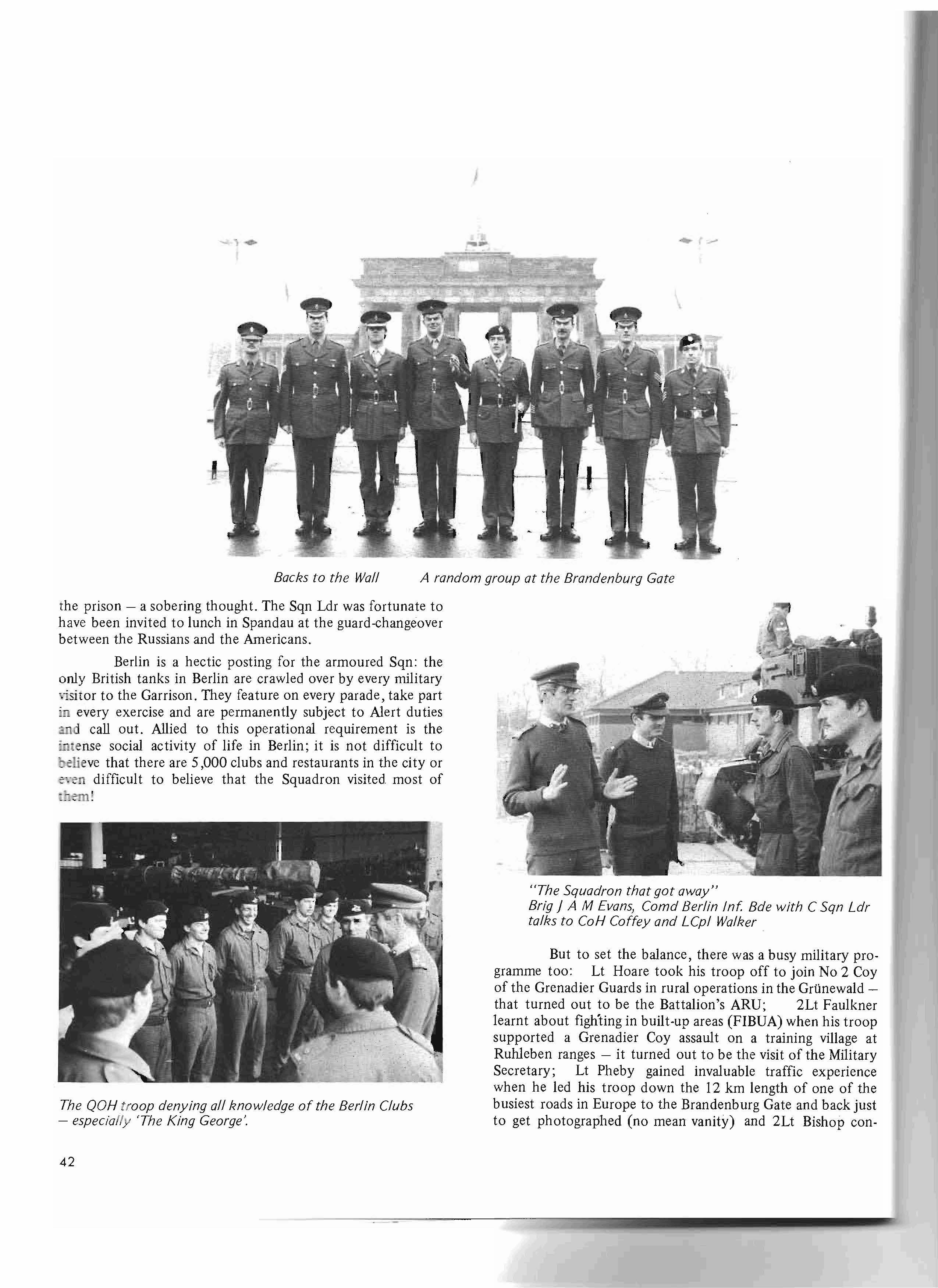
"The Squadron that got away" Brig JAM Evans, Comd Berlin Inf Bde with C Sqn Ldr talks to CoH Coffey and LCpl Walker
But to set the balance, there was a busy military programme too: Lt Hoare took his troop off to join No 2 Coy of the Grenadier Guards in rural operations in the Grunewaldthat turned out to be the Battalion's ARU; 2Lt Faulkner learnt about figh'ting in built-up areas (FIBUA) when his troop supported a Grenadier Coy assault on a training village at RuWeben ranges - it turned out to be the visit of the Military Secretary; Lt Pheby gained invaluable traffic experience when he led his troop down the 12 km length of one of the busiest roads in Europe to the Brandenburg Gate and back just to get photographed (no mean vanity) and 2Lt Bishop con
sumed vodka and played cards with a Soviet Officer at the East German railway station of Marienborn -a significant military contribution topped only by his commanding a border patrol on the following day.
The Education Tours, conducted by 46 AEC, of West and East Berlin set the scene in excellent detail and the RMP briefs to both the Advance and the Main parties on arrival let us know which un savoury clubs we should not frequent. (Which we took to mean not visit more than once!) NCOs and Officers joined Flag Tours to East Berlin and numerous members of the squadron joined helicopter patrols around the 126 mile perimeter of the East German border and the 26 mile long Wall between the Soviet Zone and the three Western sectors.
And then there was the BFT, APWT, assault courses and confidence area to crack when the sporting gladiators of the squadron were not packing the Smuts Barracks football, rugby and hockey teams each week. Let it be added that the programme was expertly administered by the Sqn Second in Command, Lt C S S Moncrieff, with his hyperactive hound Rupert in direct support.
Amid all activities undertaken by a very composite and very close-knit squadron, we were delighted to wel-
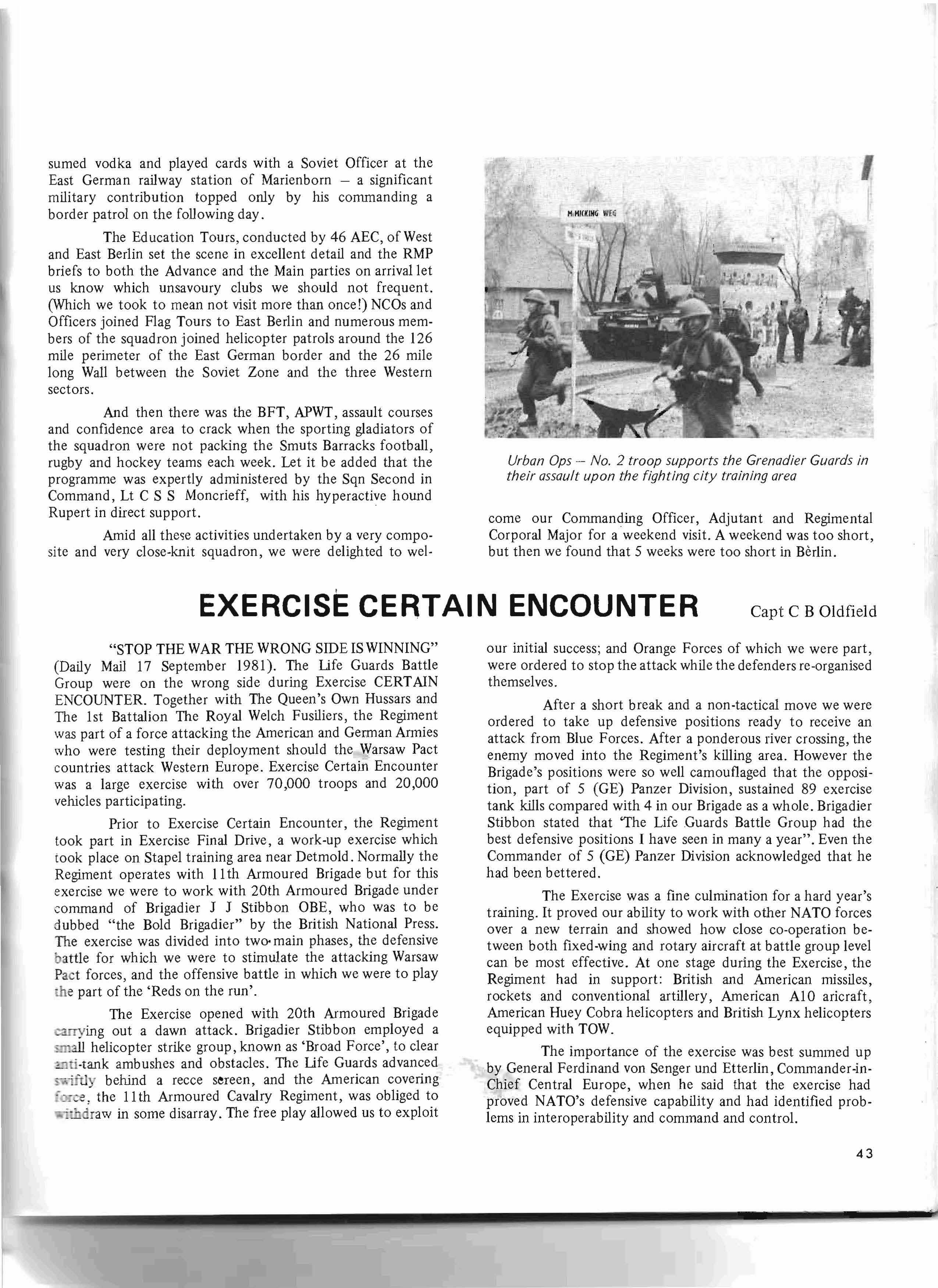
Ops - No, 2 troop supports the Grenadier Guards in their assault upon the fighting city training area
come our Commanding Officer, Adjutant and Regimental Corporal Major for a weekend visit. A weekend was too short, but then we found that 5 weeks were too short in Berlin.
"STOP THE WAR THE WRONG SIDE IS WINNING"
(Daily Mail 17 September 1981). The Ufe Guards Battle Group were on the wrong side during Exercise CERTAIN ENCOUNTER. Together with The Queen's Own Hussars and The 1st Battalion The Royal Welch Fusiliers, the Regiment was part of a force attacking the American and German Armies who were testing their deployment should the Warsaw Pact countries attack Western Europe. Exercise Certain Encounter was a large exercise with over 70,000 troops and 20,000 vehicles participating.
Prior to Exercise Certain Encounter, the Regiment took part in Exercise Final Drive, a work-up exercise which took place on Stapel training area near Detmold. Normally the Regiment operates with II th Armoured Brigade but for this exercise we were to work with 20th Armoured Brigade under command of Brigadier J J Stibbon OBE, who was to be dubbed "the Bold Brigadier" by the British National Press. The exercise was divided into two< main phases, the defensive battle for which we were to stimulate the attacking Warsaw Pact forces, and the offensive battle in which we were to play ihe part of the 'Reds on the run'.
The Exercise opened with 20th Armoured Brigade carrying out a dawn attack. Brigadier Stibbon employed a _ 11 helicopter strike group, known as 'Broad Force', to clear , '-tank ambushes and obstacles. The Ufe Guards advanced ,- y bemnd a recce sere en , and the American covering ;e. the 11 th Armoured Cavalry Regiment, was obliged to 'raw in some disarray. The free play allowed us to exploit
our initial success; and Orange Forces of which we were part, were ordered to stop the attack while the defenders re-organised themselves.
After a short break and a non-tactical move we were ordered to take up defensive positions ready to receive an attack from Blue Forces. After a ponderous river crossing, the enemy moved into the Regiment's killing area. However the Brigade's positions were so well camouflaged that the opposition, part of 5 (GE) Panzer Division, sustained 89 exercise tank kills compared with 4 in our Brigade as a whole. Brigadier Stibbon stated that 'The Life Guards Battle Group had the best defensive positions I have seen in many a year". Even the Commander of 5 (GE) Panzer Division acknowledged that he had been bettered.
The Exercise was a fine culmination for a hard year's training. It proved our ability to work with other NATO forces over a new terrain and showed how close co-operation between both fixed-wing and rotary aircraft at battle group level can be most effective. At one stage during the Exercise, the Regiment had in support: British and American missiles, rockets and conventional artillery, American AIO aricraft, American Huey Cobra helicopters and British Lynx helicopters equipped with TOW.
The importance of the exercise was best summed up by General Ferdinand von Senger und Etterlin, Commander-inChief Central Europe, when he said that the exercise had proved NATO's defensive capability and had identified problems in interoperability and command and control.
BY MAJOR A P DE RIITER
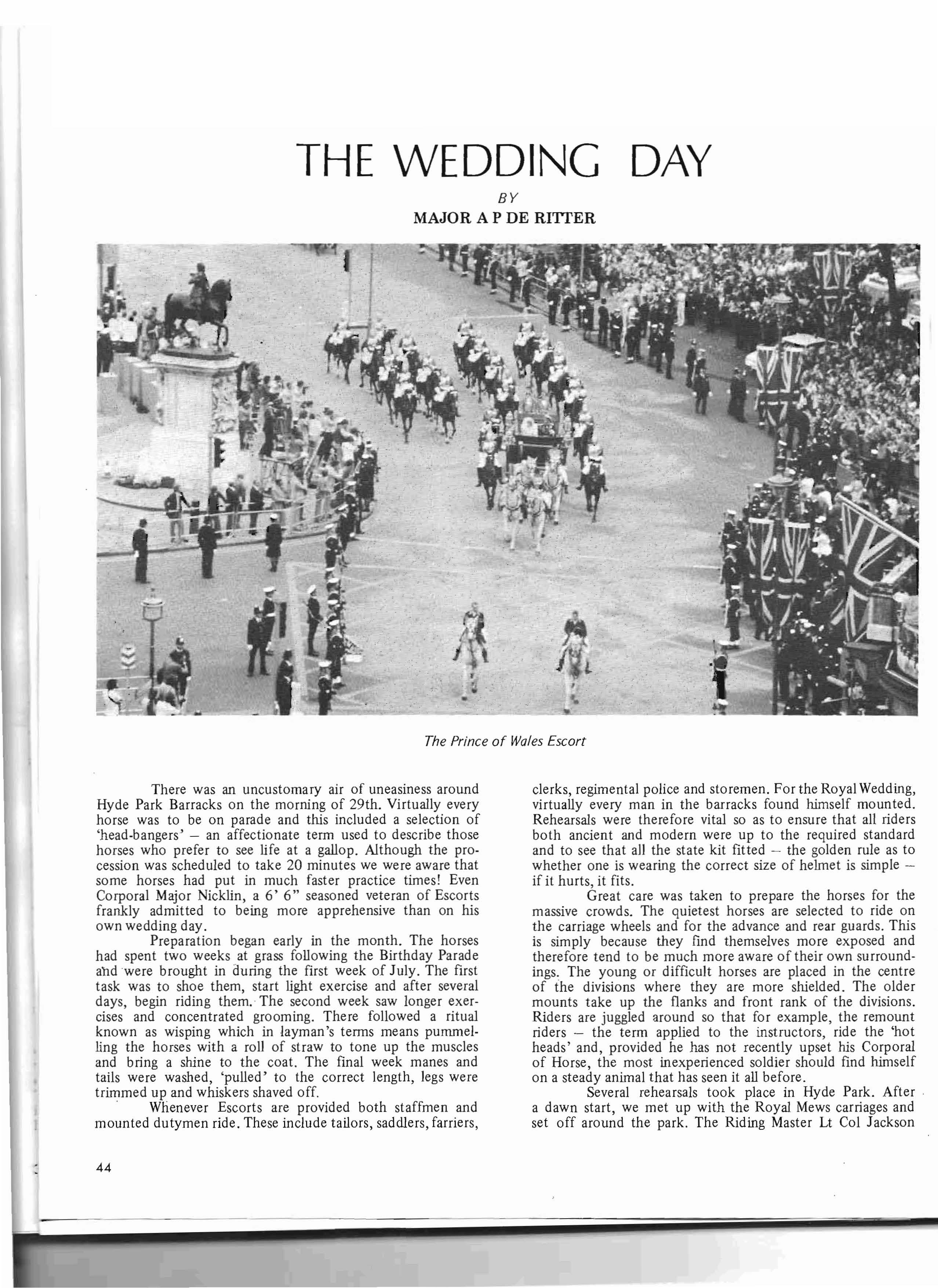
There was an uncustomary air of uneasiness around Hyde Park Barracks on the morning of 29th. Virtually every horse was to be on parade and this included a selection of 'head-bangers' - an affectionate term used to describe those horses who prefer to see life at a gallop. Although the procession was scheduled to take 20 minutes we were aware that some horses had put in much faster practice times! Even Corporal Major Nicklin, a 6' 6" seasoned veteran of Escorts frankly admitted to being more apprehensive than on his own wedding day.
Preparation began early in the month. The horses had spent two weeks at grass following the Birthday Parade ahdwere brought in auring the first week of July. The first task was to shoe them, start light exercise and after several days, begin riding them. The second week saw longer exercises and concentrated grooming. There followed a ritual known as wisping which in layman's terms means pummelling the horses with a roll of straw to tone up the muscles and bring a shine to the coat. The final week manes and tails were washed, 'pulled' to the correct length, legs were trimmed up and whiskers shaved off.
Whenever Escorts are provided both staffmen and mounted dutymen ride. These include tailors, saddlers, farriers,
clerks, regimental police and storemen. For the Royal Wedding, virtually every man in the barracks found himself mounted. Rehearsals were therefore vital so as to ensure that all riders both ancient and modern were up to the required standard and to see that all the state kit fitted - the golden rule as to whether one is wearing the COrrect size of helmet is simpleif it hurts, it fits.
Great care was taken to prepare the horses for the massive crowds. The quietest horses are selected to ride on the carriage wheels and for the advance and rear guards. This is simply because they find themselves more exposed and therefore tend to be much more aware of their own surroundings. The young or difficult horses are placed in the centre of the divisions where they are more shielded. The older mounts take up the flanks and front rank of the divisions. Riders are juggled around so that for example, the remount riders - the term applied to the instructors, ride the 'hot heads' and, provided he has not recently upset his Corporal of Horse, the most inexperienced soldier should find himself on a steady animal that has seen it all before.
Several rehearsals took place in Hyde Park. After a dawn start, we met up with the Royal Mews carriages and set off around the park. The Riding Master Lt Col Jackson
Major de Ritter, SCM McGlaughlin, CoH Robertson
who had. trained each and every man and horse on parade, cantered back and forth alongside the divisions growling at all and sundry. In this way, he rapidly transformed something which resembled the Calgary stampede into the Household Cavalry in Escort formation. Along the Serpentine Road loudspeakers, bands and a 'rent-a-crowd' with flag waving children lay in wait. The Escorts walked and trotted through this barrage u'ntil we were satisfied that the right 'mix' had been achieved.
There followed a series of briefings and recces given by the Commanding Officer, the Adjutant and the Police.
The Lord Chamberlain's Rehearsal for all those taking part took place on the morning of Sunday 26th. It was reported that 10,000 spectators lined the processional route.
The Household Cavalry found two Escorts. A Sovereign's Escort commanded by the Commanding Officer with the Standards of The Blues and Royals and The Life Guards and a Prince of Wales' Escort commanded by Major A P De Ritter. On the return journey from St Paul's The Blues and Royals Guidon was also carried because The Queen and Prince Philip .rode in a separate carriage and each are entitled to a Standard Party in addition to Queen Elizabeth The Queen Mother.
The day of the Wedding began for us at 0430 hours. Under the eye of ITN cameras, the stables were mucked out and some of the worst horses exercised in the riding school. There followed a period of intense activity - horses were groomed; manes and tails brushed out, white socks chalked up and hooves oiled. Cingerly the highly polished tack is fitted, ,he brasses given a final rub, the white girths touched up, sheepskins fitted and tail bandages sec)Jred. For a man to into his state kit is a precarious affair. Several hours ;;ork goes into cleaning each jackboot and many soldiers ?refer to climb aboard their horses before getting someone :: e to carefully slide the jackboots onto dangling feet. This no damage or creasing occurs before the inspection. The Regiment rode out precisely on time, mmed from 1000 "-t by the Goodyear airship.
The scene at Buckingham Palace must have been similar to that which greeted the early Christi,!ns about to face the lions. First the tremendous baying of the crowd followed by a tumultuous roar of approval as each procession moved off.
We all have our own reminisences of the Escort. The infectious enthusiasm of the crowd, the millions of flags, claxon horns, church bells and euphoric cheering - the confetti and rice and a sea of smilIng faces - all of which had the effect of 'turbo charging' the horses. Suffice it to say that all 170 horses went there and back safely. Admittedly, one horse made a slight detour but soon felt lonely and rejoined his division.
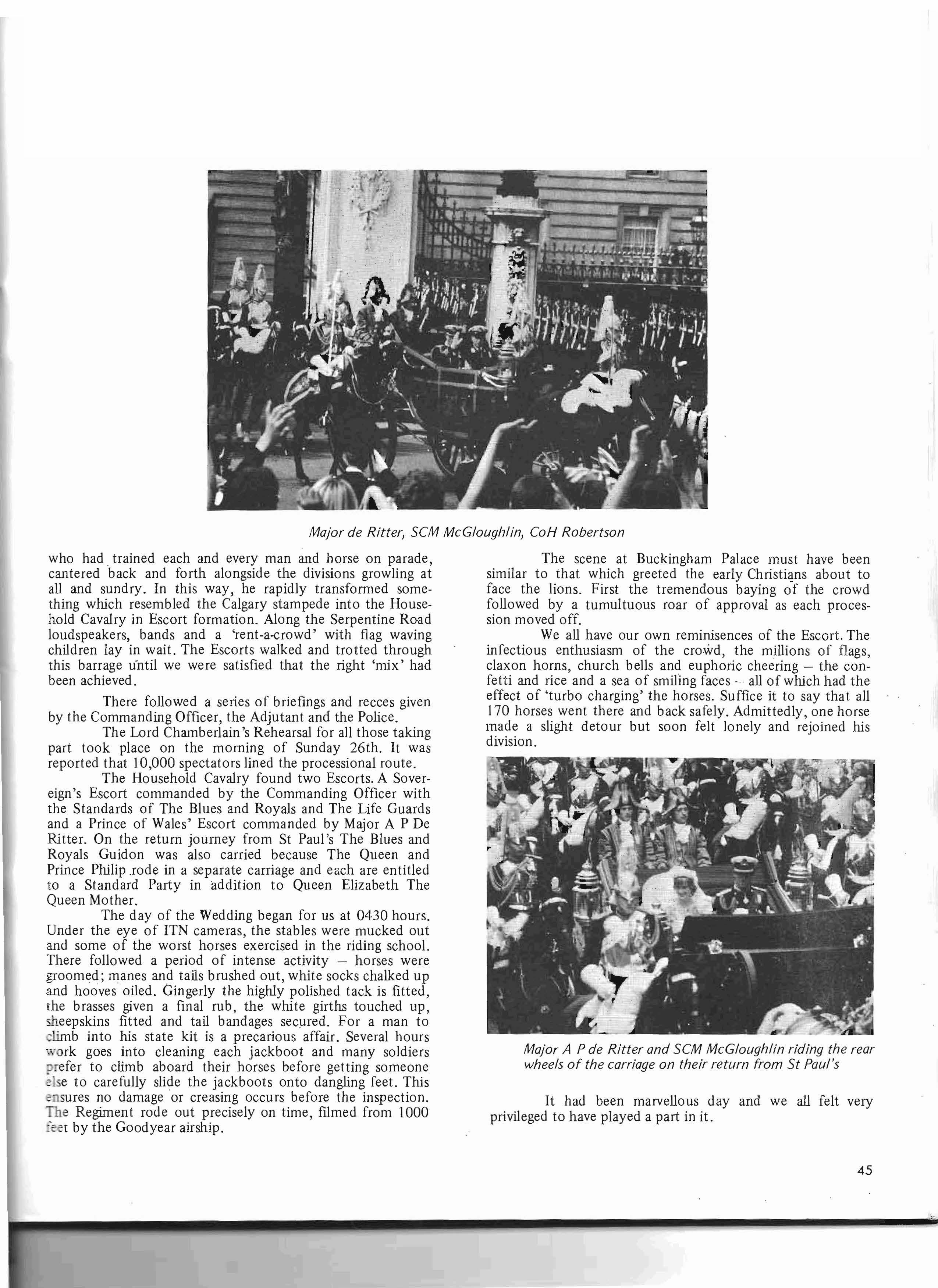
Major A P de Ritter and SCM McGlaughlin riding the rear wheels of the carriage on their return from St Paul's
It had been marvellous day and we all felt very privileged to have played a part in it.

Co arshall, LCoH Blunt, Secretary of State, Col J B Emson, Lt Gen
Lt Col J B Emson, Secretary of State, Military Policeman (who wishes to remain anonymous) Major S V Gilbart-Denham Capt P S W F Fal kner, R C M, CoH Marshall
Above right, above left and bottom left
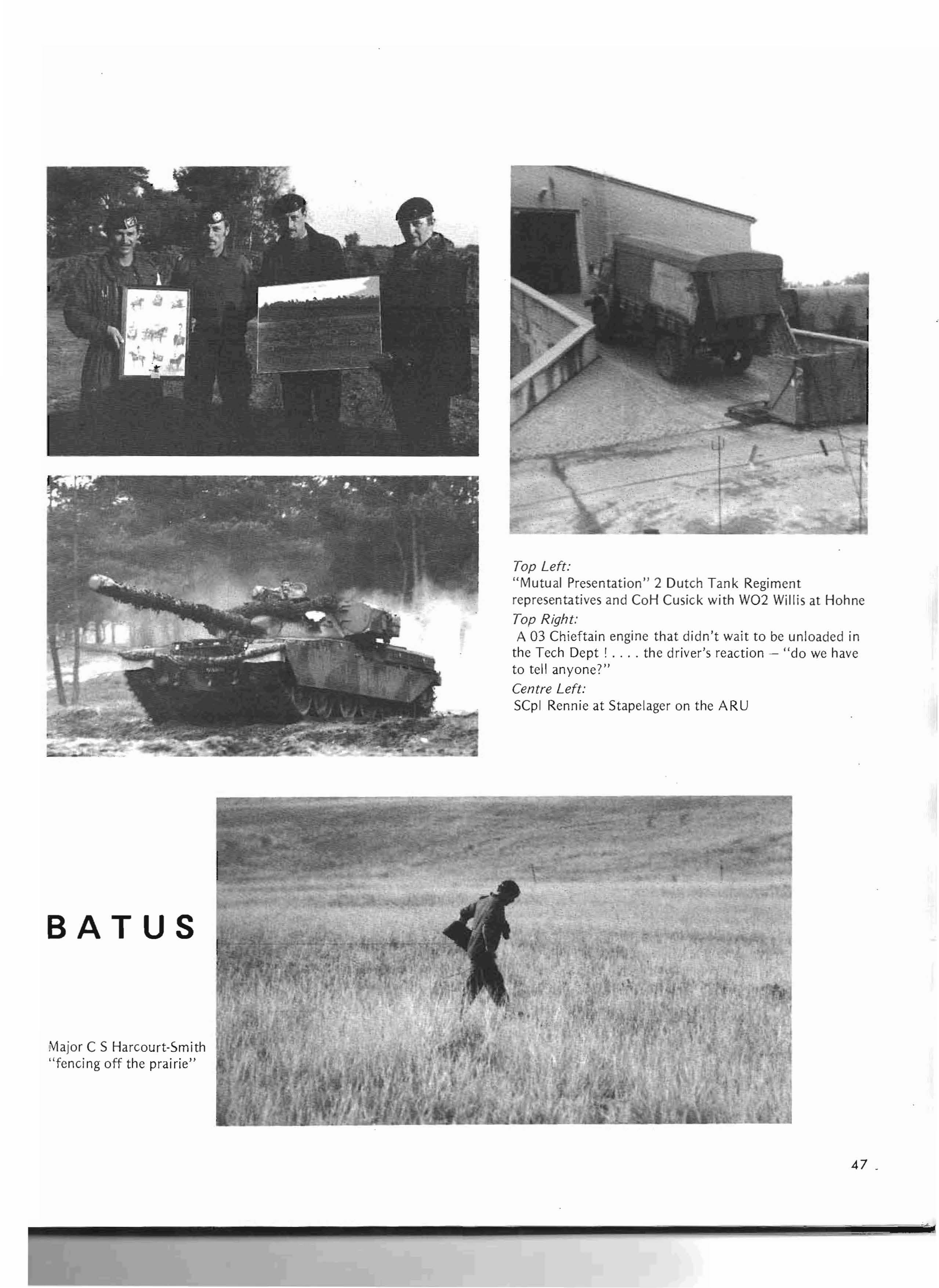
S
Top Left: "Mutual Presentation" 2 Dutch Tank Regiment representatives and CoH Cusick with W02 Willis at Hohne
Top Right: A 03 Chieftain engine that didn't wait to be unloaded in the Tech Dept! .... the driver's reaction - "do we have to tell anyone?"
Centre Left: SCpt Rennie at Stapelager on the ARU
LCoH Hoskins
"Home, home on the range where the pronghorn and rattlesnakes play "
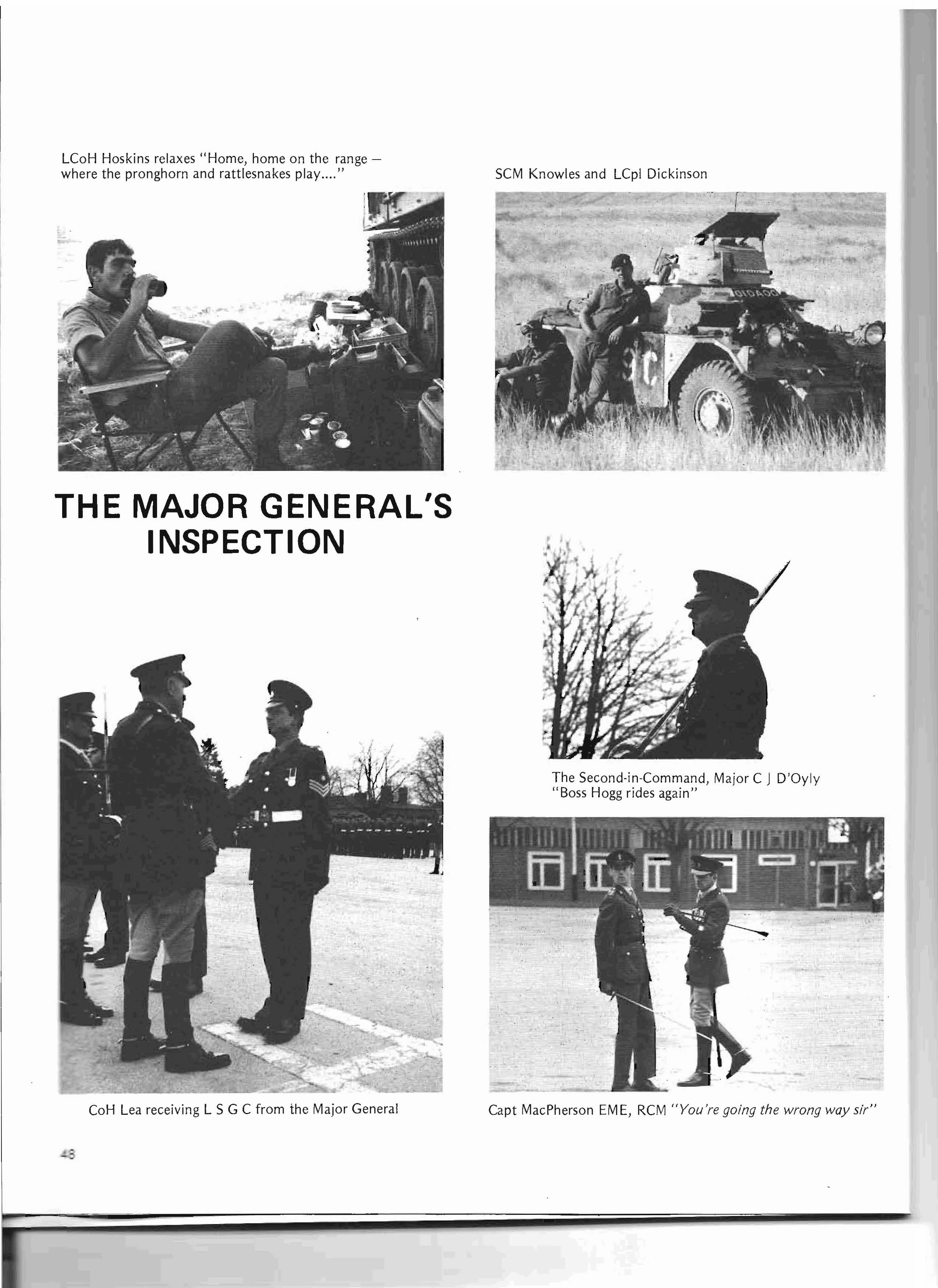
SCM Knowles and LCpl Dickinson
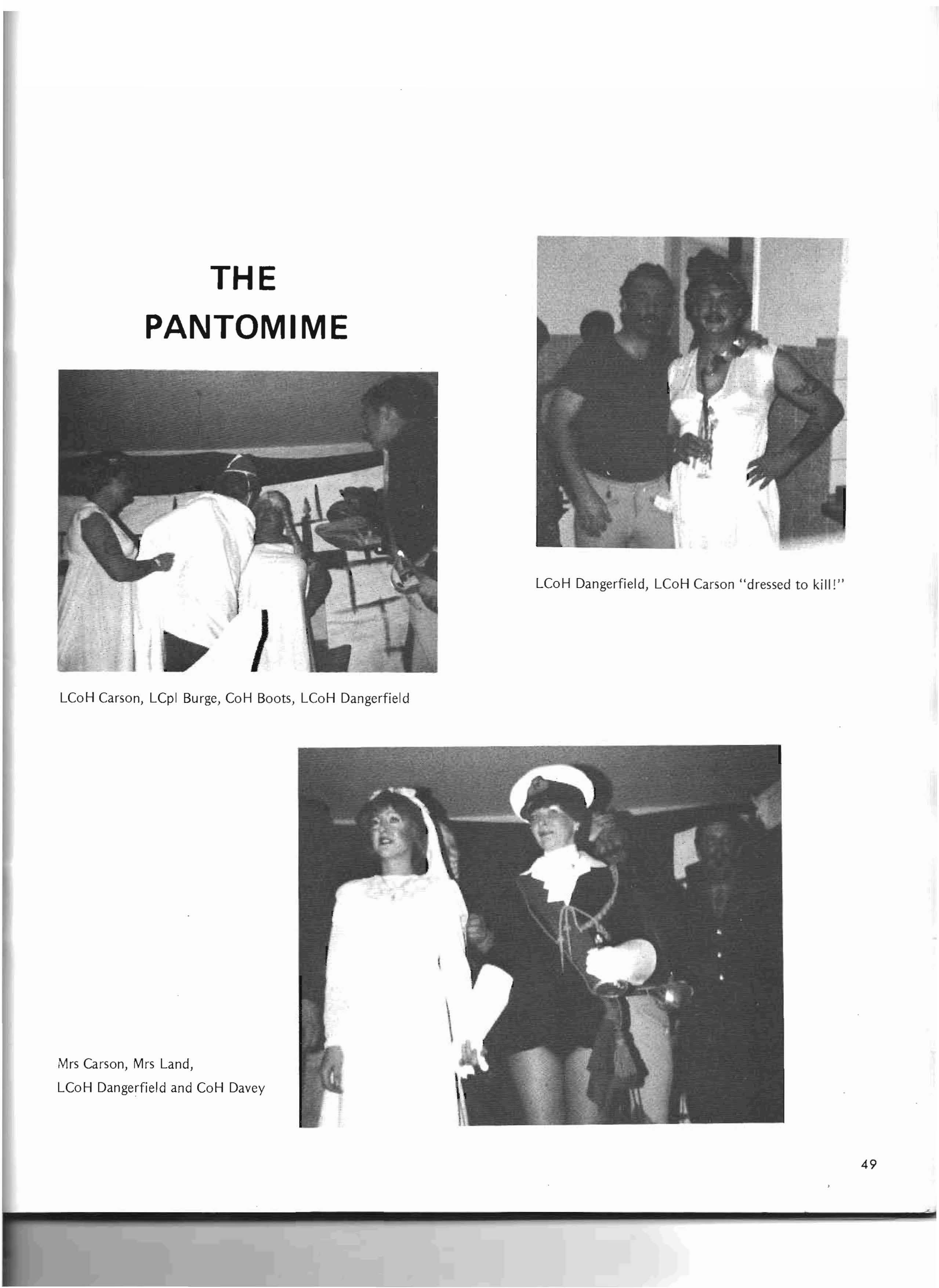
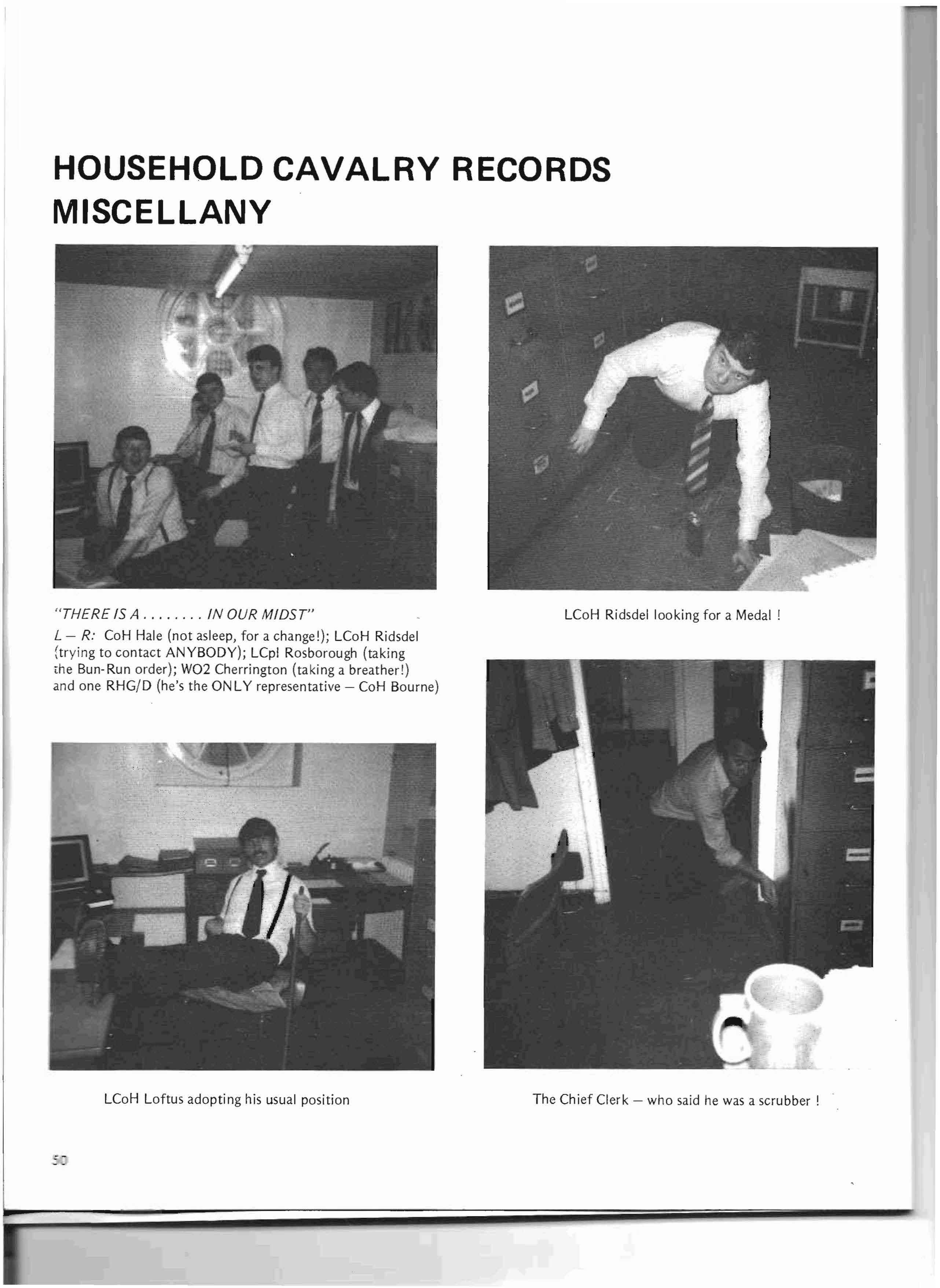
"THERE IS A IN OUR MIDST"
L - R: CoH Hale (not asleep, for a change!); LCoH Ridsdel (trying to contact ANYBODY); LCpl Rosborough (taking ,he Bun-Run order); W02 Cherrington (taking a breather!) and one RHG/D (he's the ON LY representative - CoH Bourne)

Recalled by Mr. Harold Juggins (Regt. No. 4166) who joined 1st Life Guards on 23rd November 1915
Breakfast usually provided porridge followed by liver and bacon or a pair of kippers. The mid-d ay meal contained a "cut off the joint" but from what kind of animal was often a cause of much humorous speculation regarding the probability of it being a joint from one of the horses. Particularly if it were known that a certain horse had been taken from a squadron stable to the sick bay.
At one period 1 had a spell of duty in the "Pharmacy" as the sick bay was called and a very interesting experience it proved to be. I well remember one horse I tended; it was su ffering from "ring worm" and although my ministrations must have been painful to the poor creature, it bore the treatment very patiently and we became quite good friends. But I am getting my story out of sequence and must return to the barrack room, number eleven to be precise.
The room housed thirty troopers and NCO s. The beds were equally divided on either side of the room, and there were windows on each side. On one &ide they overlooked Hyde Park and Rotton Rowand on the other they faced the Barrack Square. In the middle of the room was a long table with bench seating sufficient for all occupants of the room.
Meals were served from one end of the table by a Mess-waiter who doled out the food as fairly as possible. At the time of which I write the mess-waiter was known only by the nick-name "Shipwreck". From which pseudonym I imagined that he had been a victim of a storm at sea or a "U" Boat attack. The real reason, however, was far more prosaic. It appeared that prior to his enlistment in the Life Guards he worked for the Corporation of Slough, in Buckinghamshire. During the course of his employment he was in charge of a water-cart that overturned one day,givinghim a thoroughly good drenching. I have good cause to remember "Shipwreck" as I will explain.
At breakfast one day I stood in the usual queue being served with tea by "Shipwreck". When next-but-one to be served I dropped something on to the floor and stooped to pick it up. At that moment the lad in front of me had been served and I stood up just as "Shipwreck" had a ladle full of near-boiling tea ready for me, in fact it must have been poised above my head. As may be expected the scalding tea went down my back, causing a great blister across my shoulders. Unfortunately the MO did not at first consider the injury sufficient to excuse me from duty. Of those duties, grooming caused most pain and after a few days of severe suffering I was obliged to see the MO again and was excused all duties for about ten days, during which time I did a lot of reading and painting little pictures for my pals.
It was just about the time that I was pronounced fit for full duty that I was detailed for my first riding lesson in the large Riding School attached to the Barracks. This was, of course, the great moment for which I had been waiting and I entered the school with mosf pleasurable anticipation of equestrian delights in store. Little did I realise that these high hopes were to be so quickly dispelled.
Although I had always thought of horses as being creatures well worthy of man's highest esteem I knew next to nothing about their peculiarities. For instance, I did not realise that their muscular actions vary a great deal and that while most horses trot with what may be considered as a "jog-trot ", there are some that move with a rolling motion similar to the movement of a cow and for that reason are
known as "cow-trotters". This variation is of little consequence when a rider has acquired sufficient strength of leg muscles to firmly grip the horse, but without that grip, and riding either "bare back" or with saddle minus stirrups, the beginner suffers badly from that rolling motion.
Well!, it so happened that my first ride was made on a "cow-trotter" and before the end of the lesson my backside became extremely sore and I could feel that my pants were sticking to my flesh. When I staggered to my barrack room bed and removed my clothes I found that the dampness was not just perspiration - but blood.
When I confided my trouble to an older soldier he informed me that the finest way to deal with it was to go to the cookhouse, get some salt and thoroughly rub the salt into the sores. This treatment may have been good but it was excruciatingly pain ful and I was obliged to report to the MO again. On this occasion the doctor was very sympathetic and excused me from attendance at the Riding School until he pronounced me fit for further training.
Now that was fine and all would have been well had the riding instructors had enough common sense to put me into a new "ride" or class. Instead of which I was detailed for the original ride which, by this time, had progressed to the jumping stage. So on my second entry into the School I faced a row of three jumps. As could have been expected I was shaken off the horse at the first jump but this did not deter the horse from tackling the other two with me hanging by one foot in a stirrup.
When considering the episode fifty-five years later, I can scarcely believe it could be possible. However, when the horse was halted by the attendant the Riding Master called me over to him and said "Young man, do you realise you ought to thank God you are still alive'''. In reply I managed to gasp out a feeble "Yes sir" and I really did feel thankful to get out of that incident with no more than some severe bruises. Following that very unsettling (in more ways than one!) experience I was put back into a beginners class and was able to make a fresh start.
In the new "ride" I encountered some amusing situations. On one occasion I slipped sideways on the saddle, thus pressing my right heel into the horse's flank, which was a signal to the horse to turn in a circle, which it promptly did and round and round we went in the middle of the riding school. "Halt the Ride" bellowed the instructor "and watch this bloody fool do his circus act". When, after several full circles, I managed to make the horse stand still, the instructor, an Irishman named Patsy Burke, shouted out "And Phats yure name?" and on hearing me state that which he already knew he yelled "And you are a bloody muggins too!" To do him justice I am sure he really meant what he said but one day Patsy came into Number eleven room when I was doing a few conjuring tricks for my mates. As he watched me perform, his face was a real study. His mouth opened and a look of sheer bewilderment spread across his typically Irish face. ObViously he was amazed that the "bloody muggins" should show signs of real intelligence. After that Patsy Burke was as "nice as pie" to me in the school.
On 19th January 1957, the Gold Stick Colonel of The Life Guards was buried after a funeral service in St George's Chapel, Windsor. He was in many ways unique in being one of the few Colonels of The Life Guards who had served in the Regiment and the only one to have served Regimentally in the 2nd Life Guards continuing to be Colonel of The Life Guards and Gold Stick after the amalgamation of 1st and 2nd Regiments in 1922.
His father, HSH Prince Francis ofTeck, was a descendant of the old Hungarian Royal family, albeit the family name of Teck was borne by himself and his sister, Queen Mary and is in fact, a small German Dukedom near to Stuttgart.
He was born at Kensington Palace 14th April 1874. The famiJy changed their name, as did the remainder of the Royal family in 1917. He had served in South Africa and during the 1st World War and was Governor General of South Africa from 1923 to 1931 and of Canada from 1940 to 1946.
He was appointed Goldstick of The Life Guards in 1936 and his wife, Princess Alice, who died in 1981, was the last surviving grandchild of Queen Victoria. The only other Royal Gold Sticks were, the Duke of Monmouth, Prince Edward of Saxe Weimar and Lord Mountbatten.
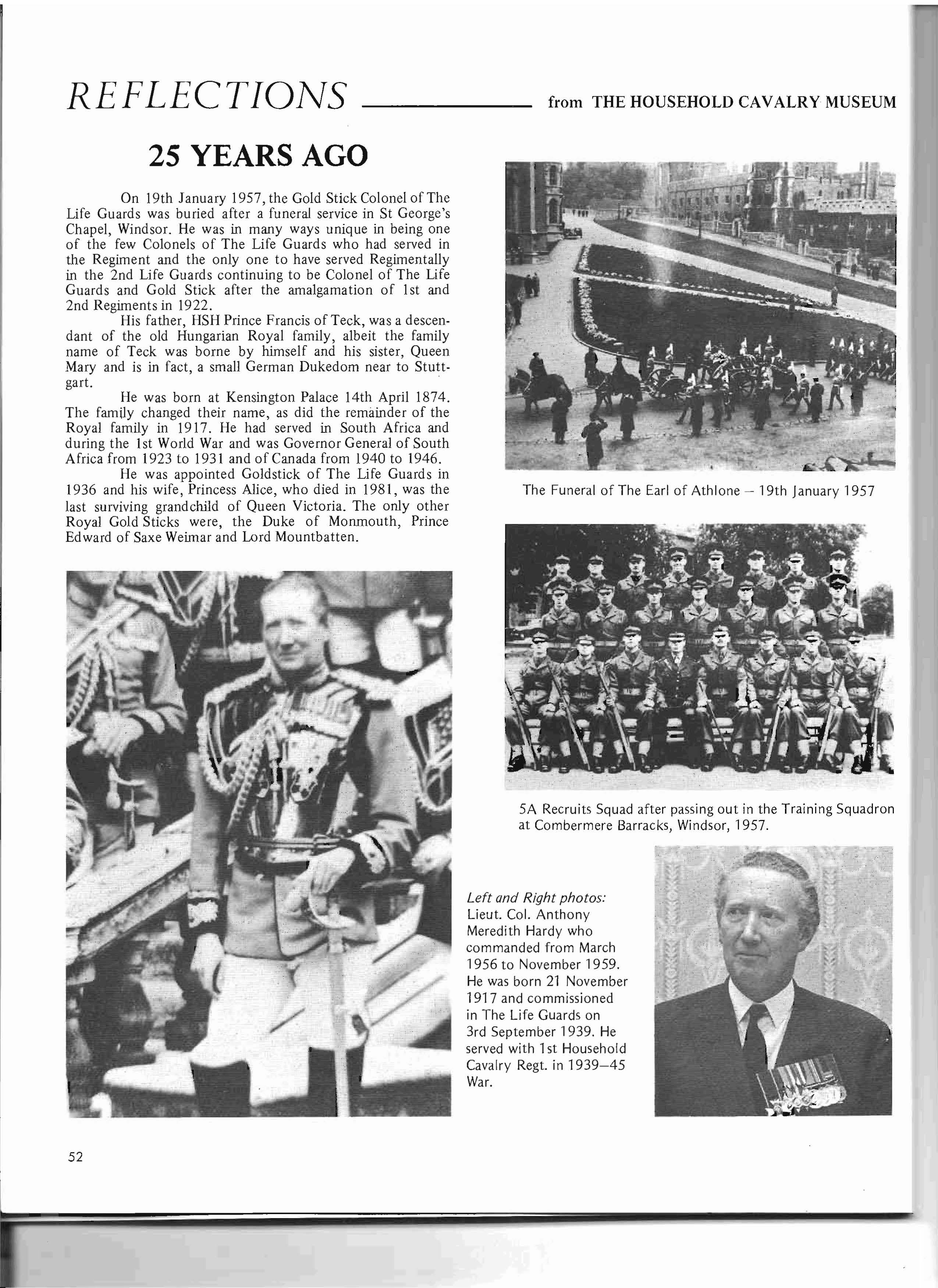
SA Recruits Squad after passing out in the Training Squadron at Combermere Barracks, Windsor, 1957.
Left and Right photos: Lieut. Col. Anthony Meredith Hardy who commanded from March 1956 to November 1959. He was born 21 November 1917 and commissioned in The Life Guards on 3rd September 1939. He served with 1 st Household Cavalry Regt. in 1939-45 War.
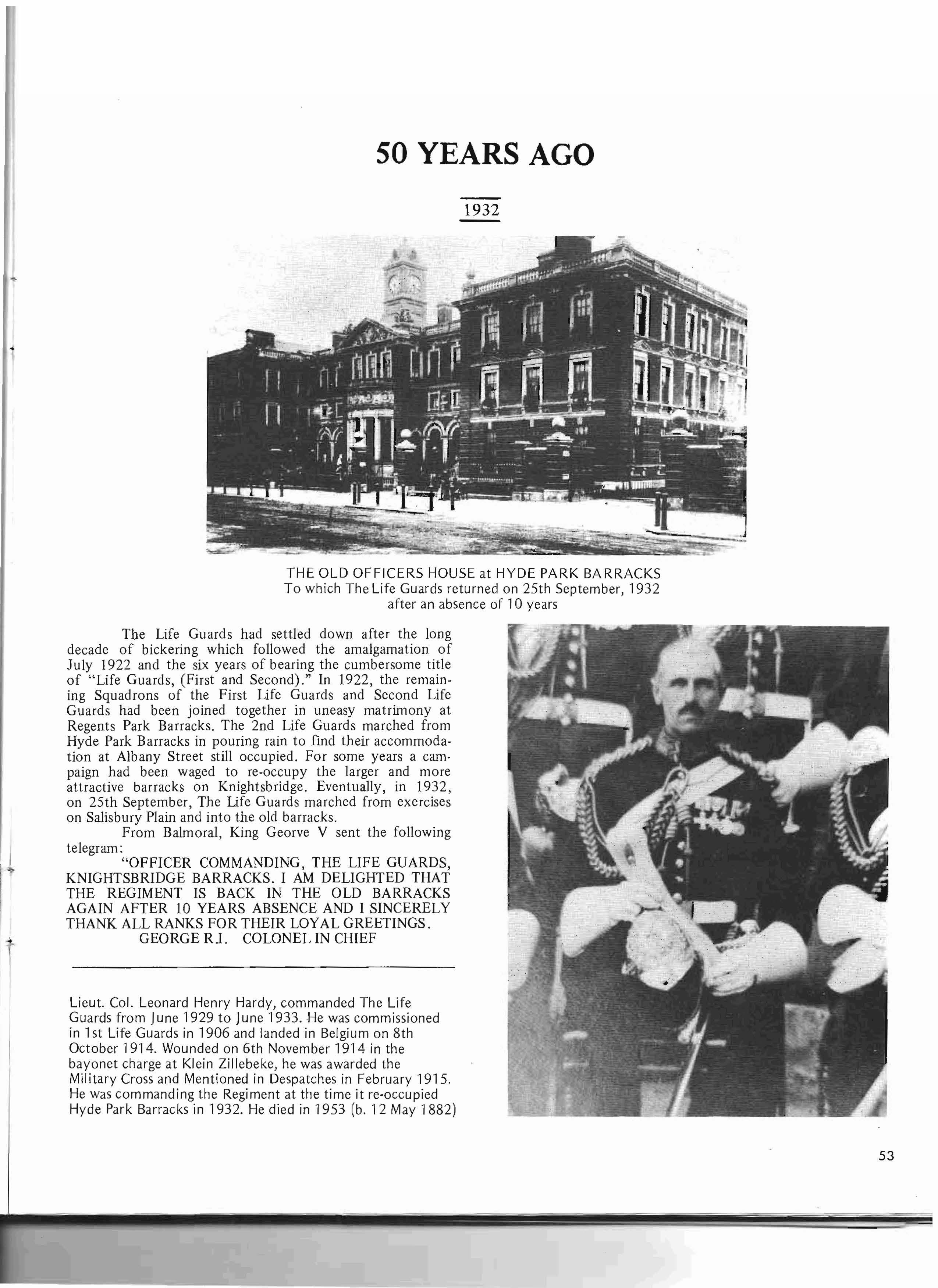
THE OLD OFFICERS HOUSE at HYDE PARK BARRACKS
To which The Life Guards returned on 25th September, 1932 after an absence of 10 years
The Life Guards had settled down after the long decade of bickering which followed the amalgamation of July 1922 and the six years of bearing the cumbersome title of "Life Guards, (First and Second)." In 1922, the remaining Squadrons of the First Life Guards and Second Life Guards had been joined together in uneasy matrimony at Regents Park Barracks. The 2nd Life Guards marched from Hyde Park Barracks in pouring rain to find their accommodation at Albany Street still occupied. For some years a campaign had been waged to re-occupy the larger and more attractive barracks on Knightsbridge. Eventually, in 1932, on 25th September, The Life Guards marched from exercises on Salisbury Plain and into the old barracks.
From Balmoral, King Georve V sent the following telegram:
"OFFICER COMMANDING, THE LIFE GUARDS, KNIGHTSBRIDGE BARRACKS. I AM DELIGHTED THAT THE REGIMENT IS BACK IN THE OLD BARRACKS AGAIN AFTER 10 YEARS ABSENCE AND I SINCERELY THANK ALL RANKS FOR THEIR LOYAL GREETINGS.
GEORGE R.I. COLONEL IN CHIEF
Lieut. Col. Leonard Henry Hardy, commanded The Life Guards from June 1929 to June 1933. He was commissioned in 1 st Life Guards in 1906 and landed in Belgium on 8th October 1914. Wounded on 6th November 1914 in the bayonet charge at Klein Zillebeke, he was awarded the Mil itary Cross and Mentioned in Despatches in February 1915. He was commanding the Regiment at the time it re-occupied Hyde Park Barracks in 1932. He died in 1953 (b. 12 May 1882)
In 1875, the British Prime Minister, Benjamin D'lsraeli, acquired on behalf of the nation the Khedive of Egypt's shares in the newly built Suez Canal, making Britain co-partners with France in the ownership of this new gate-way to our vast Eastern Empire. The 'Union Jack' flew over one quarter of the up to then explored world, although the population of Britain was less than 30 million.
Gladstone was Prime Minister and D'lsraeli was dead in 1881, when Colonel Arabi Pasha led the Egyptian Army in a revolt against the Khedive and 'foreign influence in Egyptian affairs',
In the normal course of events, France would have shared with Britain the responsibility for the safety of the vital Suez Canal. France was, however still wary of Prussia which had totally subjugated the French in the FrancoPrussian War of 1870 and France was not prepared to embark in any military ventures outside Europe.
The rebellious Egyptian army occupied Alexandria in the summer of 1882 and Gladstone sent the Royal Navy to mount a massive bombardment on Alexandria on 9th July 1882.
The British Army, 'streamlined' after the Cardwell reforms, and from which 'flogging' had been abolished, Was alerted. The Household Cavalry, which had last been in action at Waterloo, and which had never fought outside Europe, was ordered to be in a state of readiness for service in Eygpt two days before the naval bombardment of Alexandria. One Squadron of each of the three Regiments, (First and Second Life Guards and the Blues) was formed into the Household Cavalry Composite Regiment of Household Cavalry, commanded by Lieut Colonel Henry ("Croppy") Ewart of the 2nd Life Guards. The HCR was part of a force of 17,000 men assembled in England for transport by steamships to Egypt. On 31st July 1882 the 1st Life Guard Squadron and the Blues were inspected by the Colrimel in Chief, the Prince of Wales at Regents Park Barracks. On the following day, the 2nd Life Guard Squadron were also inspected at the Albany Street Barracks. Before the Squadrons embarked at
the Albert Docks, Woolwich, the Prince of Wales gave dinner to the Officers at the Marlborough Club.
The three Squadrons sailed on the 1st and 2nd August in SS Holland and SS Cantabria and disembarked at Alexandria on 13th August to re-embark for Ismailia on 19th August, where they disembarked 22nd and 23rd August 1882.
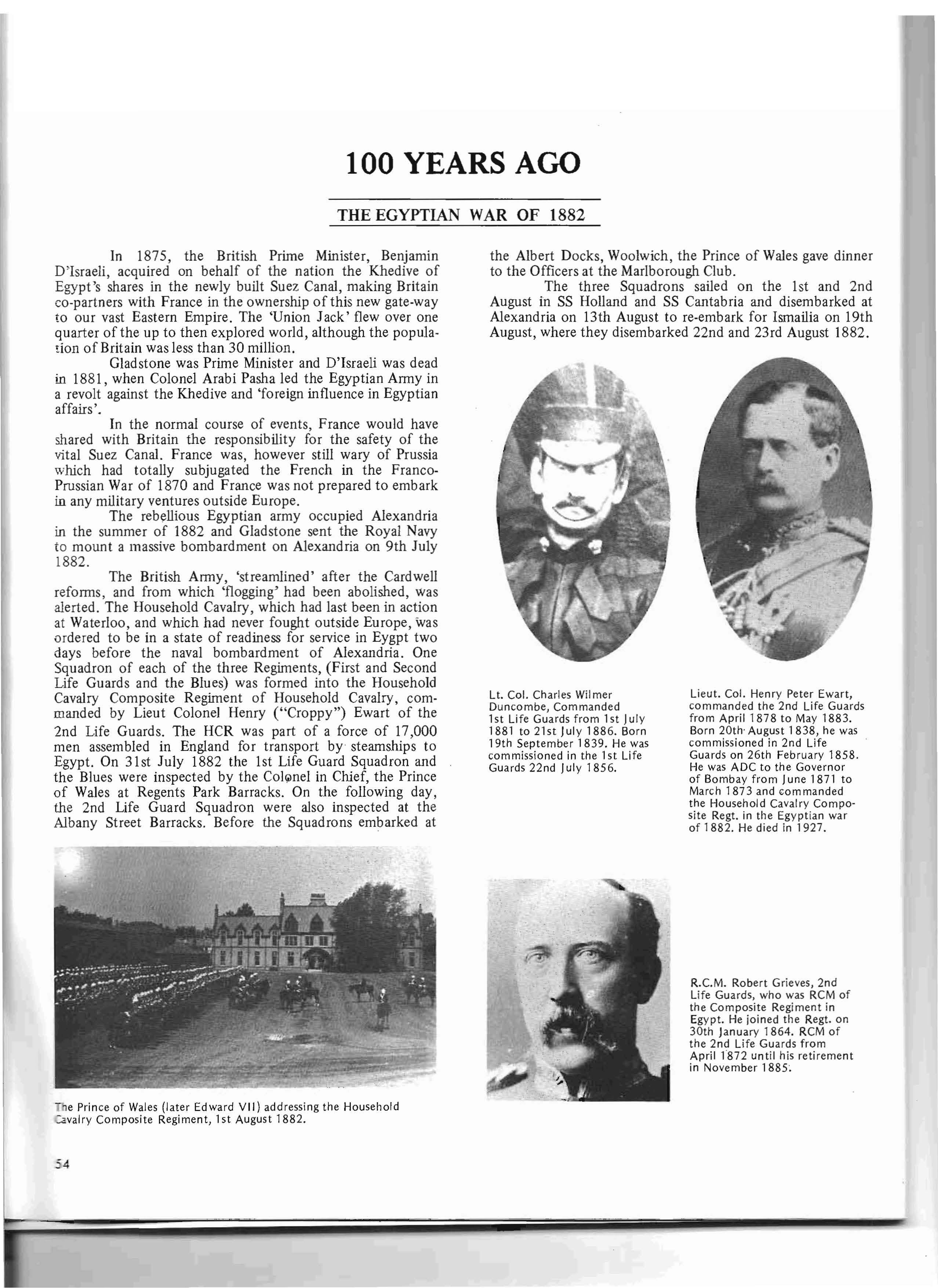
Lt. Col. Charles Wil mer Lieut. Col. Henry Peter Ewart, Duncombe, Commanded commanded the 2nd Life Guards 1st Life Guards from 1st July from April 1878 to May 1883. 1881 to 21st July 1886. Born Born 20th, August 1838, he was 19th September 1839. He was commissioned in 2nd Life commissioned in the 1 st Life Guards on 26th February 1858. Guards 22nd July 1856. He was ADC to the Governor of Bombay from June 1871 to March 1873 and commanded the Household Cavalry Composite Regt. in the Egyptian war of 1882. He died in 1927.
R.C.M. Robert Grieves, 2nd Life Guards, who was RCM of the Composite Regiment in Egypt. He joined the Regt. on 30th January 1864. RCM of the 2nd Life Guards from April "872 until his retirement in November 1885'.
T.C.P. Calley, Lord Rodney, Surg.
Hamilton; Lt. Col. Hon. R.A.P. Talbot; Major C. Needham;
Lieut. H. Gerard Leigh; Captain Sir Simon Lockhart.
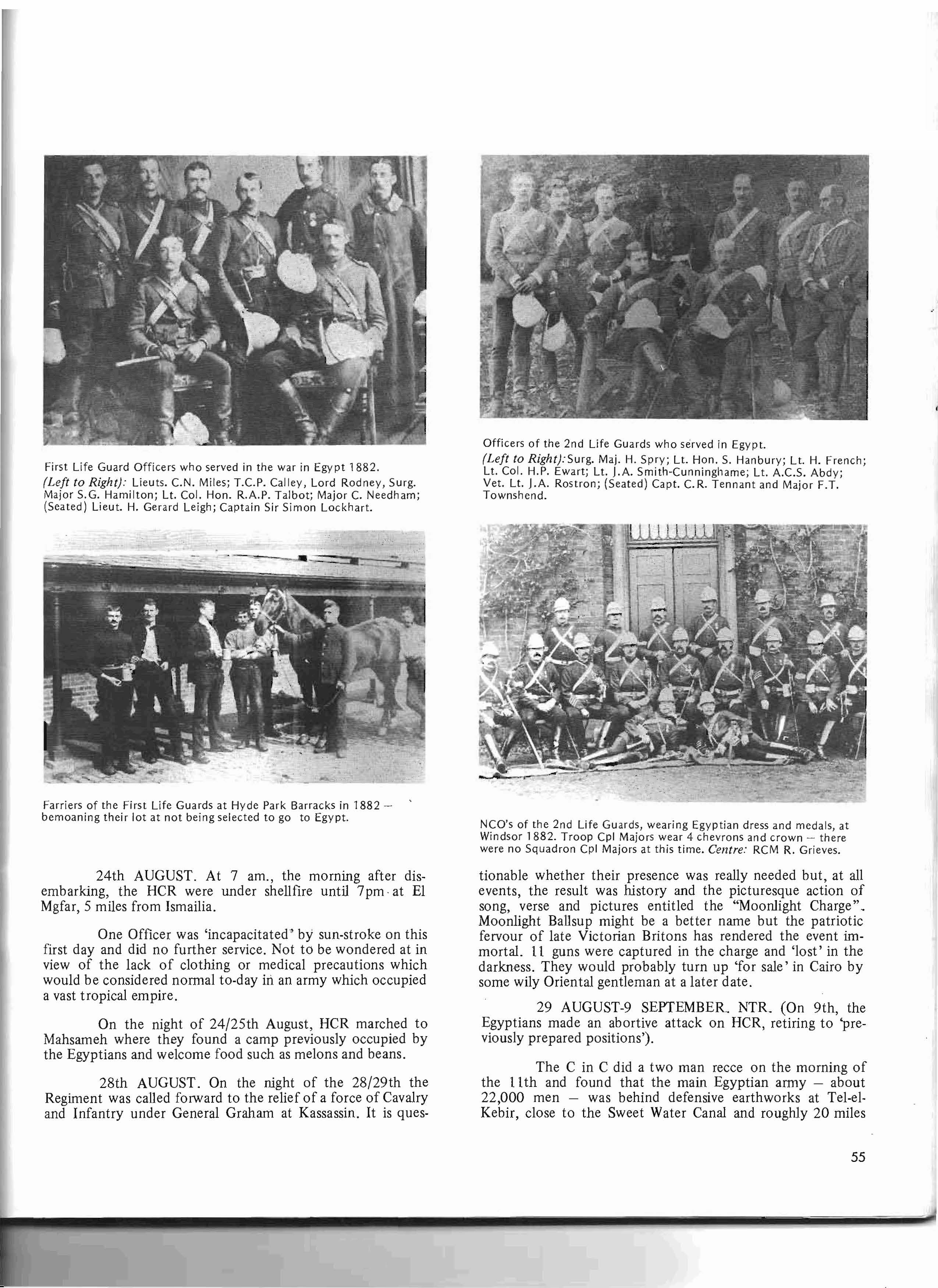
Farriers of the First Life Guards at Hyde Park Barracks in 1882 bemoaning their lot at not being selected to go to Egypt.
24th AUGUST. At 7 am., the morning after disembarking, the HCR were under shellfire until 7pm· at EI Mgfar, 5 miles from Ismailia.
One Officer was 'incapacitated" by sun-stroke on this first day and did no further service. Not to be wondered at in view of the lack of clothing or medical precautions which would be considered normal to-day iIi. an army which occupied a vast tropical empire.
On the night of 24/25th August, HCR marched to Mahsameh where they found a camp previously occupied by the Egyptians and welcome food such as melons and beans.
28th AUGUST. On the night of the 28/29th the Regiment was called forward to the relief of a force of Cavalry and Infantry under General Graham at Kassassin. It is ques-
Officers of the 2nd Life Guards who served in Egypt. (Left to Right):Surg. Maj. H. Spry; Lt. Han. S. Hanbury; Lt. H. French; Lt. Col. H.P. Ewart; Lt. J.A. Smith-Cunninghame; Lt. A.C.S. Abdy; Vet. Lt. J.A. Rostron; (Seated) Capt. C.R. Tennant and Major F.T. Townshend.
NCO's of the 2nd Life Guards, wearing Egyptian dress and medals, at Windsor 1882. Troop Cpl Majors wear 4 chevrons and crown - there were no Squadron Cpl Majors at this time. Centre: RCM R. Grieves.
tionable whether their presence was really needed but, at all events, the result was history and the picturesque action of song, verse and pictures entitled the "Moonlight Charge". Moonlight Ballsup might be a better name but the patriotic fervour of late Victorian Britons has rendered the event immortal. 11 guns were captured in the charge and 'lost' in the darkness. They would probably turn up 'for sale' in Cairo by some wily Oriental gentleman at a later date.
29 AUGUST-9 SEPTEMBER. NTR_ (On 9th, the Egyptians made an abortive attack on HCR, retiring to 'preViously prepared positions').
The C in C did a two man recce on the morning of the 11th and found that the main Egyptian army - about 22,000 men - was behind defensive earthworks at Tel-elKebir, close to the Sweet Water Canal and roughly 20 miles
from Cairo. The recce disclosed the important military information that whilst the wily Oriental gentlemen had sentries on the earthworks by day, they all retired for a well earned kip at night and mounted guard again at dawn. With this useful bit of inside info the C in C, (General Wolseley) prepared his entire fOice to make a night march followed by a dawn attack on the 13th.
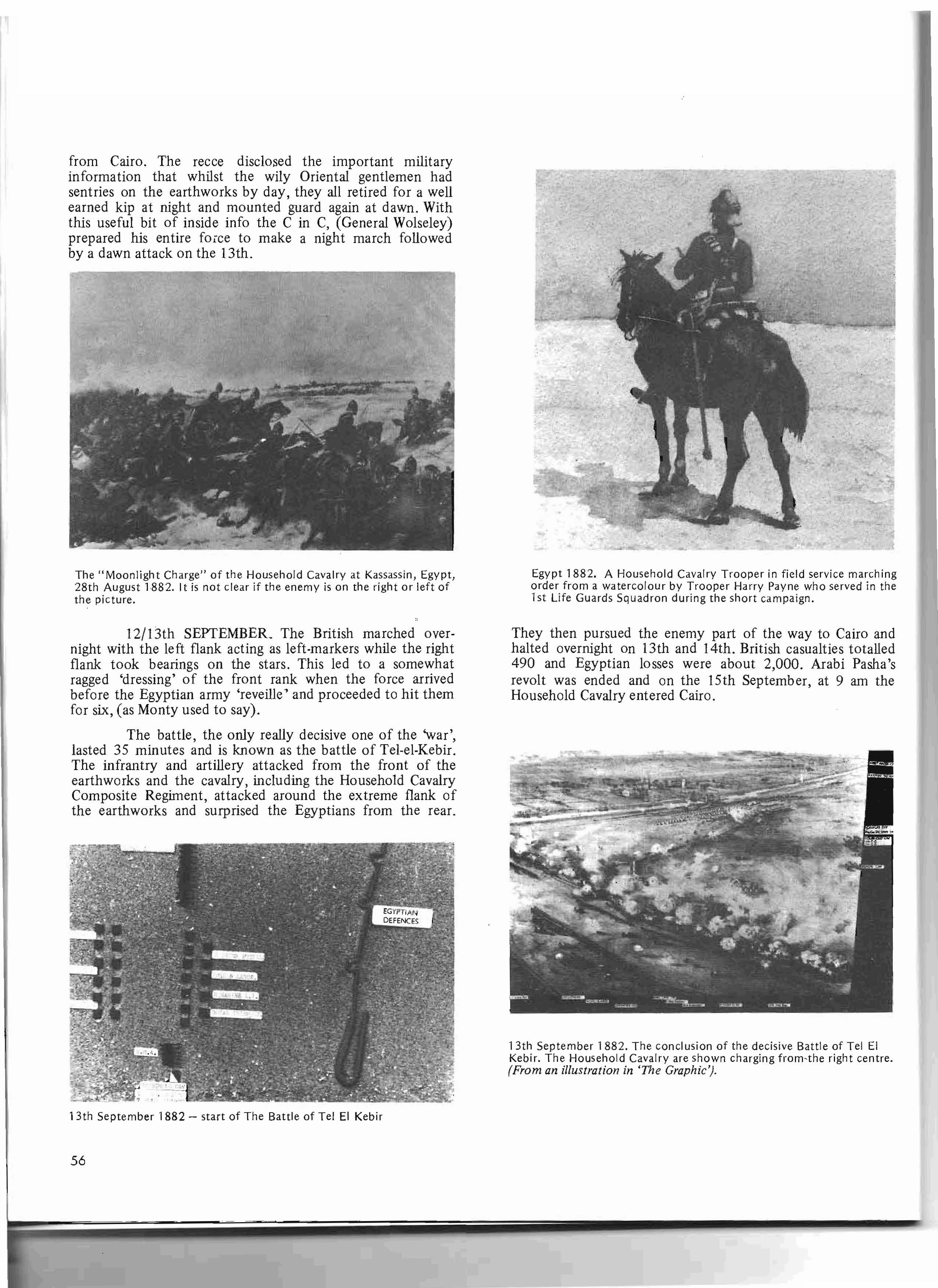
The "Moonlight Charge" of the Household Cavalry at Kassassin, Egypt, 28th August 1882. It is not clear if the enemy is on the right or left of the picture.
12/13th SEPTEMBER. The British marched overnight with the left flank acting as left·markers while the right flank took bearings on the stars. This led to a somewhat ragged 'dressing' of the front rank when the force arrived before the Egyptian army 'reveille' and proceeded to hit them for six, (as Monty used to say).
The battle, the only really decisive one of the 'war', lasted 35 minutes and is known as the battle of Tel·el-Kebir. The infrantry and artillery attacked from the front of the earthworks and the cavalry, including the Household Cavalry Composite Regiment, attacked around the extreme flank of the earthworks and surprised the Egyptians from the rear.
They then pursued the enemy part of the way to Cairo and halted overnight on 13th and 14th. British casualties totalled 490 and Egyptian losses were about 2,000. Arabi Pasha's revolt was ended and on the 15th September, at 9 am the Household Cavalry entered Cairo.
On 4th and 5th October 1882, the 1st and 2nd Life Guards entrained at Cairo for Alexandria, sailing from there on 6th October and disembarking at the South West India Dock on 19th October.
The Squadrons of Household Cavalry were acclaimed with wild enthusiasm on their return to London and Windsor and some members of the Regiment received their silver Egyptian medals from Her Majesty in person.
The bronze "Khedive Star'. was not awared until March 1883.
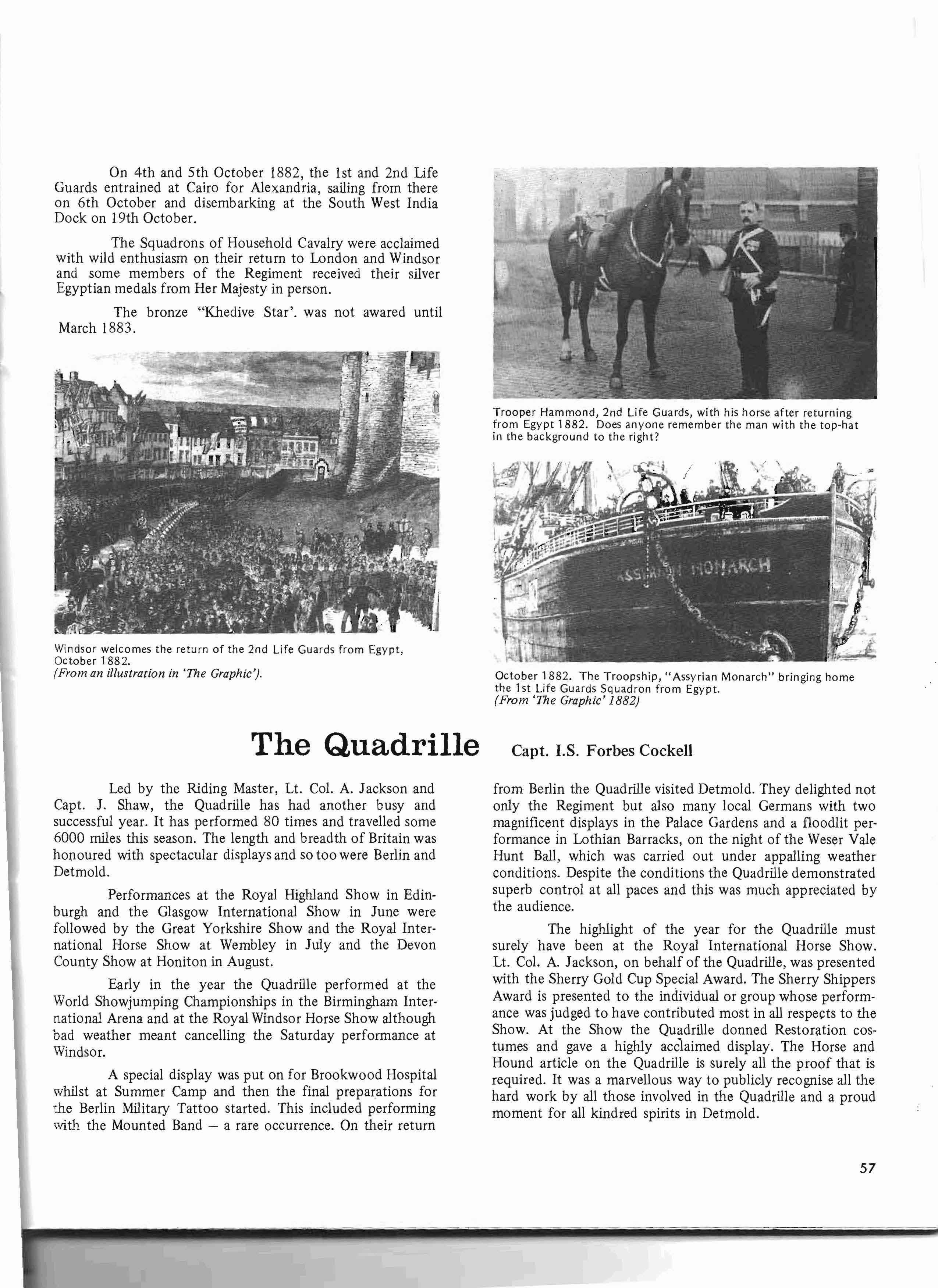
Windsor welcomes the return of the 2nd Life Guards from Egypt, October 1882.
(From an illustration in 'The Graphic').
Led by the Riding Master, Lt. Col. A. Jackson and Capt. J. Shaw, the Quadrille has had another busy and successful year. It has performed 80 times and travelled some 6000 miles this season. The length and breadth of Britain was honoured with spectacular displays and so too were Berlin and Detmold.
Performances at the Royal Highland Show in Edinburgh and the Glasgow International Show in June were followed by the Great Yorkshire Show and the Royal International Horse Show at Wembley in July and the Devon County Show at Honiton in August.
Early in the year the Quadrille performed at the World Showjumping Championships in the Birmingham International Arena and at the Royal Windsor Horse Show although bad weather meant cancelling the Saturday performance at Windsor.
A special display was put on for Brookwood Hospital whilst at Summer Camp and then the final preparations for me Berlin Military Tattoo started. This included performing ,vith the Mounted Band -a rare occurrence. On their return
from Berlin the Quadrille visited Detmold. They delighted not only the Regiment but also many local Germans with two magnificent displays in the Palace Gardens and a floodlit performance in Lothian Barracks, on the night of the Weser Vale Hunt Ball, which was carried out under appalling weather conditions. Despite the conditions the Quadrille demonstrated superb control at all paces and this was much appreciated by the audience.
The highlight of the year for the Quadrille must surely have been at the Royal International Horse Show. Lt. Col. A. Jackson, on behalf of the Quadrille, was presented with the Sherry Gold Cup Special Award. The Sherry Shippers Award is presented to the individual or group whose performance was judged to have contributed most in all respects to the Show. At the Show the Quadrille donned Restoration costumes and gave a highly acc"laimed display. The Horse and Hound article on the Quadrille is surely all the proof that is required. It was a marvellous way to publicly recognise all the hard work by all those involved in the Quadrille and a proud moment for all kindred spirits in Detmold.
Tpr HARVEY ROY FROGGETT died tragically on 8th July 1981 as a result of a motor cycle accident near Detmo1d on 1st June 1981.
He joined the Regiment in January 1980 and after recruit training at the Guards Depot joined C Squadron in Germany in November 1980. He spent most of his time as a Chieftain Driver in 2 Troop where he quickly became a popular and active member
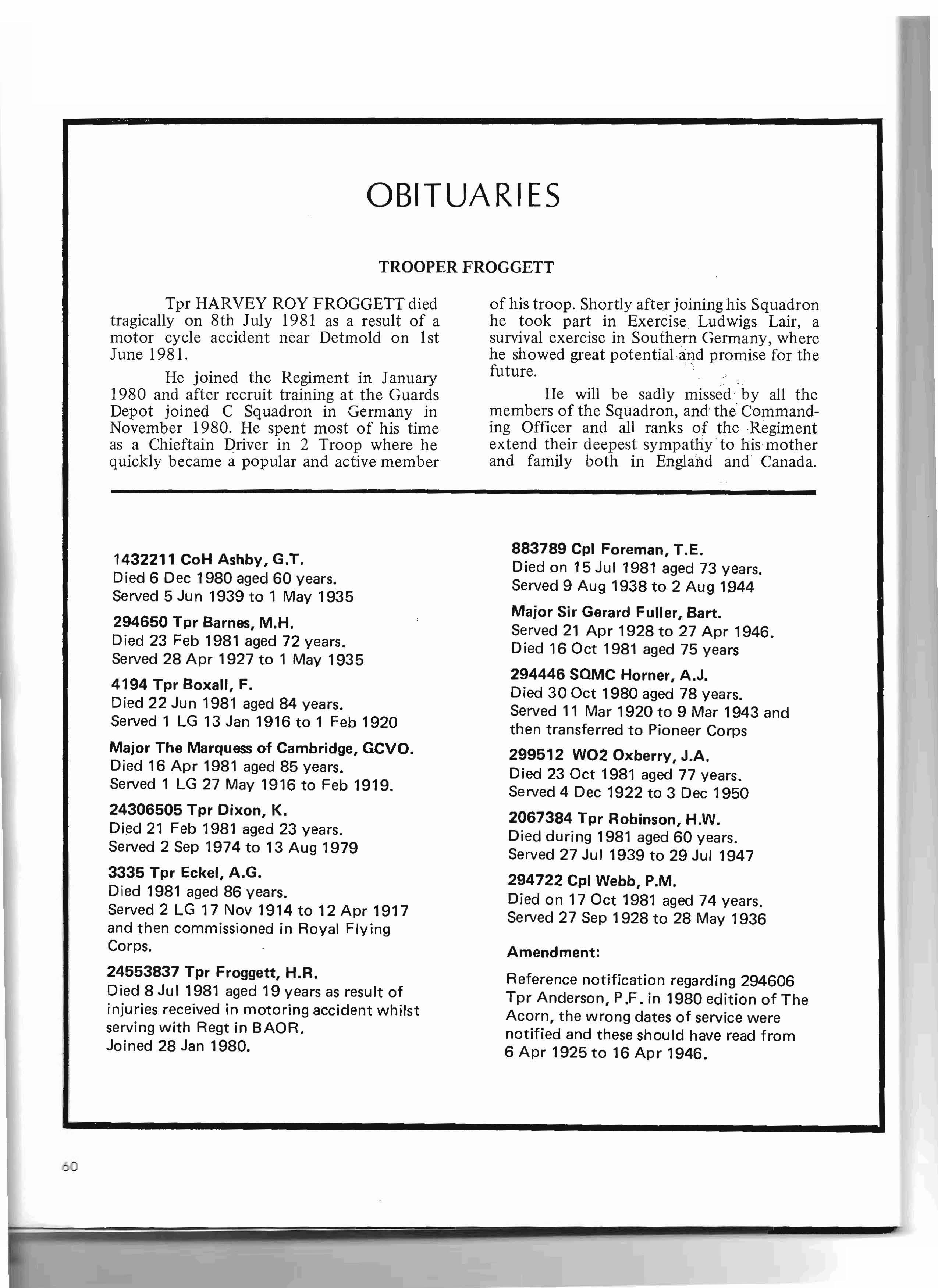
1432211 CoH Ashby, G.T.
Died 6 Dec 1980 aged 60 years.
Served 5 Jun 1939 to 1 May 1935
294650 Tpr Barnes, M.H.
Died 23 Feb 1981 aged 72 years.
Served 28 Apr 1927 to 1 May 1935
4194 Tpr Boxall, F.
Died 22 Jun 1981 aged 84 years.
Served 1 LG 13 Jan 1916 to 1 Feb 1920
Major The Marquess of Cambridge, GCVO.
Died 16 Apr 1981 aged 85 years.
Served 1 LG 27 May 1916 to Feb 1919.
24306505 Tpr Dixon, K.
Died 21 Feb 1981 aged 23 years.
Served 2 Sep 1974 to 13 Aug 1979
3335 Tpr Eckel, A.G.
Died 1981 aged 86 years.
Served 2 LG 17 Nov 1914 to 12 Apr 1917 and then commissioned in Royal Flying Corps.
24553837 Tpr Froggett, H.R.
Died 8 Jul 1981 aged 19 years as result of injuries received in motoring accident whilst serving with Regt in SAaR. Joined 28 Jan 1980.
of his troop. Shortly after joining his Squadron he took part in Exercise Ludwigs Lair, a survival exercise in Southern Germany, where he showed great potential and promise for the future. . .
He will be sadly missed by all the members of the Squadron, and the Commanding Officer and all ranks of the Regiment extend their deepest sympathy to his mother and family both in England and Canada.
883789 Cpl Foreman, T.E.
Died on 15 Jul 1981 aged 73 years. Served 9 Aug 1938 to 2 Aug 1944
Major Sir Gerard Fuller, Bart.
Served 21 Apr 1928 to 27 Apr 1946.
Died 16 Oct 1981 aged 75 years
294446 SOMC Horner, A.J.
Died 30 Oct 1980 aged 78 years. Served 11 Mar 1920 to 9 Mar 1943 and then transferred to Pioneer Corps
299512 W02 Oxberry, J.A.
Died 23 Oct 1981 aged 77 years. Served 4 Dec 1922 to 3 Dec 1950
2067384 Tpr Robinson, H.W.
Died during 1981 aged 60 years.
Served 27 Jul 1939 to 29 Jul 1947
294722 Cpl Webb, P.M.
Died on 17 Oct 1981 aged 74 years. Served 27 Sep 1928 to 28 May 1936
Amendment:
Reference notification regarding 294606 Tpr Anderson, P.F in 1980 edition of The Acorn, the wrong dates of service were notified and these should have read from 6 Apr 1925 to 16 Apr 1946.